#only japan has more gold medals than us (and china)!!!
Explore tagged Tumblr posts
Text
The six gold medallists for Australia right now are all women!!!!!!!






From top-left to bottom right:
Grace Brown: Cycling - individual time trial event
Arianne Titmus: Swimming - 400 Freestyle
Mollie O'Callaghan, Shayna Jack, Emma McKeon and Meg Harris: Swimming - 4x100m freestyle
Jess Fox: Canoeing- Slalom K-1
Mollie O’Callaghan: Swimming - 200m Freestyle
Kaylee McKeown: Swimming - 100m Backstroke
#australia#olympics#olympics 2024#ausposting#noting that at this point in time#only japan has more gold medals than us (and china)!!!#a massive feat!!!!
205 notes
·
View notes
Text
2024 Ice Hockey Women's World Championship: A Primer
When: April 3rd to April 14th. The schedule here will tell you when games are taking place both in your local time and venue time.
Where is it taking place?: Utica, New York
Where to watch:
For the first time, we will have ALL games broadcasted in USA and Canada. I am not sure how many games are going to be broadcasted outside North America, but we can reasonably assume they will at least carry their home country games
TSN will carry all games in canada
NHL Network and ESPN+ will carry a mix of the games together. See The Ice Garden's Michelle Jay's tweet for the schedule of which games are where.
SVT (Sweden)
Discovery (Finland)
Czech TV (Czechia)
Magenta (Germany)
TBS (Japan)
Swiss TV (Switzerland)
If you are not in any of these countries, or you are but are struggling to find a way to watch, please feel free to DM me and I will do my best to find you something
What is the tournament format?:
There are two divisions, Division A with the five ranked teams going into the tournament and Division B with the next five. Each division plays a round robin style ranking round, and at the conclusion the bottom two teams in Division B will be relegated, while the rest automatically make the quarterfinals. Quarterfinals will go A1-B3, A2-B2, A3-B1, A4-A5. In addition to the finals for gold that will take place, there will be a bronze medal game and a fifth place game for ranking. Standings will use a three point systems.
Who is in each division?:
Division A: USA, Canada, Czechia, Switzerland, Finland
Division B: Sweden, Japan, Germany, China, Denmark
Who are each teams?
Here is where it gets long. Below the cut I will tell you each teams roster, how they did last year, their reasonable goals, notable roster changes, and three players to watch. I will do my best to keep this informative, but brief.
USA
Roster:

(Text version available here)
2023 Result: Won Gold
2024 goals: Win gold again
Notable roster changes: This team continues to go very very young. Abby Roque is the most notable roster omission here. Top defender Lee Stecklein is also not on this roster, due to her taking a break from the National Team. Amanda Kessel was also left off, but she has not been active within the last year as a player, so not entirely surprising.
Three players to watch: Grace Zumwinkle has been one of the stars of the PWHL so far, and is likely to get more responsibility on the national team than ever before, so keep an eye on her and how she may translate her successful season to the tournament. Rory Guilday may only be 21, but she is heading to her third senior world championships, a long time favorite of the team USA coaching staff with her shutdown defensive skills who they'll hope can take another step this tournament with Lee Stecklein absent. Joy Dunne is the youngest player on this roster, just 18 years old coming off a 24-18-42 season in Ohio and a national championship. This will be her first senior level tournament, and I'd expect her to get ample offensive opportunities.
Canada
Roster
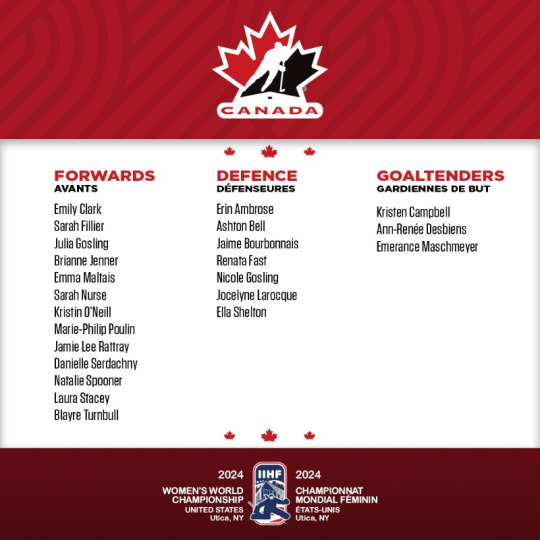
(text version available here)
2023 result: Silver
2024 goals: Gold
Notable roster changes: Micah Zandee-Hart is the most surprising one after being on the roster for a few years. Claire Thompson is absent as is Rebecca Johnston, but that is more expected while Thompson is finishing medical school and Johnston has not played in the past calendar year. Cousins Nicole and Julia Gosling join the team after strong rivalry series showings.
Three players to watch: Natalie Spooner is the front runner for PWHL MVP, so everyone will be watching to see if she continues to score at the rate she has been. Expected number one overall pick in the upcoming PWHL draft, Sarah Fillier, will be playing in her last showing before the draft happens as she finished out her college season. Nicole Gosling was the highest scoring defender in the NCAA this year at Clarkson, going 14-25-39 in 40 regular season games, so seeing how she impacts this blue line is a must watch.
Czechia
Roster

(Text version available here)
2023 result: Bronze
2024 goal: upset their opponent in the semifinals and make the finals
Roster changes: The bad news is top defender Dominika Lásková is out with injury. The good news is star goaltender Klára Peslarová is healthy unlike last year, as is blueline mainstay Tereza Radová. Alena Mills retired from the national team. Kristýna Pátková did not make the team this year, in her place comes Boston University commit Anežka Čabelová who had a stellar U18 worlds. Karolína Kosinová did not make the team, in her place is HV71 assistant captain Klara Seroiszková.
Three players to watch: 17 year old Adéla Šapovalivová was the highest scoring u18 player in the SDHL (Sweden's highest level league) this year and one of their top scorers in general going 11-18-29 in 32 regular season games. She was also a key part of the U18 team that upset Canada in the semifinals to advance to Czechia's first ever u18 final. With Mills retired, she will get more minutes at her third (!!!!) senior worlds. Next up is Klára Peslarová, and if you're not familiar with her game, she is straight up a top five goaltender in the world. She just came off a stellar season with Brynäs IF in Sweden where she had a .935 save percentage in 20 games, and has been consistently stellar on the international stage as well like when she had 55 saves against the united states at the olympics. Kateřina Mrázová is a fantastic playmaker has been a bright spot on a Ottawa tam that has struggled to find itself, and is also one of the most veteran members of this squad. If they win, she'll have to lead the way.
Finland
Roster
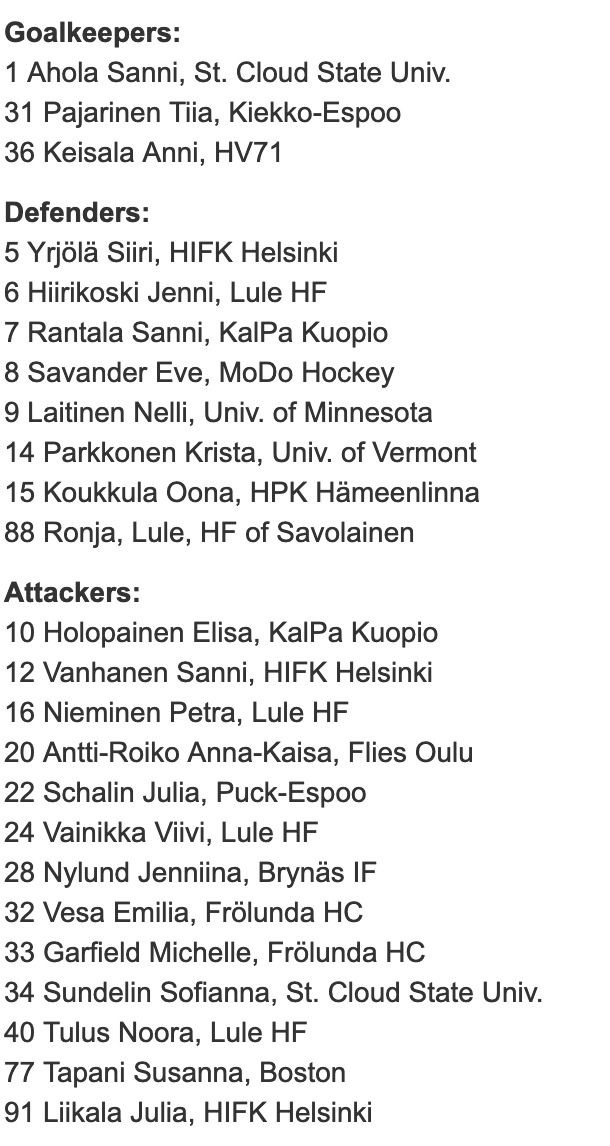
Text version available here
2023 finish: Fifth Place
2024 goals: Bronze
Roster changes: Two of their key offensive pieces Elisa Holopainen and Michelle Karvinen, are back and healthy this year! Susanna Tapani is also back on this team. Those are three absolute big pieces that completely change this roster for the better. A few depth roster forwards were left off in their place, most notably Kiira Yrjänen. Defense has more shakeups. Sini Karjalainen is a notable omission and long time defender Rosa Lindstedt retired. Eve Savander, Oona Koukkula, and Siiri Yrjölä slot in.
Three players to watch: I've consistently been a very big Elisa Holopainen fan and I think she's one of the best players in the world and not talked about nearly enough. Just as she began to really shine in the international stage, she got hit with injury, but as she's come back with year she dominated Finland's league going 32-25-57 in 19 games. I think I've put her as a player to watch like every year I've done a preview and I'm going to keep going it. Finland has faced a lot of questions about their goaltending following Räty and the team going their separate ways, but right now, it is Sanni Ahola's crease to lose. She was stellar in the three games she started last year for Finland in the world championship and was solid for st cloud state with a .935 save percentage in 17 starts this year. With Lindstedt's retirement, Krista Parkkonen will see more minutes, coming off a breakout sophomore year in a university of vermont program that's developed a decent amount of international blueliners.
Switzerland
Roster
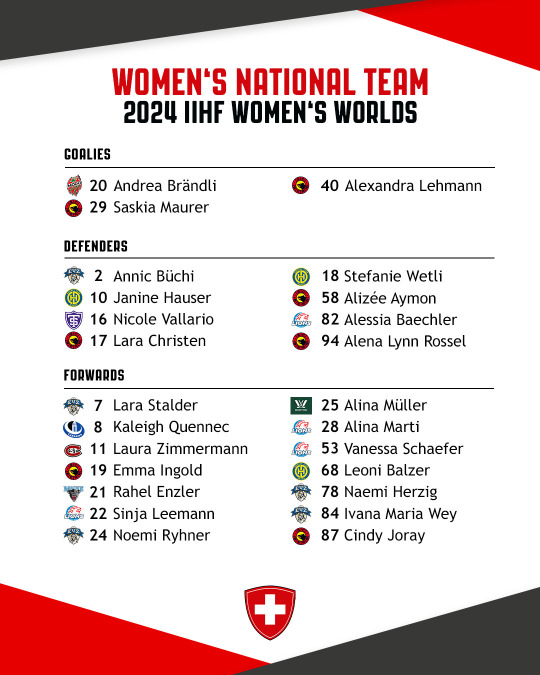
(Text version here)
2023 result; 4th place
2024 goals: bronze
Roster changes: quite a lot of shake up. no Caroline spies as their mainstay backup, Alexandra Lehmann takes her place. No Sarah Forster, who wore an A and led their defense last time around. She only played 7 games in SWHL this year, so likely injury is at play.
Players to watch: it is, of course, the Alina Müller and Lara Stalder show until it isn’t. So, besides them, the players to watch are Andrea Brändli is another “top five goaltender in the world” to know, sporting a .937 in her first year playing in Sweden post a stellar college career. 18 year old Ivana Marie Wey just had a great year playing pro as Stalder’s teammate and will be important for the next Swiss wave. With no Forster, Lara Christen will take on a lot of the top defensive minutes most likely.
Sweden
Roster

(Text version available here)
2023 results: sixth
2024 hopes: return to group A
Roster changes: no Sarah Grahn which isn’t entirely expected but still a big change, in response Ida Boman gets the call. No Fanny Rask or Olivia Carlsson, who retired.
Three players to know: Ebba Hedqvist is a 17 year old elite center coming off a great performance at worlds and has an eye for playmaking that will be critical for Sweden. Maja Nylén Persson is the #1 defender of team Sweden that has consistently been the top defender by points in the SDHL and won defender of the year in 2022-2023, and she is only 23 years old. Another part of Sweden’s insane center depth is Lina Ljungblom, who will likely play in Montreal next year and had 46 points in 36 regular season games. In the various tournaments/friendlies that Sweden has played leading up to this (ie five nations cup), she has 10 goals in 15 games. These three players are truly some of my favorite in hockey right now
Japan
Roster
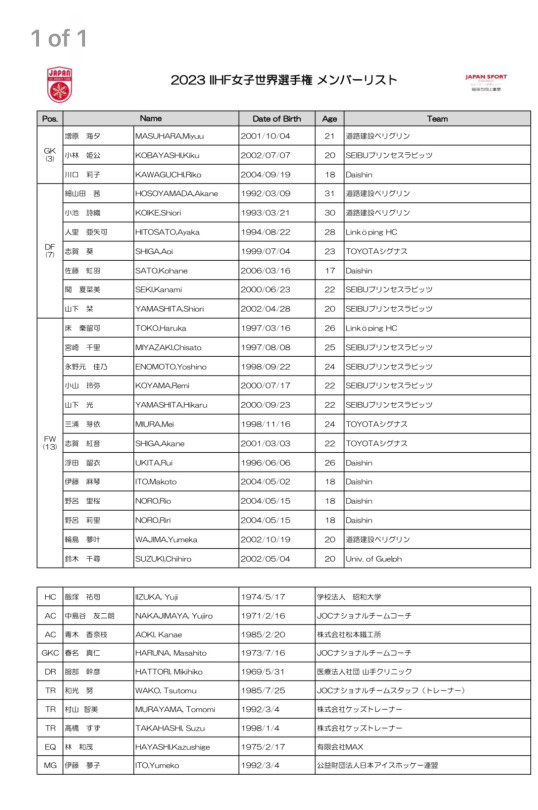
(Text version available here)
2023 result: 7th
2024 hopes: return to group A
Roster changes: honestly we mostly running this back. One or two u18 add ins but overall the same as 2023
Players to watch: stop me if you heard this before but Akane Shiga is very good. The PWHL Ottawa player is the only player from Japan to score against the USA, and will continue to be japans biggest threat. Another big player is Haruka Toko, one of the SDHL’s top scorers this year who had established herself as a top talent in the last two years. This year, the 27 year old had 13 goals and 30 assists in 36 games in Sweden this year. She was one of seven players in Japan to play in Sweden this year, a year that saw a new high in Japanese players going overseas to play. That also includes my last player to watch, Yoshino Enomoto, who played in switzerland and still put up around a point per game on a team that struggled (they folded in the offseason then came back and built their roster late and were ultimately relegated, but she was a bright spot in her first season there)
Fun fact: did you know three pairs of sisters play on this team? Akane and Aoi Shiga, Haruka toko and Ayaka Hitosato, and Rio and Riri Noro
Germany
Roster

(text version available here)
2023 Results: Eighth
2024 Goal: Make quarterfinals and avoid relegation
Roster changes: Both goalies behind Abstreiter last year, Chiara Schultes and Johanna May, did not make this roster with Hemmerle and Loist taking their place. The d core remains the same besides Daria Gleissner taking Heidi Strompf's place. National team vet Marie Delarbre is absent with injury, Sonja Weidenfelder did not play hockey this year and her status is uncertain, and Anne Bartsch did not make the roster. In their place we have Emily Nix, Lilli Welcke, and Lucia Schmitz.
Three players to watch: Luisa Welcke was with Germany last year, but has a second season in the NCAA under her belt and a nice depth player performance at Boston University. She will have more chances to show off her offense this tournament than in the NCAA, and I'm excited to see what she can show. Jule Schiefer had a revelation this year in the German league. From last year where she only scored 4 goals in 20 games, this year she scored 22 in 24. Let's see if she can continue this at worlds. Nina Jobst-Smith will play big defensive minutes for Germany after finishing her fourth season at Minnesota Duluth, this time serving as an assistant captain, and was nominated for 2023-24 All-WCHA Third Team. She's a two way defender who will be taking on big responsibility for Germany as she has in the past.
China
Roster
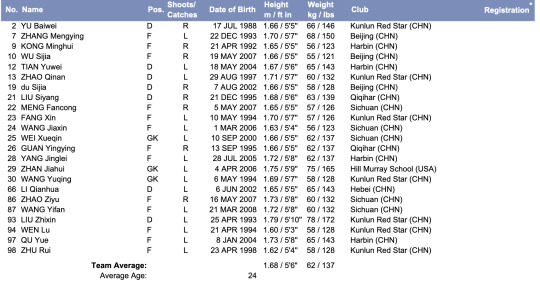
(Text Version available here)
2023 result: Promotion from Division I
2024 goal: Make quarterfinals and avoid relegation
Roster changes: Oh boy. So, like, a lot of people, and here is why: up until this tournament, China allowed dual citizens not born in China to play for them. This includes some players you may know from PWHL/NCAA like Leah Lum, Hannah Miller, Rachel Llanes, and Tia Chan. Going into this tournament, they changed the rules and those players will not be eligible, so it is a significant roster shakeup.
Three player to watch; This team is very young. Yifan Wang is 16 years old, and in her international debut scored 10 goals in 5 games in the WJC-D2A U18. This is obviously a gigantic step up in competition and very hard for a 16 year old to be playing against adults on the highest level stage of women's hockey, so I don't imagine she'll get a TON of ice time, but she is worth looking out for. Xin Fang is the veteran and star of this roster, who had 2 goal and 2 assists in the teams D1A tournament that earned them their promotion. 17 year old Dartmouth commit Grace Zhan is who I expect to be their starting goaltender. Born in Beijing, she spent the past year playing Minnesota High School Hockey and put up top numbers in a league that sees a lot of NCAA recruits.
Denmark
Roster

(Text version here)
2023 Results: Promotion from Division I
2024 hope: Make Quarterfinals and avoid relegation
Roster changes: Long time national team star and centerpiece of the team Josefine Jakobsen will no longer play for Denmark, though she will continue her club career.) Otherwise, despite some depth changes, it is mostly the same lineup.
Three players to watch: Frederikke Foss had a great year at Shattuck St Mary's u19 program and has committed to UMaine, and may be able to spark some offense Denmark will desperately need without Jakobsen. Silke Lave Glud will also be expected to carry the offense after her stellar year in the Tier 2 league in Sweden, and lead the way for younger players as one of the most experienced members of the team. Goaltender Emma-Sofie Nordström's performance at the D1A worlds was a big reason for their promotion, and she is coming off a great sophmore year at st. lawrence university where she had a .931 save percentage in 36 games and 7 shutouts. If Denmark wants to stay in the top division, she will need to steal a game for them.
225 notes
·
View notes
Note
Did you watch the first Group stages for the Olympics? Thoughts? Do you think the US could have done better if Ash/Ali were there?
Not surprised by any of the stage results so far, tbh. Let's break it down team by team and go from there with my hot takes lmao:
GBR vs. CHI
Chile, while they have a GOAT in Endler, just doesn't have anything else to win, so they're never going to get passed the group stage, or if they do, it will be on a miracle. Like we've seen, good GKs can only keep your team in the game, whether or not they can stay in it is up to them. England has a strong squad and had a great start, and I think they'll hold up just fine in their group even against Canada or Japan for that top seed. They have enough gelling for them to work.
JPN vs. CAN
Two words: Steph Labbé. This is the Ashlyn Harris/Alyssa Naeher combo we all wish we could have. The heart she had to commit the PK, and then save it? A legendary move and I honestly felt for her that she had to be subbed out. Kailen, though, she's still so young and this is a great experience for her and knowing her, she's only going to continue to drive to improve and be better next game (even though that goal was a really tough one to save and came off some poor defending) - the CANWNT run into the same problems as the Pride sometimes; they're not out there to go and score a whole bunch of times, rather they score once and then defend the rest of the match. I need to see more attack from someone other than Sincy (congrats on her 300th cap and 187th goal, btw, absolute lengend) or Prince. Get some more attacking power in there because Japan isn't a team that will go down quietly, just likely they showed today.
BRA vs. CHN
Marta magic baby! The link up between Marta and Debinha, and just everyone on this team is so inspirational to watch. I honestly would LOVE to see them pull through and win this whole thing because no one deserves an Olympic Gold than Marta and Formiga. Their retirement is going to be the most emotional moment in women's football, even more than when Abby and Christie retired, tbh. China has some moments, but again, Brazil brings so much experience. I don't know how deep they can run into this tournament given how old their best players are, but they'll give it everything, no doubt. I want them to make it to the final rounds, or at least for the Bronze medal match, because the OGs deserve to go out with a medal.
ZAM vs. NED
Boy, this was an absolutely thrashing. I mean, there was absolutely no mercy by the Netherlands, but major kudos to the Zambia team for fighting hard to make that GD 7 instead of 10. They managed to score on a very good keeper and cut through a solid defense, even if they got blown out of the water. The drive was unreal and massive props to them for fighting to the last second. The Netherlands proved in this match why they were the 2019 finalists, and honestly, I'd be surprised if they're not back in the finals again this year. They're strong, meticulous, lethal on the attack, and defend very well. Not to mention they have a great blend of youth and experience for depth.
AUS vs. NZL
I mean, I hate to say it, but I don't see either of these teams going too far in this tournament. They both are big bodied, rough and tumble teams, but I honestly think it's a bit of a disadvantage than an advantage. NZL has never been particularly good, but kudos to them for clawing back and not getting shut out. On paper, the Matildas should have a great chance of going far, but I don't know if they can given who else is in their group. Maybe they can be in the top third? I still don't see it as likely, but no way is NZL going anywhere further.
SWE vs. USA
The match of the hour, huh! I mean, are any of use actually surprised at this result? The USWNT have been playing lower tiered teams and NOT blowing them out for the past year. Vlakto has made decisions to bring on older veteran players and barely healthy players like Jill did in 2016, except with a slightly weaker/disjointed defense. Look, I won't hide my inner glee at the karma inflicted by the soccer gods on this "the Olympics should be easy" USWNT team, but I'm gleeful. The revenge story fell flat and they showed themselves to be unable to make changes on a dime or adjust to the context. The ball to the face from Tobin's own kick was an accurate summation of the match. Now look, the USWNT will most likely bounce back and they'll probably at least make it to the semi-finals if not the finals. But, given the performance of Sweden, the Netherlands, and even Brazil, I'm not sure how they can withstand the firepower and strength of these teams when they've not played higher-calibre teams in a long time. Sweden put on a clinic with how organized, level-headed, and clean they were with their efficiency. The absolute dedication to pushing and attacking and defending and knowing their roles was outstanding and an absolute joy to watch. I felt happy for them and I believe that the USWNT are going to need a lot more than a redemption arc to get far in this tournament, but still, I think they should be okay so long as they don't rack up injuries or get gassed. Alyssa Naeher is the only reason they didn't get blown out, tbh. She is a star on the USWNT even if she's subpar in her club performance. She thrives at the international level and is so, so good and clutch.
Now, to answer your question about Ash/AK, no I don't think them being on the roster would change anything. Ash would never see a start even if she's a better club player than Alyssa, and tbh, she wouldn't make a difference here. Alyssa did a really great job and she definitely still is the #1 USWNT keeper even with the three goals conceded this match. Ash is great in clutch moments, but she has no big tournament experience so it's hard to tell if she could thrive under the pressure (I think she'd be fine, but there's no real evidence to back that claim since she has never played in a big tournament). AK might have added some leadership/consistency to the backline, but again, she didn't have a great performance in her last camp and her club performances have been rather inconsistent, even if they're still good. I don't think she should've made the cut or been on the roster.
The only person that should've been on the roster, in my opinion, but wasn't is Midge. She has proven time and time again she can play at any position and is versatile, strong, tough, and fast. She should've been the alternate over either Kruger or Lynn any day of the week. It will be interesting going forward how Vlatko rotates his players or if he will play the same Starting XI against a weaker NZL team. If everyone starts and subs, I worry about depth and conditioning especially for the older vets like Pinoe, Becky, and Llyod.
#asks#idk if i should tag the teams in here but i won't just to avoid drama#but yeah very interesting start to the games
3 notes
·
View notes
Text

@hcpefulmarshmallow said: "I look good in a crown." (Prince Consort Ko!!!)
Send "I look good in a crown" for my muse's reaction to yours suddenly becoming royalty (No Longer Accepting)
"You know that it is custom to ask the King for a wedding gift after a proposal has been formally announced."
"I am aware, father. I only wish for two things from you and our country."
"Oh? Why do I have the feeling that your requests are not part of the Novoselic Crown Jewels?"
"Because all I want is for Nagito to have somewhere he knows he belongs: I want for him to have a proper home and a family. That is the wedding present I desire from you and our country."
***
Perhaps she should've been more specific. That was Sonia's thought as she navigated the underground corridors of Novoselic Castle. It was quicker than being driven around the vast building to the Royal Family's private entrance and she didn't dare cross through the rooms open to the public at this hour. As gracious as she tried to be with her time, greeting visitors she happened to come across as she went about her day, the Princess of Novoselic was in no mood to slow down.
After all, they'd been delivered today. She'd been on a visit to the capital's police headquarters when Cecily had discreetly whispered the news to her: after all the planning she'd tried to do so she could be with him when they were unboxed, and it had still been brought to their wing of the Castle while she attended an official royal appearance. While it was likely the least overwhelming aspect of Nagito's life in the past seven or eight months, that wasn't saying much. The official engagement announcement had propelled both of their lives forward, in responsibilities, in public opinion, faster than any roller coaster she'd ever tried in her life. In the blink of an eye, the most romantic time in her life had turned into interview after interview, endless media coverage and speculation, and more knick-knacks featuring their likenesses and wedding date than she even knew to exist. She'd been born into this and she still found it peculiar that people were buying dish towels with their faces on it. She hadn't really known how to explain it to him in a way that made sense.
But she had more pressing matters than rationalizing why t-shirts, tote bags, and china sets emblazoned with their appearances were selling faster than shops could stock them. From the first interview, opinions ranged from her own family to the servers at the café they both loved to visit in disguise: Princess Sonia's fiancé was too thin, too pale, with strange hair and such a quiet and awkward personality. He'll never outshine his wife, that's for sure. And no real family to speak of? They met at the Princess' private school in Japan, but what makes him special enough to be the other half to the Royal Love Story? The official biographer had her work cut out for her, and a month before the wedding had embellished their courtship to be a fairy tale fit for a princess, with a dashing, brave hero who rescued Sonia's heart from loneliness. At least, her mother had said to both Sonia and the biographer, they could play up the fact he wasn't poor. If the public opinion varied, the Royal Family's opinion was even more polarizing.
Passing her favorite wine cellar and her occult room, Sonia took the spiral stone staircase two at a time, her pale hand gripping the banister. Their temporary wing of Novoselic Castle was smaller than most and rather drafty, but at least it was further away from both her mother and father's sets of rooms. Outfitted in the favored shades of light green and gold, she'd promised Nagito that it was only going to be their home for a little while, while Boudry House, the capital's official Royal Residence, was being renovated. Taking up an entire city block, that had been the first gift her father had given them: a home with ten bedrooms, fourteen bathrooms, five offices, a formal and an informal dining room, a library, a study, a sitting room, an entertainment room, a full kitchen and pantry, and more, not to mention the staff to maintain it, including their personal assistants, secretaries, and security. This was still smaller and less luxurious than Novoselic Castle itself, but at least it would be theirs to call their own. That was enough to excite her, though when she'd taken Nagito there for the first time, she was sure he'd adore the garden. The house bordered the capital's largest and busiest park, with a section of greenery fenced off with large hedges just for the house's use. They could plant what they liked, or arrange outdoor furniture into a private oasis from the hustle of royal life. It was the perfect place for their future pets, and eventually children, to appreciate and enjoy nature, quiet and tranquil.

"Nagito?" She called out softly, pushing the painting of her 16th century ancestors aside. The underground passages were supposed to be hidden, but he was family now. Her family, and Sonia had taken every opportunity she could to show him how to move about the castle with little to bother him. Stepping through, she looked across the room to him, or rather his retreating back as he seemingly stood in front of the full-length mirror, with a gentle smile. There was little doubt he was admiring, or at least in shock by, the second gift. "I returned home as fast as I could. I'm so sorry I couldn't have been by your side when they arrived."
She was probably one of the only people in the world who still called him 'Nagito.' When she'd brought him to meet her family for the first time and when they'd gotten engaged, he'd been referred to as 'Mr. Komaeda.' But now he was royal by marriage, from titles her father had warmly, kindly, bestowed upon him on their wedding day. Informally, he was 'Nagito Komaeda' but the world knew him by 'His Royal Highness' and the dukedom he now held. For all the speculation the media had made over his new titles, insisting the King of Novoselic had been too generous by giving Nagito the title of Prince, it had all been done to fulfill Sonia's request: that he would have a family where he belonged.
But the decision had been agreed upon at the very last minute, far before the official medals and insignias could be crafted for their nuptials. So while he wore the proper non-military wedding attire, complete with white tie and morning coat, the decoration he'd worn, seen across the world, had been antiques from the Novoselic National History Museum. The pieces had been selected to closely resemble the real ones he'd eventually wear for the most formal of occasions and couldn't be discernible from far away, but that hadn't mattered: up close, her family and the aristocracy still whispered that the new prince was wearing someone else's earned titles and achievements the day he married Princess Sonia. Picking over his hair, no matter how elegantly he'd tied it back, and his posture no longer was enough to amuse them.
But today would change everything. Today, the official medals and ribbons for his new titles had arrived, fashioned in a royal design that she'd insisted he help with. Something that signified he was part of her family now but still retained a design that was uniquely his. That when he looked down, he'd never forget that he was no longer alone. While her entire family hadn't completely warmed to him yet, they were coming around. He was hers, and he was here to stay.
Surely he could see her in the mirror as she crept up behind him, and yet Sonia hardly cared. Instead she moved to his side, placing a kiss upon his cheek as the gold, emeralds, and diamonds of his new accessories sparkled, reflecting the light from the chandelier. "You look beautiful," She whispered in his ear. "Welcome to the family, my love."
#more-than-a-princess answered#hcpefulmarshmallow#(royalty meme)#Non-Despair AU: The Princess of Novoselic#(Please enjoy some of my recently married Nagito/Sonia headcanons :D)
19 notes
·
View notes
Text
BTMH: Chapter 22: Assignments

Back in Japan Y/N had been practicing a jump Seonghwa was teaching her. She wiped the sweat off her cheek. “Seonghwa, please let me do that one more time!”
Seonghwa was leaning against the rink boards, sweating as well. “Wow…Hasn’t it been tens of thousands of times?” Seonghwa asked before bending down to wipe off his skate blade.
“Just thirteen,” Y/N said as if that was a small amount.
“Isn’t your knee hurting you?” Seonghwa asked.
“Not really, I wrapped it well so it shouldn’t bother me,” Y/N said.
Seonghwa nodded. “I’ve thought this for a while, but you have pretty good stamina, even better than some male skaters,” Seonghwa said, bending over to wipe off the other blade.
“Well, I have that, at least,” Y/N said. It was one of her good traits. She had great stamina, which was also why she was able to do so well when competing against men and women. With men it meant she could do as many jumps as them without getting tired. With women it meant she could do more jumps and have them in the end, too.
Seonghwa was still bent over as he started to talk. “You said you get hungry when you’re nervous in competition, too.”
Y/N didn’t say anything, only starring at the top of his head as she blushed.
“You haven’t suffered any more injuries since your last one, and you’re younger than I am,” Seonghwa said.
Y/N pokes Seonghwa’s hair with her finger. Seonghwa and Y/N both froze. Y/N realized what she did and she jumped back before starting to wave her hands.
“S-Sorry!” Y/N said.
Seonghwa moved his hand to touch the spot that Y/N did.
“I couldn’t help it! Your hair just looks really soft!” Y/N said.
Seonghwa ignored what she said. “Is it getting that thin?”
Y/N shook her head aggressively. “No, no, no! Everything’s okay!”
Seonghwa sunk to the floor, his hand still on his head. “I’m hurt…I can’t recover from this.” Seonghwa laid down on the ice.
Y/N’s eyes widened. She felt really bad even though she knew he was being overly dramatic. She stood on her toe picks before dropping to her knees in dogeza. “Sorry! Please get up!”
Takeshi and Yuuko were watching the event unfold from outside the rink. Takeshi looked over at Yuuko. “Well, those two seem to get along fine.”
Later that night Y/N was scrolling through twitter on her computer when she heard the chime signifying that she had received an email. She opened her email and her eyes widened. “It’s here!” She shouted.
Y/N picked up her laptop before running to Seonghwa’s room and opening the door. He sat up and looked at her, wondering what had her in such a rush.
“Seonghwa, listen!” She said. She jumped onto his bed, accidentally stepping on Makkachin’s tail which caused him to yelp. The lights came on soon after.
“Oops, sorry!” Y/N said to Makkachin before giving him scratches. “The music for the free program’s done.” Y/N put the earphones in Seonghwa’s ears then started the music. Seonghwa smiled and her and nodded.
“It’s perfect,” Seonghwa said.
The next day the two were at Ice Castle Hasetsu. They were standing off the ice against the rink, working on deciding the jumps for the program.
“If you want more impact, maybe the last jump can be a quadruple toe loop?” Seonghwa suggested, tapping his pen on the notepad.
“Huh? For the last one?” Y/N asked. She didn’t think it was a bad idea, she just didn’t expect him to suggest it since she was still having trouble landing it.
Seonghwa looked at her. “With your stamina, I think you can pull it off,” Seonghwa said. He then leaned in closer. “Unless you think you’ll knee will cause you issues, or if you’d just rather not do that.”
“I’ll do it!” Y/N said.
She decided not to leave it out just because it would cause her pain. She had been having pain all season, but she’d been icing and wrapping which was helping. She knew she was going to be in pain no matter what she did, so she decided go big or go home.
“Okay,” Seonghwa said. He turned around and took his jacket off. “Oh, right. Y/N, did you change the musical theme?”
Y/N blushed and looked down. “Oh, um…”
“What is it?” Seonghwa asked.
“The theme is “on my love”,” Y/N said before looking up at Seonghwa. She saw the smile on his face grow wider and she let out a sigh of relief.
“That’s the best theme. Perfect,” Seonghwa said. “Okay, let’s finish this!”
“Yeah!” Y/N said. She assumed the starting position for the free program and then began to do the choreography.
Back at Lilia’s home, Yakov had news. “Jongho!” He called. He then walked into the living room where Lilia was sipping tea with Jongho’s cat, Puma Tiger Scorpion. “The assignments are in.”
Jongho walked out of the bathroom, his hair still wet. “Where? Where’d that little Japanese piggy get assigned?”
At Yu-topia, confetti shot out of confetti poppers. Y/N was sitting on the floor in front of a table. Minako, Seonghwa, the entire Katsuki family, and the entire Nishigori family clap for Y/N.
“Look at you! Making your big comeback! I’m so proud,” Yuuri said, wiping away a non-existent tear.
“Thank you,” Y/N said with a smile.
“Okay, I’ll explain which events you’ll be competing in,” Seonghwa said.
“But first! Since the Katsuki family, minus Yuuri, doesn’t know much about figure skating, we’ll give a simple explanation!” The triplets said.
“Oh, that’d be very helpful!” Hiroko said.
“What is the Figure Skating Grand Prix series? Skaters with high scores in the previous year participate in a maximum of two competitions of six worldwide. Only the top six skaters advance to the Grand Prix Final, which decides who’s number one! And this season, Y/N’s been assigned to the third event, the Cup of China! Y/N’s former rink mate, Yunho from Thailand, will be there, too!” The triplets explained.
“Oh, Yunho will be there?” Y/N said.
“And her second event will be…The sixth event, Russia’s Rostelecom Cup! She’ll be up against her fated rival, Jongho Plisetsky!” The twins said.
Mari was waving Jongho flags. “Wow, Jongho! Davai, davai!”
‘What a traitor,’ Y/N thought. ‘So I’m already facing Jongho in the Rostelecom Cup…’
“You’ll be minding the house during the season, Makkachin,” Seonghwa said as he pet his dog.
‘That’s right… It’ll be my first time in a Grand Prix series without Seonghwa in the lineup,’ Y/N thought.
“I bet if you show up with Seonghwa as your coach, they’ll think you stole him from the sport,” Takeshi said.
“Maybe skating fans worldwide hate you now!” Yuuko said.
Y/N looked down, freaking out internally. What if she really did make skating fans hate her? She couldn’t handle the thought of people hating her just because he was coaching her. Seonghwa noticed how she looked and put his arm around her shoulder in an attempt to calm her. He felt her shoulders relax after he did.
“Sorry! We’re on your side, Y/N!” Yuuko said.
“Yeah, we are!” Minako said before twirling around. “I’ll come cheer you on this season, too! First up is the Cup of China!”
“Huh? Y/N, last year…In the Nationals…” Yuuri said.
“I think I finished eleventh because I messed up my prep,” Y/N said.
“I see…So you have to compete in the block championships,” Takeshi said.
Y/N nodded, but Seonghwa didn’t really know what they were talking about.
“What?” Seonghwa asked.
Y/N remembered, Seonghwa never had to worry about competing in block championships, so he wouldn’t know what they are. She looked up at him. “Oh, we’re talking about domestic competitions.”
“To explain, Y/N had a big-time loss in last year’s Nationals. So this year, she has to work her way up from qualifying championships. So her first even this season is the Chugoku, Shikoku, and Kyushu Championship in September. It’ll be her comeback competition!” Yuuko explained.
Takeshi hit the back of Y/N’s head. “Well, you’ll breeze through that.”
“Ow,” Y/N said. She reached up to rub the part of her head that he had hit.
“Oh, but Wooyoung from Fukoka will be competing in it!” Yuuri said.
“Yeah, he beat Y/N in the nationals. Wooyoung Kenjiro from Kyushu, said to be the number one star among younger skaters,” The triplets explained.
‘Right, it’s already been more than six months since December, when I thought I was done for,’ Y/N thought.
“Good, good. We can cheer you on this year, too! Good luck,” Toshiya said.
“Dad,” Y/N said, a small smile on her face.
“We need to use this chance to make money!” Toshiya said.
The smile disappeared. “Dad.”
“You’ll autograph a sign, won’t you?” Hiroko asked.
‘Until now, I thought I was fighting all by myself. Now that Seonghwa’s here, that’s totally changed. Some things are still the same. Some have changed. Now everything feels so new. I may never be able to regain what I’ve lost, but I can clearly see what’s in front of me now.’
‘Figure skater are only competitive for a short time. This will probably be my last competitive figure skating season. My knee won’t last much longer,’ Y/N thought.
Y/N watched as Seonghwa demonstrated a jump with his hands, nodding as he continued the explanation.
‘I don’t know how long Seonghwa will stick around or how much longer my body will hold up,’ Y/N thought. ‘So please, God…Give me Seonghwa’s time, if only just for now. Please let me get that gold medal so I can end up with the man I care about.’
Seonghwa held the CD in his hand. “Y/N, you haven’t named the piece. What will it be?”
Y/N took the cap off the black marker she was holding and wrote down a name on the CD.
“That’s perfect,” Seonghwa said.
The CD was labeled “Y/N on Ice”.
‘September…Seonghwa’s and my season will finally begin,’ Y/N thought.
5 notes
·
View notes
Text
Artistic Swimming - Full Team Event from Rio 2016
The pool must be at least 20m wide x 30m long, and at least 2.5m deep. One area, 12x12m or larger, must be at least 3m deep and the slope between the change in depths has to be completed over a distance of 8m or less. The pool's water must be clear enough so that the bottom of the pool is visible from above and at least 27°C (80.6°F,) plus or minus one degree. The amount of light underwater is also very important, since goggles aren't worn in competition, so there is a required minimum brightness of 1500 lux.
Synchronized swimming is played in a specially designed pool. The water in the pool must be clean and the temperature of the water must be around 25 degree Celsius. The size of the pool must be a minimum of 20m by 30m, and within that a 12m-by-12m area must be at least 3 m deep. Let us now discuss the equipment used in synchronized swimming. In synchronized swimming, the athletes have to perform a lot of underwater movements. There are chances of water entering into the nose of the players. In order to avoid that, the athletes use a small clip of hard plastic or wire. It also has a thin rubber coating. Athletes can use goggles only for trainings. This is only used for figure test. Like goggles, athletes also cannot use the bathing caps during routine competitions. During figure test, only a white or black bathing cap is worn by athletes. The most important equipment for synchronized swimming is the underwater speakers. Swimmers cannot perform under water if the music is not audible. Music plays an important role in synchronized swimming because it is a rhythmic sport. We know that impedance of water is 3600 times more than that of air. There is also a 62 dB (decibel) offset between the sound that travels in air and that in water. To overcome this problem, the underwater speakers used in synchronized swimming depend on Piezoelectric Technology. One of the most important aspects of the swimsuit is that it must be comfortable for the athletes and it must be non-transparent. During the figure test, a black swimsuit is recommended for the athletes and during routine competition, a routine suit for each athlete that suits the music is recommended. It may also happen that athletes perform in two events like duet and team event. In such a situation, the athletes will be provided with two different swimsuits.
The basic skills you will need in synchronized swimming is sculling and treading water with a kick called the "eggbeater". There are also many positions that you can learn to combine into a routine. Additionally, there is an element known as “lifts” in synchronized swimming, where swimmers create a structure of sorts with their bodies and lift themselves from the water in the same formation, they created underwater. Sculls are hand movements used to propel the body and are essential to synchronized swimming. Some commonly used sculls are support, standard, torpedo, split-arm, barrel and paddle scull. The support scull is most often used and is made up of two repeated movements. You need to hold your upper arms against your body and your forearms at 90-degree angles. Then, you move your forearms back and forth to create enough water pressure to hold your legs above the water. This move is much like how a manual eggbeater works, with one leg rotating in a clockwise manner and rotating the other leg in an anti-clockwise manner. Synchronized swimmers use this kick because it leaves their hands free to perform strokes. Due to the opposite motion of the kick, it is a stable and efficient way for swimmers to attain the necessary height to perform moves above the water. Crane Position - Hold your body in a vertical position with one leg held vertically above the water surface, while the other leg is held parallel under the surface in a 90-degree angle or "L" shape. Ballet Leg Double Position is lying flat on the water surface, draw your knees towards your chest with shins parallel to the water surface. Straighten your legs above the water surface to assume a Surface Ballet Leg Double position. Side Fishtail Position is a position similar to the crane. One leg remains vertical, while the other is extended to the side parallel to the water, creating a side "Y" position. Knight Position is when the body is held vertically with your head in line with the hips and pointed to the bottom of the pool. One leg is lowered to create a vertical line perpendicular to the surface. Flamingo Position is similar to the ballet leg position where the bottom leg is pulled into the chest so that the shin of the bottom leg is touching the knee of the vertical leg. Split Position is when the body is vertical, one leg is stretched forward along the surface and the other leg is extended back along the surface.
Synchronized swimming demands advanced water skills, requires great strength, endurance, flexibility, grace, artistry and precise timing, as well as exceptional breath control when upside down underwater. Competitors show off their strength, flexibility, and aerobic endurance required to perform difficult routines. Swimmers perform two routines for judges, one technical and one free, as well as age group routines and figures. Synchronized swimming is both an individual and team sport. Swimmers compete individually during figures, and then as a team during the routine. Figures are made up of a combination of skills and positions that often require control, strength, and flexibility. Swimmers are ranked individually for this part of the competition. The routine involves teamwork and synchronization. It is choreographed to music and often has a theme. Depending on the competition level, swimmers will perform a "technical" routine with predetermined elements that must be performed in a specific order. The technical routine acts as a replacement for the figure event. In addition to the technical routine, the swimmers will perform a longer "free" routine, which has no requirements and is a chance for the swimmers to get creative and innovative with their choreography. The type of routine and competition level determines the length of routines. Routines typically last two to four minutes, the shortest being the technical solo, with length added as the number of swimmers is increased (duets, teams, combos and highlight). Age and skill level are other important factors in determining the required routine length.
While there are a range of rules and penalties for specific routines, the basic rules of artistic swimming are; No Touching the Bottom; One of the things which makes the lifts all the more impressive is that artistic swimmers are not allowed to touch the bottom of the pool at any point during their routines. No Bling; presentation is a unique and important part of artistic swimming but there are certain restrictions on what swimmers can wear. For example, artistic swimmers are not permitted jewelry, theatrical make-up, or inappropriate costumes. No Goggles; another restriction during artistic swimming routines is goggles. However, swimmers in figures competitions are permitted to wear them. Team Means Team; teams normally contain eight swimmers, but the minimum number for a team is four. Teams lose marks for every swimmer they have under the full complement because it is easier to synchronize the fewer people there are in a routine. Stick to The Schedule; routines can be anything from two and a half minutes to five minutes long, depending on whether they are performed alone or as part of a team. However, swimmers are penalized if they take 15 seconds fewer or longer than the specified time.
Team Egypt had a lot of movements from flips to turns and did a great job in doing formations. Team Australia had an artistic start starting off with graceful flips with a lot of coordinated successions and flips. Team Italy had a wonderful theme of seasons and then successfully interpreted a lovely rendition of it with slick pattern changes. Team Brazil had a great energy with their formations, pattern changes and a lot of successions with each and every single one on the team that is very appealing to the audience eyes. Team Ukraine with the phenomenal formations and their movement’s originality with tricks that seem risky and thrilling, making the routine magical as their theme intended. Team China started off the routine with a powerful flip synchronized moving formations and ending their routine with turns and formations of pure spectacle. Team Japan had artistic formations and fabulous flips with beautiful lineups of synchronization. Team Russia started the routine with an incredibly high flip and with near perfect synchronization with great athleticism and energy to carry on the routine winning them the Gold Medal.
1 note
·
View note
Photo

Analysis
Artistic swimming is also called synchronized swimming it is a hybrid form of swimming, dance, and gymnastics. They are preforming in the water and elaborate the moves in the water accompanied by music. It is what happen in the Final of 2016 Rio Olympics where different teams from different countries are eager to get the championship of Rio Olympics. Where Japan did a great job and did their very best but they did not get the gold medal but instead to will bring back to japan the bronze medal. The silver medalist is China they have a great battle to get the gold medal but, the judges are not convincing of what they see instead they give the gold medal to Russia which is very show they confidence and prove to everybody that they are the best. All of the teams that join in the competition has a equal chance to get the championship but it is a competitions there is only a one winner and fortunately to Russian people there representative bring home the Gold medal to their country.
Court Dimension
is played in a specially designed pool. The water in the pool must be clean and the temperature of the water must be around 25 degree Celsius. The size of the pool must be a minimum of 20m by 30m, and within that a 12m by 12m area must be at least 3 m deep. The pool must be at least 20m wide x 30m long, and at least 2.5m deep. One area, 12x12m or larger, must be at least 3m deep and the slope between the change in depths has to be completed over a distance of 8m or less. The pool's water must be clear enough so that the bottom of the pool is visible from above and at least 27°C (80.6°F,) plus or minus one degree. The amount of light underwater is also very important, since goggles aren't worn in competition, so there is a required minimum brightness of 1500 lux.
Equipment
Nose clip- the athletes have to perform a lot of underwater movements. There are chances of water entering into the nose of the players. In order to avoid that, the athletes use a small clip of hard plastic or wire. It also has a thin rubber coating.
Goggles- provide safety to the eyes. Due to underwater movement, water may enter in the eyes. It is important to note that the goggles are not allowed for routine competitions.
Underwater speakers- The most important equipment for synchronized swimming is the underwater speakers. Swimmers cannot perform under water if the music is not audible. Music plays an important role in synchronized swimming because it is a rhythmic sport.
Swimsuit- One of the most important aspects of the swimsuit is that it must be comfortable for the athletes and it must be non-transparent. During the figure test, a black swimsuit is recommended for the athletes and during routine competition, a routine suit for each athlete that suits the music is recommended.
Basic Skills
Sculls- are hand movements used to propel the body and are essential to synchronised swimming. Some commonly used sculls are support, standard, torpedo, split-arm, barrel and paddle scull. The support scull is most often used and is made up of two repeated movements.
Eggbeater- This move is much like how a manual eggbeater works, with one leg rotating in a clockwise manner and rotating the other leg in an anti-clockwise manner. Synchronised swimmers use this kick because it leaves their hands free to perform strokes.
Positions- There are hundreds of positions that can be used to create infinite combinations.
Technical and Tactical Skills
Keeping time- In order to be a good synchronized swimmer you have to be able to synchronize. Seems obvious, but it can be harder than you think. First, you have to learn to count the music to stay on pace. Second, you have to be able to switch your counting tempo instantaneously since so many routines have a few different pieces (and speeds) of music cut and pasted together.
A vertical above your knees- At a certain point in every synchro swimmer's career, it is no longer acceptable to be below your knees in a vertical.
Flat Splits- flexibility is vital throughout synchro, but nowhere is it highlighted more than in the flat splits. Flat splits are rewarded at every skill level, but at the elite stage, they are a standard.
Jump to your hips- jumps, or boosts as they're technically called, are also important because they are technical elements. But, they have been and will continue to be in just about every routine, tech or free, that you ever do.
Hold a pattern- knowing how to stay in your pattern is the last but certainly not least essential skill. You should also have the ability to notice pattern problems and fix them quickly. This will not only save you from the incessant nagging of your coaches, but will also make you a better teammate.
Rules of the game
No Touching The Bottom One of the things which makes the lifts all the more impressive is that artistic swimmers are not allowed to touch the bottom of the pool at any point during their routines.
No Bling Presentation is a unique and important part of artistic swimming but there are certain restrictions on what swimmers can wear. For example, artistic swimmers are not permitted jewellery, theatrical make-up, or inappropriate costumes.
No Goggles Another restriction during artistic swimming routines is goggles. However, swimmers in figures competitions are permitted to wear them.
Team Means Team Teams normally contain eight swimmers, but the minimum number for a team is four. Teams lose marks for every swimmer they have under the full complement because it is easier to synchronise the fewer people there are in a routine.
Stick To The Schedule Routines can be anything from two and a half minutes to five minutes long, depending on whether they are performed alone or as part of a team. However, swimmers are penalised if they take 15 seconds fewer or longer than the specified time.
How to officiate the game
Officials play a critical role in the sport of artistic swimming. Not only do they facilitate the scoring during competitions, they support athlete selection activities in high performance programs and lend support to clubs in their athlete development programs and routine preparation.
1 note
·
View note
Text
Elegance in the Pool: An Artistic Swimming Blog
Rio Olympics 2016: Full Team Event Artistic Swimming
By Dana Esabelle Catingub
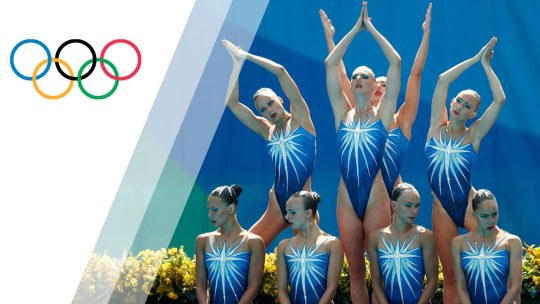
A Sports Blog
Russia sealed their gold medal in the final of the Artistic Swimming Team Routine at the Rio 2016 Olympics, where China clinched the silver medal and Japan garnered the bronze. The execution with which Russia performed their performance was “perfection” and received an incredible score of 196.1439.
Although each of the eight finalists impressed in their last display, it was ultimately Russia who ended a cut above the rest, with their execution, flips, and artistic impression trumping all others in the field. Ukraine came within inches of taking their spot on the podium, but Japan did enough in the session's closing performance to snag themselves third.
Russia pulled their routine off without so much as a quiver in form, which is to be expected of a nation that has dominated this field for almost two decades. Japan were understandably proud of their bronze achievement, that they got emotional and cried happy tears. All of the Japanese team welled up after it was announced they'd done enough to take bronze, while the Russians looked positively nonchalant with their gold feat.
In-Depth Details:
Court Dimensions
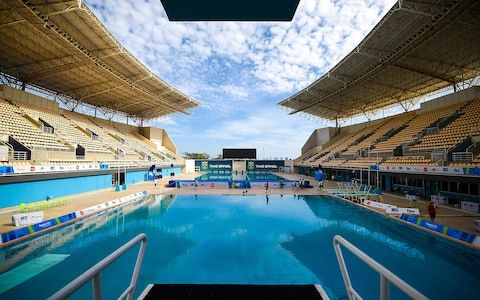
Maria Lenk Aquatics Center
The pool should measure at least 3m deep, 20m wide and 25m long. (Tokyo 2020, 2020)
Equipment
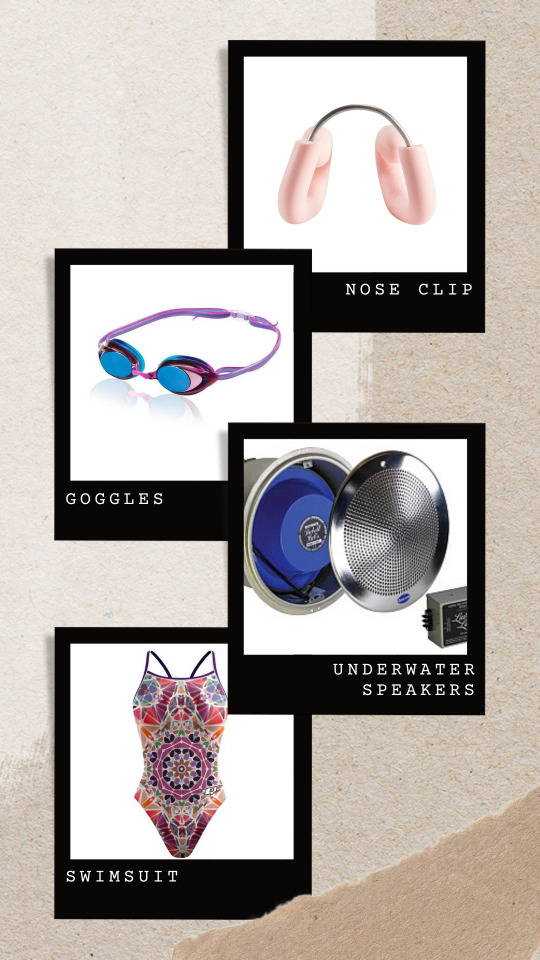
Nose Clip
In synchronized swimming, the athletes have to perform a lot of underwater movements. There are chances of water entering into the nose of the players. In order to avoid that, the athletes use a small clip of hard plastic or wire. It also has a thin rubber coating.
Goggles
Goggles provide safety to the eyes. Due to underwater movement, water may enter in the eyes. It is important to note that the goggles are not allowed for routine competitions. Athletes can use goggles only for trainings. This is only used for figure test. Like goggles, athletes also cannot use the bathing caps during routine competitions. During figure test, only a white or black bathing cap is worn by athletes.
Underwater Speaker
The most important equipment for synchronized swimming is the underwater speakers. Swimmers cannot perform under water if the music is not audible. Music plays an important role in synchronized swimming because it is a rhythmic sport. We know that impedance of water is 3600 times more than that of air. There is also a 62 dB (decibel) offset between the sound that travels in air and that in water. To overcome this problem, the underwater speakers used in synchronized swimming depend on Piezoelectric Technology.
Swimsuit
One of the most important aspects of the swimsuit is that it must be comfortable for the athletes and it must be non-transparent. During the figure test, a black swimsuit is recommended for the athletes and during routine competition, a routine suit for each athlete that suits the music is recommended.
(Tutorials Point, n.d.)
Basic Skills
The basic skills you will need in artistic swimming is sculling, the “eggbeater", and lifts. You can learn to combine these various positions into a routine. Lifts allow the swimmers to create a structure of sorts with their bodies and lift themselves from the water in the same formation they created underwater.
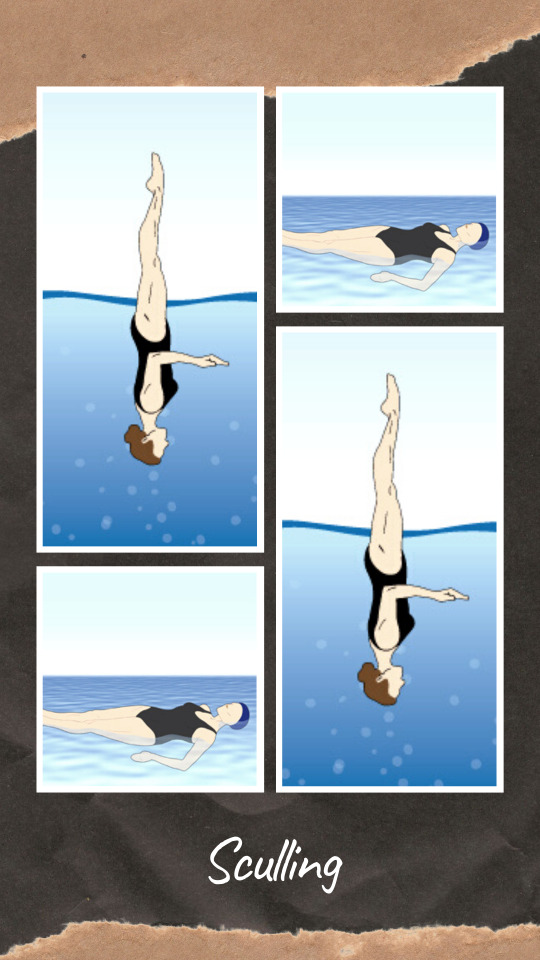
Sculling
Sculls are hand movements used to propel the body. Some commonly used sculls are support, standard, torpedo, split-arm, barrel and paddle scull. The support scull is most often used and is made up of two repeated movements. You need to hold your upper arms against your body and your forearms at 90-degree angles. Then, you move your forearms back and forth to create enough water pressure to hold your legs above the water.
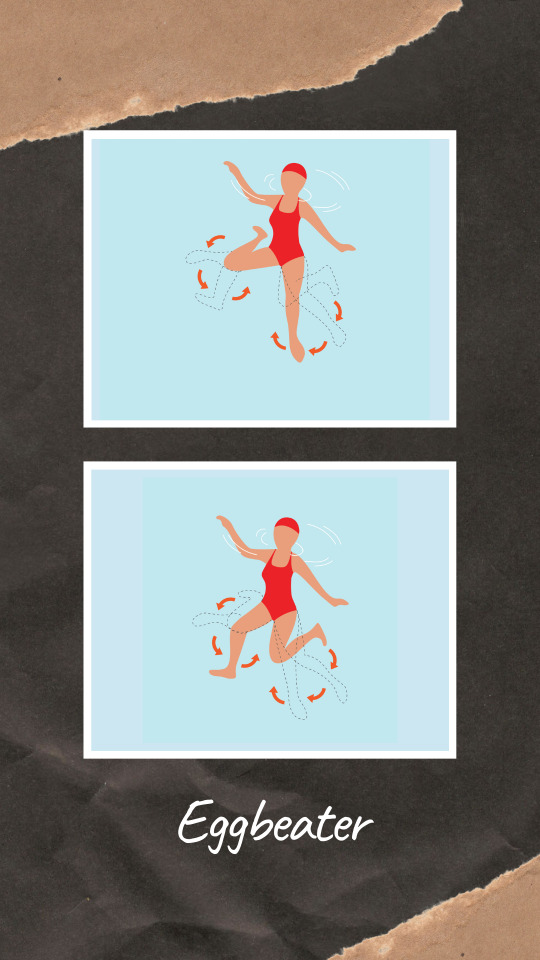
Eggbeater
This move is much like how a manual eggbeater works, with one leg rotating in a clockwise manner and rotating the other leg in an anti-clockwise manner. Artistic swimmers use this kick because it leaves their hands free to perform strokes. Due to the opposite motion of the kick, it is a stable and efficient way for swimmers to attain the necessary height to perform moves above the water.
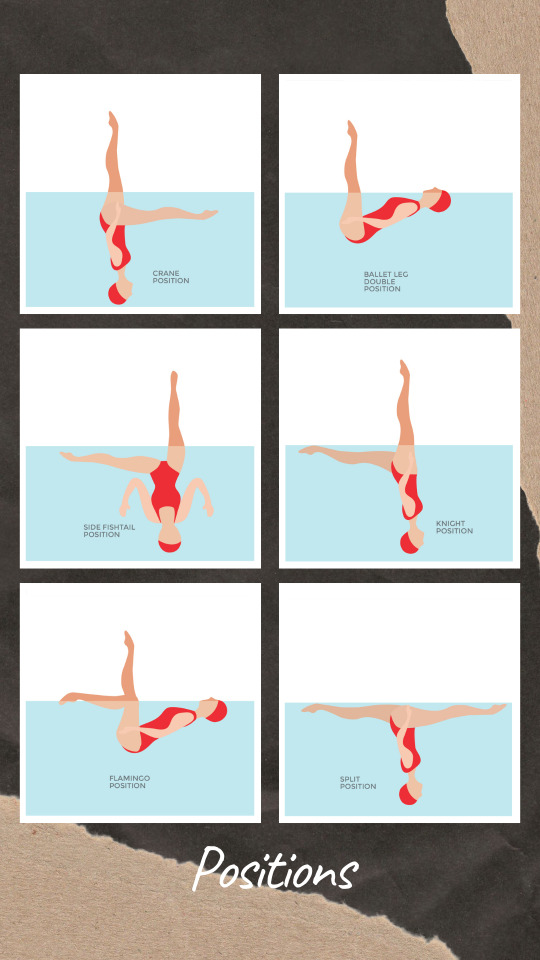
Positions
Crane Position - Hold your body in a vertical position with one leg held vertically above the water surface, while the other leg is held parallel under the surface in a 90-degree angle or "L" shape.
Ballet Leg Double Position - From lying flat on the water surface, draw your knees towards your chest with shins parallel to the water surface. Straighten your legs above the water surface to assume a Surface Ballet Leg Double position.
Side Fishtail Position - This is a position similar to the crane. One leg remains vertical, while the other is extended to the side parallel to the water, creating a side "Y" position.
Knight Position -The body is held vertically with your head in line with the hips and pointed to the bottom of the pool. One leg is lowered to create a vertical line perpendicular to the surface.
Flamingo Position - Similar to the ballet leg position where the bottom leg is pulled into the chest so that the shin of the bottom leg is touching the knee of the vertical leg.
Split Position - With the body vertical, one leg is stretched forward along the surface and the other leg is extended back along the surface.
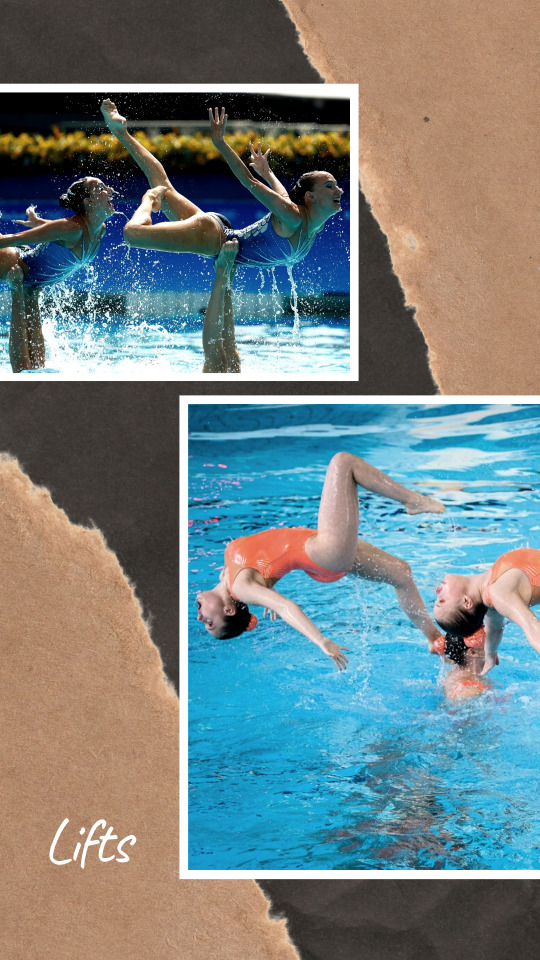
Lifts
Lifts are formations that are formed underwater and as swimmers propel themselves towards the surface, they stay in formation and add more elements like acrobatics.
The Flyer - Flyers are agile and flexible and are usually the smallest member of the team. It is preferable that they have a gymnastics background as they need to perform complicated moves while on the top of the formation.
The Base - Base swimmers tends to be small in size, but should have good leg strength and a solid core as they make up the structure of the formation.
The Pushers - Pushers are the bigger and stronger swimmers because they need the strength to propel the formation to the water surface.
Types of Lifts
The Platform Lift - The base lays out in a back layout position underwater, where they lie on their back to form a platform of interlinked bodies. The Flyer sets in a squatting position and stands once the lift reaches the surface. The remaining teammates use the eggbeater kicks to hold the platform and the flyer out of the water.
The Stack Lift - Considered to be an updated version of the Platform, the Stack Lift begins with the base squatting while underwater, supported by the pushers. The flyer then stands on the shoulders of the base. The pushers and base gradually stretch out their limbs, elevating the flyer. A rotating descent is usually added to this lift.
(Sport Singapore, n.d.)
Technical and Tactical Skills of Egypt
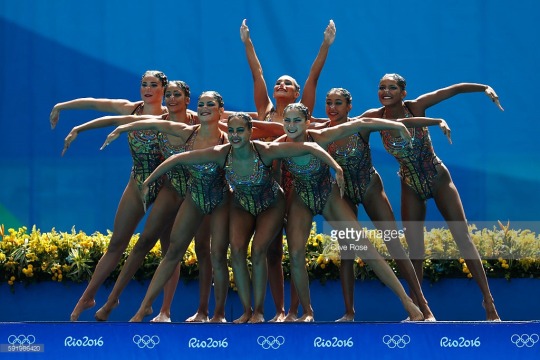
Egypt showed us minimal flips and were usually done at a lower height. I noticed that before the flyer would flip, her head is not completely submerged in the water, which kind of ruins the element of surprise. They ensured having a secure base at the bottom of the pool for the flyer to have a sturdy place to push on because they often take a longer time to build their formation. I also noticed a few synchronization errors at the near end of the performance because normally these performances could be very tiring.
Execution: 23.50; Artistic Impression: 31.4667; Difficulty: 23.6; Penalty: 0; Technical Routine: 76.9838; Free Routine: 78.5667; Total: 155.5505
Technical and Tactical Skills of Australia
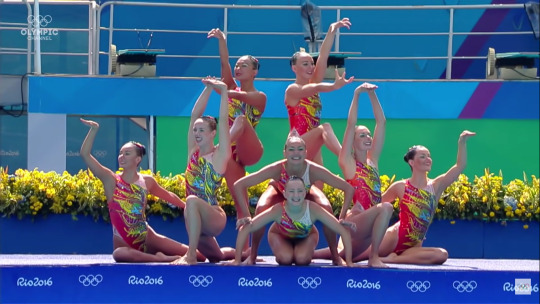
One thing that caught my attention about Australia is their theme. They had a theme of Flora and Fauna which was really cute and well thought of. They showcased a really artistic start matching their lifts and flips to the music. Their performance focused on the legs; quick movements and successions were shown in most parts of the performance. They showed us various positions and were very synchronized.
Execution: 22.60; Artistic Impression: 30.1333; Difficulty: 22.70; Penalty: 0; Technical Routine: 74.0667; Free Routine: 75.4333; Total: 149.50
Technical and Tactical Skills of Italy
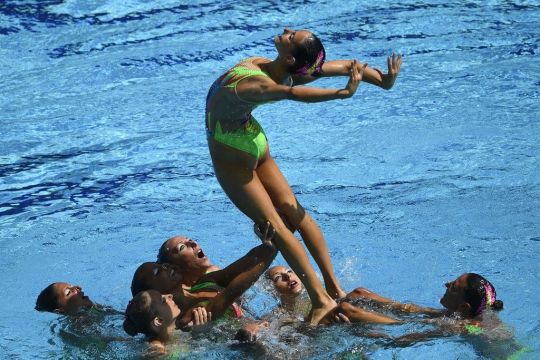
Italy chose the perfect music for their theme, the four seasons. They truly took their theme seriously as we can evidently tell from the transitions, the music, and the movements the changes of the seasons. They did more flips than the previous performers. They also chose strong and bigger swimmers for the base and the pushers. They were also very particular with the angles of their legs and their flip showed higher risk.
Execution: 27.50; Artistic Impression: 37.0667; Difficulty: 27.70; Penalty: 0; Technical Routine: 91.1142; Free Routine: 92.2667; Total: 183.3809
Technical and Tactical Skills of Brazil
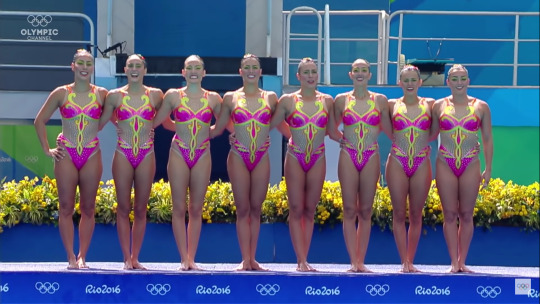
Brazil showed us their balance as they lifted a swimmer up. The movements were very quick and matched very well with their music. Their theme was the Carnivale which made their performance extra fun and energetic. Their facial expressions was the best part of their performance as they got to engage their appeal with the audience.
Execution: 26.10; Artistic Impression: 34.80; Difficulty: 26.30; Penalty: 0; Technical Routine: 84.7985; Free Routine: 87.20; Total: 171.9985
Technical and Tactical Skills of the Russian Federation
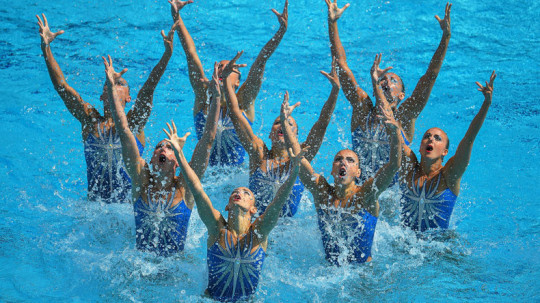
The Russians had a theme of Angels. They showed us that there is never a limit to perfection. The precision of the length of the legs were extraordinary. Not to mention their good start with an explosive high flip. The power and energy in their performance was unmatched. They were very flexible and showcased acrobatic moves. Their choreography was original & unique and they executed all their movements with a high degree of difficulty. The element of surprise was their level of expertise.
Execution: 29.70; Artistic Impression: 39.7333; Difficulty: 29.70; Penalty: 0; Technical Routine: 97.0106; Free Routine: 99.1333; Total: 196.1439
Technical and Tactical Skills of Ukraine
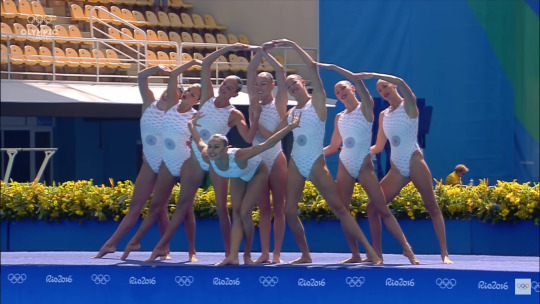
Ukraine's theme was illusionism which was already very evident from their costumes. They started off their performance with a very high flip. They made a lot splash throughout the performance which made it visually appealing. From the split camera we can observed that they are very synchronized even underwater where the judges couldn’t see them. They portrayed their theme very well.
Execution: 28.20; Artistic Impression: 38.2667; Difficulty: 28.70; Penalty: 0; Technical Routine: 93.4413; Free Routine: 95.1667; Total: 188.6080
Technical and Tactical Skills of People’s Republic of China
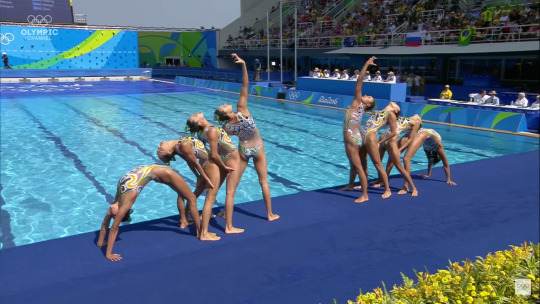
China showed extreme creativity from their performance to their costumes. The headdress was very unique and portrayed their theme very well which was Finding Dragons. The way they interpret the music was great, they showed several powerful flips and movements. Their performance was very dynamic, as well as their facial expressions were amazing.
Execution: 29.10; Artistic Impression: 39.0667; Difficulty: 29.20; Penalty: 0; Technical Routine: 95.6174; Free Routine: 97.3667; Total: 192.9841
Technical and Tactical Skills of Japan
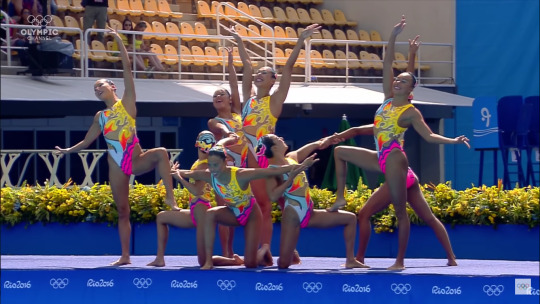
Japan also showed us a great start, with a powerful flip. They were very particular with the lines and their formations. The angle of their legs were always in uniform. Their theme: Dawn Start of a New Glory Towards the Sun was very creative. Their overall performance was very entertaining.
Execution: 28.50; Artistic Impression: 38.1333; Difficulty: 28.80; Penalty: 0; Technical Routine: 93.7723; Free Routine: 95.4333; Total: 189.2056
Rules of the Game
No Touching The Bottom
One of the things which makes the lifts all the more impressive is that artistic swimmers are not allowed to touch the bottom of the pool at any point during their routines.
No Bling
Presentation is a unique and important part of artistic swimming but there are certain restrictions on what swimmers can wear. For example, artistic swimmers are not permitted jewelery, theatrical make-up, or inappropriate costumes.
No Goggles
Another restriction during artistic swimming routines is goggles. However, swimmers in figures competitions are permitted to wear them.
Team Means Team
Teams normally contain eight swimmers, but the minimum number for a team is four. Teams lose marks for every swimmer they have under the full complement because it is easier to synchronize the fewer people there are in a routine.
Stick To The Schedule
Routines can be anything from two and a half minutes to five minutes long, depending on whether they are performed alone or as part of a team. However, swimmers are penalized if they take 15 seconds fewer or longer than the specified time.
Technical Routine & Free Routine
This involves performing predetermined elements that must be executed in a specific order. The free routine has no requirements so the swimmers can be ‘free’ in how creative they get with the movements and their choreography.
The routines are performed in front of sets of judges, who use strict guidelines to score the performances.
As well as technical and free routines, there are competitions called ‘figures’ for junior swimmers where they perform set movements to the judges. There is no music and this is simply a case of how well the individual performs various synchro moves.
(Swim England Artistic Swimming, n.d.)
How to Officiate the Sport
Timekeeper
The role of a timekeeper is to check and record the overall times of the routines and of the deck movements. If the time limit for the deck work is exceeded or there is a deviation from the permitted routine time allowance, the timekeeper advises the referee.
Clerk of the course
The role of a clerk of the course is to organize the competitors so that they are ready for their events at the required time. During figure competitions, they ensure that the swimmers are in the correct order to perform their figures.
Scorer
The role of a synchro scorer is to record marks from the judges and make the necessary computations for each routine. There are two levels of synchro scorer – national scorer and chief recorder.
National scorers write down and manipulate all the scores that come in for figures and routines at competitions. They can officiate at any level of domestic competition including the National Age Group Championships and ASA National Championships.
Chief recorders are in charge of scoring at synchronized swimming events. They are trained to manage related computer results systems at national and regional competitions.
Judge
Synchro judges are essential for running synchronized swimming competitions as they provide scores based on the performance of each routine. They are also responsible for marking grade level assessments. To reduce the level of subjectivity in scoring, all synchro judges must be expertly-trained. They require a full understanding of FINA and the ASA’s rules and regulations for synchronized swimming competitions.
To maintain their qualification or progress, all judges must officiate at a certain number of grade assessments and competitions.
There are three levels of Judge:
Level 1: Candidates must be 16 years old to take the level 1 judge course. They will be qualified to judge at level 1 and 2 competitions. The course includes:
Use of marking scales
Develop understanding of basic movements and positions
Able to identify Figures in current age groups (12U and 13/14/15)
Ethics
Develop knowledge and understanding of Free Routines
Knowledge of Grade 1 and 2 criteria and assessment criteria
Level 2: Candidates must have been a level 1 judge for at least a year. They will be qualified to judge at regional competitions at the National Age Group Championships. The course includes:
In-depth knowledge of Junior Figures (15-18 years)
Develop knowledge of rules and penalties
Develop knowledge of NVT, difficulty values and application to figures. Application of deductions to figures
Exposure to variety of level of figures and scores
Knowledge and awareness of Grade 3/4/5 criteria
Further analysis of Free Routines – range of level of routines, recognition of difficulty
Level 3: Candidates must have been a level 2 judge for at least a year. They will be qualified to judge at the National Championships. The course includes:
Further knowledge about rules, penalties and organisation
In-depth knowledge about judging Figures and component parts
Further develop knowledge and aptitude regarding judging Free Routines
Awareness of Grade 6 criteria
In-depth knowledge of technical elements across solos, duets and team
Referee
The role of a synchro referee is to oversee the control of a synchronized swimming competition. The referee makes sure all aspects of the event are run smoothly and follow FINA rules.
All candidates on a referee training course must be a qualified synchro judge, a current ASA member and over 18. The training consists of a five-hour training course and examination. Following completion of the training, a mentor will be appointed to successful candidates to provide support at their first event. After ratification of the results by the ASA Synchronized Swimming Management Group, the qualification will then be added to the Database of Registered Officials.
The qualification as a referee will be valid for four years, subject to attending any refresher/ updating sessions required due to the introduction of new FINA rules over this period. A referee must re-qualify every four years by attending either a judge training course which includes all the new FINA updates or another referee training course.
(Edinburgh, n.d.)
Bibliography
Edinburgh. (n.d.). Retrieved from Officials in synchro: http://edinburghsynchro.co.uk/officials-in-synchro/
Sport Singapore. (2020). Retrieved from Basic skills and positions in Synchronised Swimming: https://www.myactivesg.com/Sports/Aquatics/How-To-Play/Synchronised-Swimming/Basic-skills-and-positions-in-Synchronised-Swimming#:~:text=The%20basic%20skills%20you%20will,to%20combine%20into%20a%20routine.
Swim England Artistic Swimming. (n.d.). Retrieved from Swimming.org: https://www.swimming.org/artistic-swimming/introduction-to-artistic-swimming/
Tokyo 2020. (2020, February 15). Retrieved from Artistic Swimming: https://tokyo2020.org/en/sports/artistic-swimming/#:~:text=In%20a%20pool%20at%20least,routines%20are%20performed%20to%20music.
Tutorials Point. (n.d.). Retrieved from Synchronized Swimming - Equipment: https://www.tutorialspoint.com/synchronized_swimming/synchronized_swimming_equipment.htm
Photo Credits
https://www.telegraph.co.uk/content/dam/olympics/2016/07/28/104282891_RIO_DE_JANEIRO_BRAZIL_-_FEBRUARY_24__General_view_of_Maria_Lenk_Aquatics_Centre_during_the_trans_NvBQzQNjv4BqgsaO8O78rhmZrDxTlQBjdGtT0gK_6EfZT336f62EI5U.jpg?imwidth=450
https://images.cdn-outlet.com/images/article/isport/image/Synch%20Swim_SupportSc1%23855408(1).jpg
http://egyptianstreets.com/wp-content/uploads/2016/08/591966420.jpg
Template
Canva
Video Reference
https://www.youtube.com/watch?v=dRGQDubSAqw
1 note
·
View note
Text
Golden Kamuy Volume 1 Data Hunting
So this is a collection of assorted information about Golden Kamuy Vol 1 inclusive of data, points to ponder, notable quotes and so on.
It was a terribly long work and I don’t expect it to be perfect. If you notice something is wrong (especially in the translation from Japanese) or missing please, feel free to drop me a note.
I will try to do something similar for vol 2 as well but I don’t promise at all I’ll manage it.
Anyway, I’ll hope you’ll enjoy this!
VOLUME 1

Cover: Sugimoto Saichi
Chapters: 7
First printed: 19/January/2015
Volume only extras: A page explaining the Blakiston line, a map of Hokkaido and south Karafuto, Asirpa wearing an Attus, frontal and back image, the Ainu sentence ‘Kanto orwa yaku sak no arankep shinep ka isam’ (“Nothing comes from heaven without purpose”).
GENERAL INFO
Notable or recurring Characters: Sugimoto Saichi (杉元 佐一), Gotō (後藤), Wilk (ウイルク), Retar (レタㇻ), Toraji (寅次), Umeko (梅子), Toraji and Umeko’s child, Asirpa (アシㇼパ), pimp (妓夫太郎 ‘Gifutarō’), prisoner who was tailing Sugimoto’s group (杉元達を尾行していた囚人 ‘Sugimoto-tachi o Bikō Shite Ita Shūjin’), Hijikata Toshizō (土方 歳三) , Ogata Hyakunosuke (尾形 百之助), Tsurumi Tokushirō (鶴見 篤四郎), Shiraishi Yoshitake (白石 由竹), Wilk (ウイルク), Tsuyama (津山).
Maps of the places mentioned:

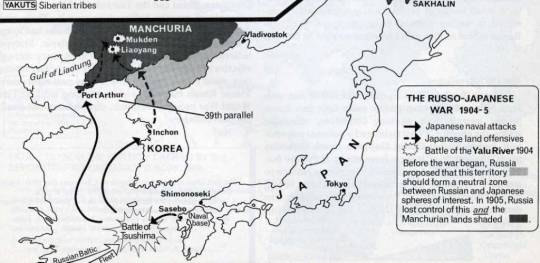
Meiji years mentioned: Meiji 1= 1868, Meiji 2= 1869, Meiji 23= 1890, Meiji 37=1904, Meiji 38= 1905, Meiji 40= 1907, Meiji 41= 1908, Meiji 44= 1912.
Weapons used:
- Arisaka Type 30 rifle: Japanese soldiers, Sugimoto, Toraji, Gotō, Ogata
- Arisaka Type 30 bayonet: Sugimoto, Ogata
- Mosin–Nagant M1891 rifle: Russian soldiers
- Ainu bow (Karimpaunku) and aconite poisoned arrow (Ay): Asirpa
- Ainu short knife for women (Menomakiri): Asirpa
- Ainu hunting knife (Tasiro): Asirpa
- Sharp stake: Ainu hunters
- Koishikawa Arsenal Type 26 revolver: prisoner who was tailing Sugimoto’s group, Sugimoto
- Murata Sword: Hijikata
Convict appeared and their tattoo owners (at the end of the volume):
1. Gotō: Sugimoto
2. Prisoner who was tailing Sugimoto’s group: Sugimoto
3. Hijikata Toshizō: Hijikata
4. Shiraishi Yoshitake: Shiraishi, Sugimoto (copy)
5. Tsuyama (Tsurumi)
------------------------------------------------------------------------------
01. SUGIMOTO, THE IMMORTAL (不死身の杉元 FUJIMI NO SUGIMOTO)

First printed: 21/August/2014 Weekly Young Jump 38
Characters: Sugimoto Saichi (杉元 佐一), Gotō (後藤), Wilk (ウイルク), Retar (レタㇻ), Toraji (寅次), Umeko (梅子), Toraji and Umeko’s child, Asirpa (アシㇼパ).
Location: Near Otaru.
Other Places mentioned: 203 hill in Port Arthur (current Lüshunkou) (China), Abashiri Prison in Abashiri.
Time: 1907/1908 (?) Late February
Historical events mentioned: Russo-Japanese war (8 February 1904 – 5 September 1905) Siege of Port Arthur (1 August 1904 – 2 January 1905), Hokkaido Gold Rush (1617), Meiji Restoration (4 January 1868)
Includes flashbacks or info about the characters past: Yes, about Sugimoto, Toraji, Umeko and their kid.
Info and the characters’ theories about the ‘Noppera-bō incident’, the gold and the escape:
Hokkaido gold rush caused Ainu to store up 75 Kg of gold to fight the Japanese, who even after the Meiji Restoration were oppressing them by forbidding them to hunt salmon or deer, and stealing their lands. And then a single man stole it all, and killed the Ainu who owned it. The police were after the man, so he hid the gold somewhere in Hokkaido. But he was caught before he could tell anyone where it was, and thrown into Abashiri Prison, to be sentenced to death. He wanted to tell his comrades on the outside where the gold was, but he never wrote a letter as the guards would just steal it. No matter what they did to him, he didn't tell anyone where the gold was. In the end, one of the guards turned out to be a horrible man. He cut the tendon of one of the man's legs so he couldn't escape. So he tattooed on the bodies of his fellow inmates a code that revealed the location of the treasure. He mixed charcoal with saliva, and then slowly carved that ink in with a needle he'd kept hidden. Only his comrades on the outside can decrypt the code and this is what he said to the other prisoners: “Escape from this prison. Whoever succeeds can have half the treasure.” To crack the code, one needs all the prisoners' tattoos. Some of the lower members of the military heard the rumors about the tattoos and dragged the prisoners out of their cell, saying they were going to "transport" them as they were after the gold, too but that was the prisoners' chance to escape. The prisoners killed all the soldiers, and every last one disappeared into the forest. Nobody's caught them. And nobody knows what happened to the gold, either. (Source: Gotō)
Asirpa’s father was also among the men killed that night, during the ‘Noppera-bō incident’. (Source: Asirpa)
Character deaths: Japanese soldiers (shoot by the Russians), 6 Russians (killed by Sugimoto), 7 Ainu (killed in the Noppera-bō incident), guards that were transporting the prisoners (killed by the prisoners), Toraji (during the war), Gotō (killed by a bear)
Animal deaths: mother bear (killed by Asirpa), bear cub (killed by a bear)
New Ainu words:
- Kamuy: “God”
- Kanto orwa yaku sak no arankep shinep ka isam: Nothing comes from heaven without purpose
- Attus: “Bark”. Traditional Ainu coat made from fibers harvested from the bark of the Manchurian elm or the Japanese linden
- Ainu: “Human being”. It seems however that among Ainu, you called Ainu only the men after the age of thirty, giving it the meaning of “man” more than just human.
- Matakarip: “Those that move in winter”. Bear which missed hibernation.
Food and drinks: Ant, Sake
Useful info and points to ponder:
- The first page of the chapter is coloured in red and green. All the soldiers are green except for Sugimoto who’s red, making him easily identifiable. The choice of the red though fits with the fact he’s the main character (in many colour coded groups the red character is the main character) but also with how red is one of Sugimoto’s colours (the cover of the volume has him in predominantly red colours despite the fact Sugimoto’s coat should have been blue) as red well fit with Sugimoto’s character.
- Sugimoto calls the Russians ‘Roske’ (露スケ) “Russky” (also written as 露助). The anime however preferred to change this, having him refer to them as ‘Roshia’ (ロシア) “Russians”.
- Gotō uses ‘-san’ to talk with Sugimoto. Sugimoto never refers to him by name, just with ‘Anta’ (あんた “You”) or ‘Oyaji’ (オヤジ “Old man”).
- As Gotō calls him, Sugimoto instinctively removes his hat as if to greet him to place it back on his head, realizing it’s just him. It’s notable because Sugimoto hardly removes his army cap.
- When talking with Gotō Sugimoto will remarks that he wants money, that he needs it. Later, when talking with Asirpa he’ll remark he needs money more than anything.
- Sugimoto took part to the Russo-Japanese war during which he fought like a ‘Kishin’ (鬼神 “Demon god”/“Ogre god”) (for more info go here) and was nicknamed ‘Fujimi no Sugimoto’ (不死身の杉元 “Sugimoto, the Immortal” [Lit: “Sugimoto, the not-dying”]) because despite the serious wound he received he didn’t die and healed fast.
- Sugimoto explains he didn’t get a medal and a cozy retirement because he almost killed an official he didn’t like (‘Kiniiranai’ 気に入らない “he didn’t please me/suit me”). This was never developed further though I hope the ‘didn’t please me’ is actually a Japanese polite way to say ‘he was a jerk’ otherwise Sugimoto had quite an overreaction. On another side attacking a superior officer was quite a serious crime that could warrant you a dead sentence so Sugimoto really got it easy.
- The “Order of the Golden Kite” (金鵄勲章 ‘Kinshi Kunshō’) was an exclusively military award, conferred for bravery, leadership or command in battle. It ranked just below the Order of the Chrysanthemum, Japan’s highest order. The award came with an annual monetary stipend and was awarded for the lifetime of the recipient, and following his death, it would be awarded to the recipient's family for one year after.
- When Gotō talks about the Ainu collecting the gold he says the Ainu were going to fight against the Japanese that EVEN AFTER THE MEIJI RESTORATION had stolen their land and forbidden fishing and hunting. The bit about the Meiji restoration is cut in the scanlations but it implies that the facts are taking place AFTER 1868. Instead, while the stealing took place after that date, the collecting took place much, much before. This will become relevant later on because, as soon as they boys will discover it, they’ll realize the gold is much more than they were told.
- The word used for tattoo is ‘Irezumi’ (入れ墨 lit: "inserting ink") and, during the Edo period (1603–1868), it referred to the tattoos tattooed to criminals' faces or arms, which marked that they had been found guilty of their crimes. Yakuza often would also have tattoo that were obligatory in some clans and had birth in protest for the branding of criminals with tattoo. However not all the tattoo had a negative meaning in Japan. ‘Horimono’ (彫り物 Lit: “carved/engraved thing”) were large tattoos, which covers a person's whole back, or arms, or chest, or full-body that weren't branded on criminals but on fishermen, firemen, and so on, people who had jobs were they wouldn't be wearing many clothes, so their skin, and the tattoo, would be visible most of the time. Buddhist priests would also have tattooed on themselves sutras or religious designs while ‘Irezumiko’ (入墨子) were the tattoos sex workers would make to show their romantic devotion to their regular customer and it would start with the customer's name, and end with inochi (命), meaning life. In total, the tattoo meant "I devote my life to (customer's name)".
- Gotō told Sugimoto he saw an Hokkaido wolf, and although the latter didn’t believe him as he thinks they’re extinct, this might mean Gotō spotted Retar.
- Sugimoto remembered/dreamed his friend Toraji told him to go with him to Hokkaido to search for gold because he wanted his kid to go to college so he doesn’t grow up to be an idiot like him, escaping from a life of poverty and a good doctor to look at his wife, Umeko as his eyesight is getting worse every day. Toraji heard from an American pal of his working for the railroad industry that America has the best eye doctors so he estimated for the boat fare and the operation a cost of 200 yen with the boat fare doubling if he goes with her. In his dream Toraji told him he has to hurry as relations with America will worse after the war and begged him, crying, to take care of Umeko for him, as they had been friends all their lives and nobody will want a woman with bad eyes and a kid. Sugimoto then saw Toraji being limbless and with intestines exposed sinking in a pool of blood as he claimed “I can’t go back to Japan” (俺は日本に帰れない ‘Ore wa Nihon ni kaerenai’).
- Although when Gotō attacked him it was kill or be killed, Sugimoto didn’t kill him. When he chased him his first though was he clearly wanted to know more about what Gotō knew but then he talked himself into how he was chasing him because otherwise Gotō would kill him.
- The poison on Asirpa’s arrow is a fast-acting one made from a red stingray spine and aconite root but a brown bear can move for 10 second after being hit by it.
- Sugimoto refers to the bears as “Monsters” (バケモノ ‘Bakemono’)
- When talking about Toraji first Sugimoto defines him as his childhood friend (‘Osananajimi’ [幼なじみ “childhood friend”]) then switches to comrade (‘Senyū’ [戦友 “comrade in arms/war buddy”]).
- When asked about what he wanted to do with Gotō’s body by Asirpa, Sugimoto at first claimed he wanted to take him to a nearby village, skipping to mention he planned to use him to find the Ainu gold and only when Asirpa told him he would have to kill the bear to keep it he told her the truth, begging her to help him to kill the bear.
- In scanlations Asirpa claims that night will be a moonless night, which clashes with the fact in the next chapter we’ll see a full moon in the sky but in the Japanese version her sentence might be read as ‘the moon won’t appear’ (because hidden by clouds). In fact in the next chapter for a while it will be pitch black then the moon will appear from behind the clouds.
- Umeko calls Sugimoto ‘Saichi-chan’ (佐一ちゃん) and he calls her just ‘Ume-chan’ (梅ちゃん).
- Asirpa believed her father was among the Ainu killed THAT NIGHT.
- The way the tattoo wraps around the chest and arms and is sectioned off at the median lines of his body is the same way one would mark a bear or a deer before skinning it. This, according to Asirpa, implies the man tattooing them never wanted to share the gold with the prisoners but wanted them to be skinned.
- Gotō might look like a plot device to let Sugimoto know about the gold, set him on chasing it and helping him to meet up with Asirpa however he’s also a symbolic representation of the temptation for Sugimoto (Sugimoto has stopped killing people but if he tries to chase the gold he’ll resume doing so), but he can also work as an interesting parallel with Sugimoto. Our first impression of him is of a harmless, friendly drunkard. When he later tries to kill Sugimoto it’s obviously because he feared for his own life, not out of hate or cruelty. However late it’ll turn up he ended in Abashiri because he got drunk and while drunk he ended up killing his wife and kid. In short he lost control of himself and ended up murdering his family. And much later Sugimoto will have troubles controlling himself.
Notable changes from the magazine version: None
Notable quotes:
- Sugimoto: “Worse comes to worst, we take a bite out of one of those damn Russians. I won’t die here.” (‘Iza to nattara buttobashita Roske no shiroi ketsu o kajitte demo ore wa ikinuite yaru’ いざとなったらぶつ殺した露スケの白いケツをかじってでも俺は生き抜いてやる Lit: “When the moment come, even if I’ve to take a bite out of the white asses of the Russkies I’ll kill, I will survive.”)
- Sugimoto: “I want money. I need money.” (‘Kane ga hoshī. Kane ga hitsuyōna nda’ カネが欲しい。カネが必要なんだ)
- Gotō: “They called you… ‘Sugimoto the immortal,’ didn't they? They say you fought like you were possessed by The devil himself. That you were running around the day after receiving a mortal wound. bayonets, bullets, cannonballs. None of them could take you down. Are the stories true?” (‘Fujimi no Sugimoto tte yoba re teta n datte? Kishin no yōna tatakai-buridatta-sō janai ka. Hinshi no jūshō o otte mo yokujitsu ni wa hashirimawatteru. Jūken demo kikan jū demo hōdan demo sugi moto o korosenai tte… hontona no? Sono-wa?’ 「不死身の杉元」って呼ばれてたんだって?鬼神のような戦いぶりだったそうじゃないか。瀕死の重傷を負っても翌日には走り回ってる。銃剣でも機関銃でも砲弾でも杉元を殺せないって…ほんとなの?その話?Lit: “You were called Immortal Sugimoto, weren’t you? It seems that you fought like a Kishin. Even though you were seriously injured, you would run around the next day. A bayonet, a machine gun, or a shell can’t kill Sugimoto... is it true? This story?”)
- Sugimoto: “They’re true. I just don't seem to die.” (‘Nakanaka shinenai mon sa’ なかなか死ねないもんさ Lit: “It’s hard to die for me.”)
- Sugimoto: “If I hadn’t nearly killed an officer that pissed me off… I’d have the order of the golden kite, and be enjoying a cosy retirement right now.” (‘Kiniiranai jōkan o hangoroshi nakya kinshi kunshō moratte imagoro wa nukunuku nenkin kurashida’ 気に入らない上官を半殺しなきゃ金鵄勲章もらって今頃はぬくぬく年金暮らしだ Lit: “If I hadn’t half killed a superior officer I don't like I would have received the Order of the Golden Kite and nowadays I would be living thanks to my cosy retirement.”)
- Wilk: “Break out of here. I'll split half the gold ingot among anyone who succeed” (‘Koko kara datsugoku shiro. Seikō shita yakko ni wa kinkai o hanbun yaru’ ここから脱獄しろ。 成功した奴には金塊を半分やる Lit: “Jailbreak from here. To the successful guy I’ll give half of the gold.”)
- Gotō: “The tattoos on all the prisoners only had meaning when they were combined.” (‘“Shūjin tara no irezumi wa zen'in de hitotsu no angō ni natte irurashī”’ 「囚人たらの入れ墨は全員でひとつの暗号になっているらしい」Lit: “‘It seems the tattoos on the prisoners were all forming a single encrypted code.’”)
- Toraji: “I can’t go back to Japan” (‘Ore wa Nihon ni kaerenai’ 俺は日本に帰れない).
- Sugimoto: “So then…what was that crazy story he was just telling me? Suddenly it's starting to sound a lot less crazy. Maybe he knows something else.” (‘Nanda yo… sakki no yotabana ga kyū ni shinjitsumi o obite kita jane~e ka! Aitsu mada nani ka shitteru no ka?’ なんだよ… さっきの与太話が急に真実味を帯びてきたじゃねぇか!あいつまだ何か知ってるのか?“What's going on... That gossip story suddenly tinged with truth! Does he still know anything?”)
- Sugimoto: “It’s kill or be killed” (‘Yara reru mae ni yaru shika’ やられる前にやるしか Lit: “I have to do it before him”)
- Asirpa: “It'll get extremely dark soon. There won’t be a moon tonight. It’ll be so dark you can’t see your own hands.” (‘Mō sogu makkura ni naru kon'ya wa tsuki ga denaikara jibun no te mo mienaku naru’ もうそぐ真っ暗になる今夜は月が出ないから自分の手も見えなくなる Lit: “It'll get extremely dark soon. Tonight the moon isn’t visible so it’ll be so dark you can’t see your own hands.”)
- Asirpa: “The weak get eaten” (‘Yowai yatsu wa kuwareru’ 弱い奴は食われる)
- Sugimoto: “It was my childhood friend… my comrade’s request” (Osananajimi de Sen'yū ga nokoshita saigo no tanomi’ 幼なじみで 戦友が残した最後の頼み lit: “My childhood friend… my comrade left me with this last request”)
- Sugimoto: “I need money more than anything!” (‘Dōshitemo kane ga hitsuyō nanda’ どうしてもカネが必要なんだ)
- Sugimoto: “So basically… they had planned all along to kill and skin him. And that's why he has tattooed like this?” (‘Tsumari… koroshite kawa o hagu koto ga zentei de kono irezumi wa hora rete iru tte koto ka?’ つまり… 殺して皮を剥ぐことが前提でこの入れ墨は彫られているってことか? Lit: “I mean ... is this tattoo engraved like that on the premise of killing and skinning him?”)
------------------------------------------------------------------------------
02. WEN KAMUY (ウェンカムイ WEN KAMUY)

First printed: 21/August/2014 Weekly Young Jump 38
Characters: Sugimoto Saichi (杉元 佐一), Asirpa (アシㇼパ), Gotō (後藤), Wilk (ウイルク), Retar (レタㇻ).
Location: Near Otaru.
Other Places mentioned: None
Time: 1907/1908 (?) Late February, 12 hours before sunrise (In Sapporo from Feb 16 to Feb 28 sunset is at 5:14PM and sunrise is at 6:22 AM so we’re at around 6:00 PM)
Historical events mentioned: Hokkaido Wolf extinction (1890)
Includes flashbacks or info about the characters past: None.
Info and the characters’ theories about the ‘Noppera-bō incident’, the gold and the escape:
Five years ago Asirpa’s father and six men from other villages were killed while transporting the gold to a new hiding place. Their bodies were chopped up and animals got them, scattering their remains. One of the lump of flesh resembled Asirpa’s father. Ainu were never even told that the man who'd killed them was arrested and sent to Abashiri prison, let alone anything about the tattooed prisoners. (Source: Asirpa)
Anybody involved with the case has probably been tight-lipped with the facts, since they’re all trying to get the gold themselves. (Source: Sugimoto)
Since Gotō is still living in hiding, this means the gold wasn’t found and the people in charge in the prison won’t execute the one who murdered Asirpa’s father and the others until they find the gold but the minute the gold is found the man’s life is forfeit. (Source: Sugimoto)
Character deaths: 2 Russians (killed by Sugimoto)
Animal deaths: Bear (killed by Sugimoto)
New Ainu words:
- Wen Kamuy: “Evil God”. Animal God which killed a human and can’t eat anything else but humans so he no longer fears humans and turn violent and dangerous.
- Sitat: Bark from white birch trees.
- Retar: White
- Sisam: “By my side”. Non-Ainu Japanese people.
- Asirpa: “New Year/Future”
- Teine Pokna Mosir: “Wet Underground World”. An Ainu hell in which all souls who do evil and commit taboo are sent after their death. It is a dark, cold, muddy and damp place, the lowest netherworld out of six. Being there is like a live burial, suffocating and lonely in a sort of karmic payback in which to hurt another is to dig a grave for yourself.
Food and drinks: Bear meat
Useful info and points to ponder:
- When Asirpa praises Sugimoto as a good warrior she comments it’s impressive ‘for a Sisam’ (a not Ainu). Actually Ainu didn’t have the monopoly of brave warriors so her comment comes out as prejudiced.
- Asirpa calls Sugimoto ‘Sisam’ until he’ll introduces himself as Sugimoto Saichi. Then she’ll call him just ‘Sugimoto’.
- After learning her name, Sugimoto calls Asirpa, ‘Asirpa-san’.
- Asirpa’s Ainu name (アシㇼパ) is written with a small ‘ri’ that needs to be read as just ‘r’ while the ‘shi’ needs to be read as ‘si’. Now, in the manga, Japanese characters usually write/pronounce Ainu words in the Japanese way (‘Citatap’ becomes ‘Citatapu’) while Ainu pronounce them in the correct way. However in Asirpa’s name case it seems everyone writes/pronounces it correctly, with a small ‘ri’ (though I’ve heard in the fandom this is up to debate). The anime didn’t care AT ALL about this and had even Asirpa say ‘Ashiripa’.
- While Asirpa didn’t specifically say the Ainu men killed were of HER village, the context implied she believed they were and even Sugimoto assumed so. We know though, the men weren’t all from her village. The Doylist explanation is Noda retconned this, the Watsonian explanation is that Asirpa doesn’t remember the fact correctly as she was a child.
- Sugimoto asks Asirpa to team up with him to find the gold. He acknowledges it belongs to the Ainu in the first place so he won’t ask for 50:50, just for a share. When Asirpa refuses because this would mean track and kill the prisoners and she doesn’t want to kill anyone Sugimoto claims that by finding the gold, they’ll trigger the execution of her father’s murderer, ensuring she’ll get revenge for her father and that Asirpa helped him because this is exactly what she wanted, so he volunteers to be the one who dirties his hands as she’ll only have to share her knowledge with him.
- It’s worth to mention that, although Sugimoto didn’t ask for an even split, it was never exactly established how much Sugimoto wanted. The scanlations say he asked for a small share but in the Japanese version he asked just for a share (‘Wakemae’ 分け前), without claiming it also had to be small. He likely hoped it wouldn’t be as in chap 3 he said he would also become rich.
- Ainu do not eat a bear who killed a human nor take their fur.
- The last page of the chapter has two panels, in one there’s Sugimoto and Asirpa, Sugimoto claiming he’s in this for the money and Asirpa is in this for revenge and therefore their destinations are different but they’re walking the same path and together they can be unstoppable. The panel below shows the bodies of the convicts, implying their path is built above the corpses of the convicts.
Notable changes from the magazine version:
- In the magazine Asirpa says Retar’s name out loud, in the volume she just thinks it.
Notable quotes:
Asirpa: “When a brown bear kills a human, it is cursed to never be able to eat anything else.” (‘Higuma wa ichido ningen o korosu to batsu to shite ningen shika kuenaku naru.’ ヒグマは一度人間を殺すと罰として人間しか食えなくなる。Lit: “Once a brown bear kills a human, as punishment, he can only eat humans.”)
Asirpa: “It no longer fears humans and turns violent and dangerous, it becomes a Wen Kamuy (Evil god)” (‘Ningen o osorenai kyōbōde kiken'na Wen Kamuy (warui kami) ni naru.’ 人間を恐れない凶暴で危険なウェンカムイ(悪い神)になる。Lit: “He become a vicious and dangerous Wen Kamuy (evil god) who does not fear humans.”)
Sugimoto: “I guess the bear figures out just how weak human beings really are…” (‘Bare chimatta wakeda... Ningen-sama ga yowai ikimonodatta’ バレちまったわけだ… 人間様が弱い生き物だった Lit: “The bear understood it. . . Human beings are weak creatures.”)
Sugimoto: “Just try and kill me, dammit! I'm Sugimoto the immortal!” (‘Koroshite miro ~tsuore wa fujimi no Sugimoto da’ 殺してみろッ俺は不死身の杉元だ Lit: “Try to kill me! I'm Sugimoto the immortal!”)
Asirpa: “You're brave and know your way around a fight. A most capable warrior! Impressive, for a Sisam.” (‘Yūki to tatakai no sainō ga aru. Yūshūna senshida. Shisamu ni shite wa yaru na’ 勇気と戦いの才能がある。優秀な戦士だ。シサムにしてはやるな Lit: “You have courage and fighting talent. An excellent warrior. Impressive for someone who’s just a Sisam.”)
Asirpa: “My father and six other men from the village were killed while moving the gold stash to a new hiding place” (‘Chichi o fukume mura no otoko-tachi 7-mei wa kinkai no kakushibasho o idō sate iru dōchū ni korosa retarashī’ 父をふくめ村の男たち7名は金塊の隠し場所を移動さている道中に殺されたらしい Lit: “Seven men from the village, including my father, seemed to have been killed on the way while moving the gold to a new hiding place.”)
Sugimoto: “Listen, Asirpa. Let's team up and find this gold together. It belongs to your people in the first place, so I won't ask for 50:50. All I'm looking for is a small share.” (Nā Ashiripa-san. Ore to kunde kinkai o mitsukeyou. Moto wa anta-tachi no kinda. Yamawake to wa iwanai. Daga orenimo wakemae ga hoshī ‘’ なぁ アシㇼパさん。俺と組んで金塊を見つけよう。もとはあんた達の金だ。山分けとは言わない。だが俺にも分け前が欲しい Lit: “Hey, Asirpa-san. Team up with me to find the gold. Originally it was your people’s gold. I’m not saying to split it equally. But I also want a share.”)
Asirpa: “We ainu don't eat the meat of a man-eater. We don't take the fur either. A bear that does evil things and becomes an evil god is sent to a hell called Teine Pokna Mosiri” (‘Ainu wa hito o koroshita inoshishi wa kuwanai. Kegawa mo toranai. Warui koto o shita kuma wa warui kami to natte teinepokunamoshiri to iu jigoku ni okura reru’ アイヌは人を殺した熊の肉は食わない。毛皮も取らない。悪い事をした熊は悪い神となってテイネポクナモシリという地獄に送られる Lit: “Ainu do not eat the meat of bears who killed people. We also don't take its fur. A bear who does bad things becomes a evil god and is sent to a hell called Teine Pokna Mosiri”)
Asirpa: “I don’t want to kill anyone.” (‘Watashi mo hito o koroshitakunai’ わたしも人を殺したくない)
Sugimoto: “Killing people sends you to hell? then I guess they'll be rolling out the red carpet for me!” (‘Ningen o korose wa jigoku-ikidato ku? Sorenara ore wa tokutō sekida’ 人間を殺せは地獄行きだとく? それなら俺は特等席だ Lit: “Killing humans sends you to hell? Then I guess I’ll get a special seat!”)
Sugimoto: “I'll be the one getting their hands dirty. All you need to do is share your knowledge with me. I'm in it for the money. You're in it for revenge. Our destinations are different, but we're walking the same path. If we work together, we'll be unstoppable!” (‘Te o yogosu no wa ore ga yaru. Asirpa-san wa chie dake kashite kure. Ore wa kin de Asirpa -san wa oya no kyū. Mokuteki wa chigaedo michi wa onaji. Futari de te o kumeba oninikanabōda’ 手を汚すのは俺がやる。アシㇼパさんは知恵だけ貸してくれ。俺は金でアシㇼパさんは親の仇。目的は違えど道は同じ。二人で手を組めば鬼に金棒だ Lit: “Getting their hands dirty is what I’ll do. Asirpa-san, please lend me only your wisdom. I'm in for the gold and Asirpa-san is in for her parent's revenge. The purpose is different but the road is the same. If we join hands together we’ll give a metal rod to an ogre (we’ll be even stronger).”)
------------------------------------------------------------------------------
03. TRAP (罠 WANA)

First printed: 04/September/2014 Weekly Young Jump 40
Characters: Sugimoto Saichi (杉元 佐一), Asirpa (アシㇼパ), unnamed merchant, unnamed prostitute, Tokiko (時子), unnamed pimp (妓夫太郎 ‘Gifutarō’), unnamed prisoner who was tailing Sugimoto’s group (杉元達を尾行していた囚人 ‘Sugimoto-tachi o Bikō Shite Ita Shūjin’).
Location: Near Otaru and Otaru.
Other Places mentioned: Sapporo, Hakodate, Asahikawa, Southern Karafuto (current Southern Sachalin)
Time: 1907/1908 (?) Late February
Historical events mentioned: Russo-Japanese war (8 February 1904 – 5 September 1905)
Includes flashbacks or info about the characters past: None.
Info and the characters’ theories about the ‘Noppera-bō incident’, the gold and the escape:
If the escaped prisoners are still searching for the gold then they wouldn’t have run to mainland Japan but remain somewhere in Hokkaido. As they’re not animals they can’t survive hiding in the mountains and an outsider would stand out in a small village so Sugimoto imagine they would want to go to a big town and blend into the crowd. (Source: Sugimoto)
Character deaths: None.
Animal deaths: Squirrel (Killed by Asirpa’s trap).
New Ainu words:
- Ikayop: Quiver.
- Ay: Arrow.
- Karimpaunku: Bow wrapped in cherry tree bark.
- Tasiro: Hunting knife.
- Ekimnekuwa: Hiking stick.
- Menokomakiri: Short knife for women.
- Cinru: Snowshoes for use on crusty snow.
- Saranip: Knapsack.
- Yukker: Deerskin boots.
Food and drinks: Fried shrimp, squirrels, soba
Useful info and points to ponder:
- Sugimoto admits to like squirrels therefore he wouldn’t want to kill them. Asirpa says she likes them too. As a food. It’s possible though Asirpa didn’t get Sugimoto didn’t mean ‘as a food’ hence why she was so upset when he didn’t want to eat them later.
- Asirpa, with her hunting abilities, becomes the money provider of the group as money will come from the animals she hunts and sell, for example squirrel fur but also in the previous chapter she explained how to sell the part of the bears that got killed.
- In hindsight Sugimoto’s plan to find the convicts is based on completely wrong premises that show how little he knew about Hokkaido and the convicts. Not all the prisoners were searching for the gold and one even left Hokkaido (Gansoku Maiharu). Nihei could have survive hiding on the mountains if he had wanted to and Hokkaido has plenty of seasonal workers who also travelled in small villages or small towns.
- Of course, while having a bath Sugimoto isn’t wearing his cap. However he has a towel on the top of his head. When Sugimoto removes it, Noda covers the top of his head with vapour.
- When the men at the bath comments he never say a body like Sugimoto his sentence is phrased as if he means ‘good looking’. When, however, we see Sugimoto’s body as well we are meant to get he’s referring to the fact his body is badly scarred, making impressive how Sugimoto managed to stay alive.
- When thanked by the man in the baths because he helped ensure the financial prosperity of Otaru Sugimoto points out the merchants are the only ones getting rich and he thinks he’ll get rich too, no matter what he has to do.
- The prostitute calls her co-worker ‘Tokiko-chan’.
- When the pimp grabs Asirpa his first worry is she’s there to make fun of the girls working there. A prostitute defends Asirpa, telling him to let her go, calling her ‘Kawaisō’ (可哀想 “poor thing”). When Asirpa beats him they side with her, calling her ‘Ojōchan’ (お嬢ちゃん “young lady”)
- The pimp asks Asirpa if she’s 12 or 13 claiming Ainu girls get tattoo around their mouths when they come of age. Coming of age for Ainu girl varied from 14 to 18 according to the village in which the girls were in. Noda doesn’t tell us which is the rule in Asirpa’s village.
- The pimp plans selling Asirpa, likely to a brothel.
- Asirpa hits the pimp with the butt of her small knife in the eye, forcing him to put her down but not harming him permanently. Sugimoto hits him with his thumb on his trachea, while it won’t do permanent damage, a blow on the trachea is very dangerous, as we’ve seen with Usami and Tokishige.
- The method chosen to capture the convicts is the one used to capture squirrels. However, there was a chance the convict would have ended up slowly strangled in the process or, worse, it could have broken his neck and kill him instantly. Actually, considering how fast the rope seems to move and how it manages to pull him up, it could have even been possible to decapitate him.
- When Sugimoto claims they got a prisoner he uses ‘hikime’ (匹目) which is the counter for ‘small animals’ not for ‘people’. So he’s basically saying they got one small animal. While part of his sentence is tied to the fact they caught him with the same method they use to catch squirrel it’s possible Sugimoto was already dehumanizing convicts so as not to empathize with them.
Notable changes from the magazine version: None
Notable quotes:
- Sugimoto: “What, you're going to eat a squirrel? But I kind of like them…” (‘Ee~ risu kuu no ka? Ore risu-sukina ndakedo nā’ ええ~リス食うのか?俺リス好きなんだけどなぁ Lit: “Eh, do you eat squirrels? I like squirrels…”)
- Asirpa: “I like them too. They eat nothing but nuts, so their meat is really tasty. We can also sell their fur and make some money.” (‘Watashi mo sukida. Risu wa konomi shika tabenaikara niku ga umai. Kegawa mo urerukara genkin ga tenihairu’ 私も好きだ。リスは木の実しか食べないから肉が美味い。毛皮も売れるから現金が手に入る Lit: “I like them too. Squirrels eat only tree nuts, so their meat is delicious. Since their fun can be sold you can also get money.”)
- Sugimoto: “Hey, old timer. are you a regular here?” (‘Nā otchan wa koko no jōren?’ なあおっちゃんはここの常連? Lit: “Hey, middle aged man, are you a regular here?”)
- Sugimoto: “Have you seen any guys with strange tattoos recently?” (‘Saikin koko de myōna irezumi no kyaku o mitakotonai?’ 最近ここで妙な入れ墨の客を見たことない? Lit: “Recently have you ever seen customer with a strange tattoo here?”)
- Merchant: “Young man…are you a soldier? I've never seen any strange tattoos…and I've certainly never seen a body looking like yours. I can harldly believe my eyes. It’s amazing you’re still alive. It's thanks to soldiers like you that we got back southern Karafuto. Thank you for giving so much.” (‘Nī-chan… heitai-san kai? Hen'na irezumi wa mita koto naiga, anta mitaina sugoikarada mo mita koto nai na. Kori yā. Anta sore de yoku iki totsuna nā. Nīchan-tachi ga tatakatte kuretakara Nihon wa minamikarafuto o torikaeseta. Okage de kono Minatochō wa korekara motto motto sakaerudarou. Hontōni gokurō-samadeshita.’ にいちゃん…兵隊さんかい?変な入れ墨は見たこと無いが,あんたみたいなすごいからだも見たこと無いな。こりゃあ。あんたそれでよく生きとつななあ。兄ちゃんたちが戦ってくれたから日本は南樺太を取り返せた。おかげでこの港町はこれからもっともっと栄えるだろう。本当に御苦労様でした Lit: “Young man... are you a soldier? I've never seen a strange tattoo, but I've never seen an amazing body like yours either. Wow. It’s amazing you’re still alive. You young men fought, so Japan was able to regain Southern Karafuto. Thanks to this, this port town will prosper more and more from now on. Really thank you for your hard work.”)
- Sugimoto: “...the merchants are the only ones getting rich. And I'll get rich too. No matter what I have to do.” (‘..Mōkaru no wa shōnin dakedaro. Ore mo taikin o tsukande yaru. Don'na te o tsukatte demo’ ...儲かるのは商人だけだろ。俺も大金を掴んでやる。どんな手を使ってでも Lit: “…Only the merchants are making money. And I too will grab a lot of money. No matter what kind of means I’ll have to use.”)
- Sugimoto: “Gotcha! there's prisoner number one!” (‘Kakatta Mazuwa ichi hikime!’ かかった まずは一匹目! Lit: “Got him! We’re starting with one small animal!”)
------------------------------------------------------------------------------
04. NOPPERA-BŌ (のっぺら坊 NOPPERA-BŌ)
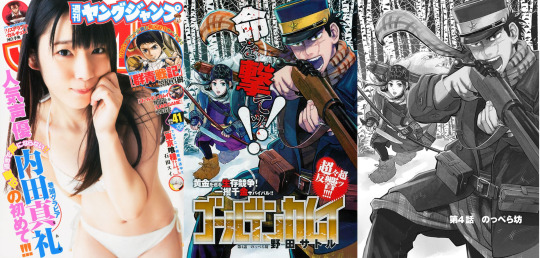
First printed: 11/September/2014 Weekly Young Jump 41
Characters: Sugimoto Saichi (杉元 佐一), unnamed prisoner who was tailing Sugimoto’s group (杉元達を尾行していた囚人 ‘Sugimoto-tachi o Bikō Shite Ita Shūjin’), Hijikata Toshizō (土方 歳三) , Asirpa (アシㇼパ), Wilk (ウイルク), Ogata Hyakunosuke (尾形 百之助)
Location: Near Otaru.
Other Places mentioned: None
Time: 1907/1908 (?) Late February
Historical events mentioned: Pencil introduction in Japan (Meiji era from October 23, 1868 to July 30, 1912)
Includes flashbacks or info about the characters past: Yes, about Wilk.
Info and the characters’ theories about the ‘Noppera-bō incident’, the gold and the escape:
Although the tattoos are worthless on their own, the prisoners split up because the other prisoners just suddenly started killing each other. The prisoner who was tailing Sugimoto’s group had no idea what was going on so he just ran away and since he couldn’t trust anyone he has been laying low all that time. (Source: prisoner who was tailing Sugimoto’s group)
The killing means some of the prisoners must have realized they had to start skinning the other convicts. (Source: Sugimoto)
The guy who came up with the escape plan was a cold, violent bastard, a monster, compared to whom the prisoner who was tailing Sugimoto’s group is just a small time punk and Sugimoto should have seen how had died the greedy soldiers who came after them. (Source: prisoner who was tailing Sugimoto’s group)
Character deaths: Guards that were transporting the prisoners (killed by the prisoners), prisoner who was tailing Sugimoto’s group (Shoot in the head by Ogata Hyakunosuke)
Animal deaths: None
Flashbacks or info about the characters past: None
New Ainu words:
- Makiri: “Knife”
- Menomakiri: “Knife for women”
Food and drinks: None mentioned.
Useful info and points to ponder:
- We will never get the name for the prisoner who was tailing Sugimoto’s group. Maybe it’s a nobody as Shiraishi claimed. Maybe there’s more to discover about him and it will be revealed in the future along with his name.
- The gun Sugimoto is holding is the one the prisoner who was tailing Sugimoto’s group owned and that he likely stole it from the soldiers who were escorting them, as this sort of guns were used by officers in the army (we saw Koito owning one). Nice catch for one who defines himself a small punk but, when Sugimoto will use it, Ogata will assume it’s Sugimoto the one who stole it from an officer, also because they were expensive (22 yen + 100 rounds of ammunition for 3 yen) and normally not given to the soldiers (the officers would buy them themselves). the price was 22 yen (currently around 44,000 yen) and 100 rounds of ammunition for 3 yen (currently around 6,000 yen).
- The scanlations talk of a ‘bloodbath’ but the Japanese version merely says they just started killing each other (Koroshiai sa “殺し合いさ”). Now, even if the Japanese version is tamer, there were 24 convicts and 22 for sure walked out of it just fine (we still don’t know the whereabouts of the last convict) and, even if we assume Wakayama killed the convict whose skin will become the Barato skin during that moment… well, it’s hard to think many tough guys who also were interested in the skins (Hijikata, Ushiyama, Boutarou, Sakamoto) just escaped from him or watched him doing so or let him escape with a corpse (Sakamoto would have reached him). It’s much easier Wakayama killed the poor guys AFTER the convicts have parted ways. The Doylist explanation is the attempted slaughtering was removed from the story, the Watsonian that the prisoner either lied or overreacted to the prisoners attacking each other… or maybe Heita just went rampaging and this impressed him… or they just gave him an hallucination drug… but, as Sugimoto trusted him, he never questioned Shiraishi about why the convicts parted ways.
- Although chapter 2 implied Sugimoto’s plan was to kill the convicts and then skin them it turns out Asirpa agreed to help Sugimoto after he promised her he wouldn’t kill anyone. Her idea was they would just draw down the tattoos instead than skinning the convicts.
- When Asirpa will interrupt Sugimoto, reminding him he promised not to kill people, Sugimoto will claim his plan was only to threaten the convict he would kill him in order to get him to talk, but he clearly never discussed this with Asirpa.
- It turns out Asirpa has good drawing skills even if she has never used a pencil before.
- Asirpa will reveal her father was good with his hands too and this made him popular with ladies. He’s also the one who made her Menomakiri.
- Ainu men craft Menomakiri for the woman they like, so that the woman can look at their work and see how good of a providers they are.
- The prisoner will say the one who tattooed them was called ‘Noppera-bō’ (のっぺら坊 “Person who’s faceless”) because he didn’t have a face. He doesn’t explain how Wilk came to lose his face. Was it through torture? Or was his face the lump of flesh that was found and made people assume he died?
- Ogata was distant 300 meters when he shoot straight in the head the prisoner who was tailing Sugimoto’s group.
- In hindsight if he wanted to kill the whole group Ogata should have shoot Sugimoto first, as the convict couldn’t go anywhere as he was tied, so the fact he shoot him first means he didn’t mean to kill Sugimoto.
- Sugimoto’s first assumption is that Ogata was another convict or, at least, one of his allies.
- Sugimoto acknowledges Ogata is a dangerous adversary which can’t be taken lightly.
- The number on Ogata epaulette is 27 but the 7 is hardly visible in both shoulders.
- In this chapter and in chap 5 there’s light in Ogata’s eyes. There won’t be light in his eyes in the following chapter. A retcon in the character design or it means something?
Notable changes from the magazine version:
- This chapter had a colour cover in the magazine version. In the volume version it has been turned into a black and white one.
Notable quotes:
Prisoner: “It turned into a bloodbath. The other prisoners just suddenly started killing each other. I had no idea what was going on, so I just ran like hell. I couldn't trust anyone, so I've been laying low all this time.” (‘Koroshiai sa. Totsuzen nani no maebure mo nashi ni shūjin dōshi ga koroshiai ni natta. Ore wa wake mo wakarazu nigedashita no sa. Dare mo shin'yō dekine~ekara hitori de senpuku shi teta nda’ 殺し合いさ。突然何の前触れも無しに囚人同士が殺し合いになった。俺は訳も分からず逃げ出したのさ。誰も信用できねぇからひとりで潜伏してたんだ Lit: “They started to kill each other. Suddenly, the prisoners started to kill each other without any notice. I didn't understand the reason and ran away. I didn't trust anyone, so I hid myself.”)
Prisonier: “Those greedy soldiers that came to get us? They were practically teenagers. You should have seen how they died. Listen, buddy. You'd be better off chasing rabbits.” (‘Kinkai ni me ga kuranda gaki mitai ni wakai tondenhei-tachi ga don'na shinizama o shita ka misete yaritakatta ze. Usagi demo okkakete tamauga mi no tameda zo, ni ̄-chan’ 金塊に目がくらんだガキみたいに若い屯田兵たちがどんな死に様をしたか見せてやりたかったぜ。ウサギでも追っかけてたまうが身のためだぞ、にーちゃん Lit: “I’d like to show you in which manner those young military settler colonists died, they were like brats blinded by the gold. It is better for you to chase the rabbits, bro.”)
Sugimoto: “Is that all you’ve got to say? Well, don’t worry… after you’re dead, you won’t feel a thing when I skin you.” (‘Iitai koto wa sore dake ka? Nāni… shinde shimaebahin muka reyouga itami nantenē sa’ いいたいことはそれだけか?なあに…死んでしまえばひん剥かれようが痛みなんてねえさ Lit: “Is that all you want to say? Well… if you die, you won’t feel the pain of being skinned.”)
Asirpa: “Hey, Sugimoto! You promised not to kill anyone! If you kill him, I won’t help you!” (‘Oi Sugimoto-! Korosanai to yakusoku shita hazuda zo! Korosunara watashi wa kyōryoku shinai’ オイ杉元ッ!殺さないと約束したはずだぞ!殺すなら私は協力しない Lit: “Oi Sugimoto! You promised not to kill! I will not cooperate with you if you kill him.”)
Sugimoto: “Asirpa, I was kind of hoping you'd play along. There goes my plan to threaten him and get all his information.” (‘Asirpa-san, soko wa engi shite notte kurenai to. Odoshite iroiro kikidasu tsumoridattanoni’ アシㇼパさん、そこは演技してノッてくれないと。脅していろいろ聞き出すつもりだったのに Lit: “Asirpa-san, here you have to act. I was going to threaten him to get out of him many info.”)
Asirpa: “I like this thing. this "pencil". It's useful.” (‘Sugimoto, kore ī na. Enpitsu tte iu no ka. Benrida’ 杉元、これいいな。鉛筆っていうのか。便利だ Lit: “Sugimoto, this is good. Is it a pencil? It's useful.”)
Asirpa: “Ainu men craft a Makiri and give in to the woman they like. she looks at the craftsmanship and decides how good of a provider that man is.” (‘Ainu no otoko wa sukina on'na ni jibun de hotta makiri (kogatana) o okuru. On'na wa sono dekibae de otoko no seikatsu-ryoku o hakaru nda’ アイヌの男は好きな女に自分で彫ったマキリ(小刀)を贈る。女はその出来栄えで男の生活力を量るんだ Lit: “An Ainu man gives to the woman he likes a carved Makiri (little sword). The woman measures the man's ability as a provider by his craftsmanship.”)
Prisoner: “…Noppera-bou. That's what we all called him.” (‘… Nopperabō sa. Oretachi wa sō yonde ita.’ …のっぺら坊さ。俺たちはそう呼んでいた)
Prisoner: “He didn't have a face” (‘Kao ga nai nda’ 顔が無いんだ)
Ogata: “Sounds like he’s using a type 26 looted off a dead soldier.” (‘Heishi o koroshite ubatta nijūroku nenshiki kyojū ka’ 兵士を殺して奪った二十六年式挙銃か Lit: “A stolen 26 model handgun gotten by killing a soldier?”)
Sugimoto: “I was hoping to take him alive, but this isn't the type of guy I can afford to take lightly!” (‘Ikedori ni suru tsumoridattaga… tekagen dekiru aite janē’ 生け捕りにするつもりだったが…手加減できる相手じゃねえ Lit: “I was going to take him alive… but this isn't an opponent I can afford to take lightly!”)
Box: “The instant they moved apart… the man had pushed down the bolt stop and pulled out the bolt, rendering Sugimoto’s rifle useless” (‘Hanare sai… Shunkan-teki ni jū no waki ni aru borutosutoppā o oshinagara boruto o hikinuki sugi moto no jū o shiyō funō ni shita’ 離れ際… 瞬間的に銃の脇にあるボルトストッパーを押しながらボルトを引き抜き杉元の銃を使用 不能にした Lit: “When they had moved apart… in a moment he had pressed the bolt stop at the rifle’s side and pulled out the bolt rendering Sugimoto’s rifle useless.”)
Sugimoto: “He’s a member of a unit of frontier soldiers chasing after the gold. The unit renowned as the strongest in the army. The Hokkaido 7th division.” (‘Kinkai o otte iru tondenhei no butai rikugun saikyō to utawa reta Hokkaidō no dai nana bumon’ 金塊を追っている屯田兵の部隊。 陸軍最強と謳われた北海道の第七部門 Lit: “A military settler colonist of the unit chasing after the gold. The Hokkaido seventh division, which was claimed to be the strongest in the army.”)
------------------------------------------------------------------------------
05. HOKUCHIN UNIT (北鎮部隊 HOKUCHIN BUTAI)
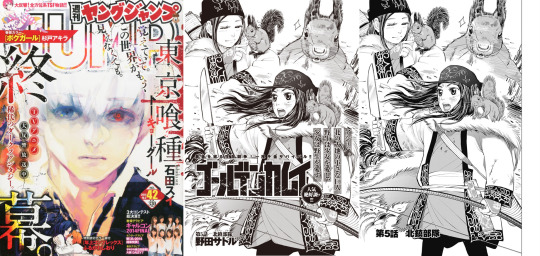
First printed: 18/September/2014 Weekly Young Jump 42
Characters: Sugimoto Saichi (杉元 佐一), Ogata Hyakunosuke (尾形 百之助), Asirpa (アシㇼパ), Tsurumi Tokushirō (鶴見 篤四郎).
Location: Near Otaru.
Other Places mentioned: 203 hill in Port Arthur (current Lüshunkou) (China), Mukden (currently Shenyang) (China).
Time: 1907/1908 (?) Late February
Historical events mentioned: Russo-Japanese war (8 February 1904 – 5 September 1905) Siege of Port Arthur (1 August 1904 – 2 January 1905), Battle of Mukden (20 February - 10 March 1905)
Includes flashbacks or info about the characters past: None
Info and the characters’ theories about the ‘Noppera-bō incident’, the gold and the escape: None
Character deaths: None (although Ogata will be assumed dead)
Animal deaths: None.
New Ainu words:
- Kuca: “Temporary hut”. A cone shaping hut used for short camping trips in the wilderness.
- Citatap: “We mince it”. An Ainu dish.
- Ohaw: Boiled soup
- Pukusakina: Soft wildflower
- Hinna: “Thank you (for the food)”.
Food and drinks: Citatap with squirrel and ohaw in which it’s cooked.
Useful info and points to ponder:
- The name of the ‘Hokuchin Butai’ (北鎮部隊) or “Defeat the north unit” is formed by two kanji. One means ‘north’ and actually refers to Russia, the other means both ‘to calm down/to pacify’ but also ‘to dominate/to subdue’.
- When facing Ogata Sugimoto comments the sniper and his companions are probably “the dregs/failures of the unit” (師団の中のはずれ者 ‘Shidan no naka no hazure-sha’). This is actually wishful thinking on his part.
- When facing Sugimoto Ogata actually asks him “Who are you with?” (きさまどこの所属だ ‘Kisama doko no shozoku da’), which Sugimoto interprets with “Which unit were you with?” when it’s more likely Ogata is interested in knowing with who Sugimoto is working NOW as there were few people aware of the gold hunt, the convicts, the soldiers of the 7th, Inudo’s men and Wilk’s allies. That’s why Ogata relaxes when Sugimoto misunderstands and says he was with the first division but reached the term of his service and was discharged, because he indirectly confirms he’s not affiliated with any group searching for the gold and that’s also why Ogata talks about ‘kane’ (カネ “money”) not ‘kane’ (金 ‘gold/money’ though it seems when it means ‘gold’ the more common pronunciations are ‘kin’ or ‘ougon’ or ‘kogane’ or ‘kigane’)).
- Ogata uses ‘Kisama’ to say you, when talking with Sugimoto. Nowadays it would be considered very offensive, as if he has told him ‘you bastard’. However, up to WW2 it was the normal way soldiers would say ‘you’ among them (and prior to it, it was used by samurai and it was a polite way to say you… in fact it contains ‘-sama’). Hard to say though if Noda is using it keeping this into consideration or not.
- When Sugimoto tells Ogata he was in the 1st division he adds he reached the end of his term of service and was discharged. This doesn’t necessarily mean he was discharged AT THE END OF THE WAR. It seems in Meiji time soldiers were enlisted for 3 years, with them being called to enlist at 20. A recruit entering the Army was given the rank of 2nd-dass private and, as a rule, was automatically promoted to 1st-class private after 6 months so Sugimoto, who goes to was as a first class private, has already spent 6 months in the army. This means it’s possible Sugimoto was 20 in 1903, when he was enlisted (April/July), did his 6 mandatory months as 2nd class private, was promoted to 1st class private and, by February 1904, he was ready to take part to the Russo-Japanese war and would have to stay in the army till 1906. It’s also worth to mention that, although he doesn’t mention it to Ogata, Sugimoto claimed he beat half to death a superior officer. If this is true and wasn’t reconned, this might have affected his time of permanence in the army (prolonging it).
- Once learning Sugimoto was in the 1st division, Ogata wonder if they had met at the 203 hill. While possible, so far we only know that Sugimoto has met Tanigaki during that battle.
- While talking with Sugimoto Ogata scratches the back of his head (the sound effect in the scanlation was removed). Noda might have retconned the gesture into becoming his signature hair petting gesture.
- Sugimoto will reply to Ogata he’s not doing it for money but for the woman he loves [‘Horeta’ (惚れた) can mean “to fall in love”, “to be in love”, “to lose one’s heart to” so he’s clearly not implying just simple fondness]. Ogata will remember this.
- After sending Ogata on the ground Sugimoto breaks his arm and retrieves his bayonet, presses the tip on his neck and then attempts to stab it but Asirpa interrupts him, saving Ogata. Ogata will also remember this.
- When Asirpa calls Sugimoto by name Ogata connects the dots and realizes that Sugimoto of the first division can only be ‘Sugimoto the immortal’.
- Ogata escapes because he’s aware he can’t beat Sugimoto the immortal, especially with a broken arm.
- When Ogata begins to fall Asirpa attempted to reach for him while Sugimoto was surprised. Clearly neither wanted that outcome.
- Ogata falls from a cliff in the frozen river with a broken arm and after hitting his face and breaking his jaw. Sugimoto and Asirpa are above the cliff so they can’t recover him but assume he would die. Ogata managed to reach the riverbank and was found by the 7th division at dusk without him having succumbed to hypothermia. How he managed to do it is considered amazing by the members of the 7th division. People in the fandom speculated he might have received outsider help to survive (maybe from Kiroranke). As of now, if he made it on his own or someone helped him out of the river and then left him on the riverbank is unknown.
- After Ogata falls Sugimoto claims this was for the best and explains to Asirpa that, although he had promised her he wouldn’t kill anyone, if his life is on the line he won’t hesitate to kill. Considering they’re meant to face dangerous convicts Sugimoto had to know he wouldn’t be able to keep the promise when he made it.
- During that speech Sugimoto claims he’s not a murderer (in the scanlations he say “I don’t enjoy killing”) and quotes Asirpa’s line in his speech “The weak gets eaten” (弱い奴は食われる ‘Yowai yatsu wa kuwa reru’) although scanlation changed it in “The strong survive, and the weak perish”.
- Asirpa has several huts in the area.
- Asirpa knows so much about hunting thanks to her father who carried her along in all his hunting trips as she has no male brothers and prefers to be out than knitting at home.
- When Asirpa offers him the squirrel brain and Sugimoto complains he explains his complain not with “it’s all so new to me” but with “I’m not used eating this kind of things”.
- Sugimoto is introduced to ‘Citatap’, ‘Ohaw’ and saying ‘hinna’ to thanks for the food.
- The word ‘Citatap’, when said by Asirpa, is written ‘チタタㇷ゚ ’ with a small ‘pu’ (プ) which implies you’ve to read it ‘citatap’. However when said by Sugimoto (and, in future, when said by the other Japanese members of the cast), it’s written ‘チタタプ’, implying they actually say ‘citatapu’.
- The image of Asirpa and Sugimoto happily having Citatap and saying ‘hinna hinna’ is placed in direct contraposition of Ogata’s bandaged and wrapped up in a cover body. However, although there are voices around him, no person can be seen near him in the page.
- Due to the dialogues of the soldiers we learn that the soldier who attacked Sugimoto is the ‘Superior Private Ogata’. Tsurumi’s troops actually don’t know why Ogata was wandering through the mountains.
- It was impressive how Ogata, despite the wounds, managed to crawl out of the river.
Notable changes from the magazine version:
Notable quotes:
Box: “The 7th division of the Imperial Japanese army. During the Russo-Japanese war, they were sent into the worst fighting during the Siege of Port Arthur and the Battle of Mukden. Despite suffering heavy losses, they were a vital contributor to the Japanese victory. The people of Hokkaido reverently call them the ‘defender of the north unit’. Tasked with defending Northern Japan, they are the strongest unit in the army.” (‘Dainipponteikoku rikugun dainanashidan! Nichirosensōde wa Ryojun kōryaku-sen hōtenkaisen to iu gekisen-chi ni okurikoma re dai songai o dashitsutsu mo shōri ni kōken. Dōmin wa ikei no nen o kome `hokuchin butai' to yobu. Kita no mori o ninau rikugun saikyō no shi kuni.’ 大日本帝国陸軍第七師団!日露戦争では旅順攻略戦・奉天会戦という激戦地に送り込まれ大損害を出しつつも勝利に貢献。道民は畏敬の念を込め「北鎮部隊」と呼ぶ。北の守りを担う陸軍最強の師国。 Lit: “The 7th Division of the Imperial Japanese Army! In the Russo-Japanese War, it contributed to the victory while being sent to the fierce battlefields of the Siege of Port Arthur and the Battle of Mukden, despite suffering great damage. The people of Hokkaido in awe call it the “Hokuchin Unit”. It’s the army's strongest division responsible for the protection of the north.”)
Ogata: “What unit are you from?” (‘Kisama doko no shozoku da’ きさまどこの所属だ Lit: “Who are you with?”)
Sugimoto: “I was in the 1st division… though I reached the end of my service term and was discharged.” (‘Dai ichi shidan itaga konaida manki jotai shita’ 第一師団いたがこないだ満期除隊した Lit: “I was in the 1st division… though I reached the end of my service term and was discharged.”)
Ogata: “Oh, really? Then maybe we saw each other at 203 hill. Listen, you’d be better off handing that corpse over to us. It would be a shame to survive the war and then throw your life away over some money. I don’t think you understand what a dangerous game you’re playing.” (‘Sō ka? De wa nimarusan kōchi-atari de atte ita kamo shiren na. Sakki no shitai wa otonashi ku kochira ni Watari shitahōgaī ano sensō de hirotta inochi wa kane ni kae raren zo. Dore dake kiken'na bakuchi ni te o dashite iru no ka wakatte oran noda’ そうか?では二◯三高地あたりで会っていたかもしれんな。さっきの死体はおとなしくこちらに渡した方がいい。あの戦争で拾った命はカネに換えられんぞ。どれだけ危険な博打に手を出しているのか分かっておらんのだ Lit: “Really? So maybe we meet at 203 hill. The corpse of before, you should quietly give it to me. The life you picked up in that war cannot be exchanged for money. You don't know how dangerous of a gambling this is.”)
Sugimoto: “It’s not for money. It’s for the woman he loves.” (‘Kane janē. Horeta on'na no tameda’ カネじゃねえ。惚れた女のためだ Lit: “Not for money. For the woman I fell in love with.”)
Sugimoto: “During the war, I figured out the trick to staying alive. You don't let anybody kill you. I don't enjoy killing… but if my life is on the line, then I won't hesitate to kill whoever I need to. the strong survive, and the weak perish. It's a universal truth isn't it?” (‘Ore ga sensō de mananda shinanai hōhō wa hitotsu sa. Korosa renai kotoda. Asirpa-san ore wa satsujin-kyō janai…de mo korosa reru kurainara chūcho sezu korosu. Yowai yatsu wa kuwa reru. Doko no sekai mo sore wa onajidarou?’ 俺が戦争で学んだ死なない方法はひとつさ。殺されないことだ。アシㇼパさん俺は殺人狂じゃない…でも殺されるくらいなら躊躇せず殺す。弱い奴は食われる。どこの世界もそれは同じだろう? Lit: “During the war there's one lesson I learned in order not to die. You can’t let anybody kill you. Asirpa-san, I’m not a murderer… but if my life is on the line, then I won't hesitate to kill whoever I need to. The weak gets eaten. It’s always the same no matter where you are, isn't it?”)
Asirpa: “And what is that supposed to mean? Do you have a problem with Ainu cuisine?” (‘Dōiu imida? Watashitachi no tabekata ni monkude mo aru no ka?’ ��ういう意味だ?私たちの食べ方に文句でもあるのか?Lit: “What do you mean? Is it a complaint for our way of eating it?”)
Sugimoto: “Err, N-No…No problem at all. It's just all so new to me…” (‘A … iya sōiu tsumori janai datte ore sō iu no tabe nare tenaishi’ あ…いやそういうつもりじゃないだって俺そういうの食べ慣れてないし Lit: “Ah... No, I don't mean that, I'm not used to eating that kind of thing.”)
Asirpa: “Citatap means "We mince it." It's because we all take turns mincing that we call it Citatap.” (‘Citatap wa wareware ga (ci) kizamu (tata) mono (p) to iu imida. Kōtai shinagara tatakukara `wareware'Na nda’ チタタプは我々が(チ)刻む(タタ)もの(プ)という意味だ。交代しながら叩くから「我々」なんだ Lit: “Citatap means we (chi) mince (tata) it (p). It's "we" because we take turns hitting it.”)
- Asirpa: “Hinna, hinna! ” … “It's what we Ainu say to show appreciation for the food. We say it as we eat.” (‘Hinna hinna’ … ‘Shokuji ni kansha suru kotoba. Watashitachiha tabenagara iu nda’ 「ヒンナヒンナ」「食事に感謝する言葉。私たちは食べながら言うんだ」 Lit: “Hinna, hinna! They’re words to say thank you for the meal. We say them while eating.”)
- Soldiers: “We found him on the riverbank at dusk. Any later and he would have succumbed to hypothermia. Frankly, I’m amazed he was able to crawl up onto the bank with those injuries.” (‘Yūgata ni ni kawagishi de mitsukemashita. Hakken ga mōsukoshi osokereba tei taion-shō de shinde itadeshou. Kono kega de yoku kishi made hai agatta monodesu’ 夕方にに川岸で見つけました。発見がもう少し遅ければ低体温症で死んでいたでしょう。この怪我でよく岸まで這い上がったものです Lit: “We found him on the riverbank in the evening. If it was discovered a little later, he would have died of hypothermia. Despite these injuries he still somehow managed to crawl on the shore.”)
------------------------------------------------------------------------------
06. PERSECUTION (迫害 HAKUGAI) 25/SEPTEMBER/2014 WEEKLY YOUNG JUMP 43

First printed: 25/September/2014 Weekly Young Jump 43
Characters: Sugimoto Saichi (杉元 佐一), Asirpa (アシㇼパ), Shiraishi Yoshitake (白石 由竹), Wilk (ウイルク), Umeko (梅子), Umeko’s mother, Toraji (寅次)
Location: Near Otaru.
Other Places mentioned: Kabato prison in Tsukigata
Time: 1907/1908 (?) Late February
Historical events mentioned: None
Includes flashbacks or info about the characters past: Yes, about Sugimoto, Toraji, Umeko and about Shiraishi.
Info and the characters’ theories about the ‘Noppera-bō incident’, the gold and the escape: None.
Character deaths: None
Animal deaths: Hare (killed by Asirpa… if not right then in the next chapter)
New Ainu words:
- Nipus hum: “The sound of trees splitting”. It’s a phenomenon where a sudden, extreme drop in temperature causes the sap inside trees to freeze and the trunk to split open.
Food and drinks: Hare.
Useful info and points to ponder:
- Same as when they caught the previous prisoner here too, when Sugimoto claims they caught the second prisoner he uses ‘hikime’ (匹目) which is the counter for ‘small animals’ not for ‘people’. So he’s basically saying they got the second small animal. The trap seems the same they used for the previous convicts and for squirrels, though now it also looks like the one for hares.
- When questioned, Shiraishi, differently from the previous prisoner, refused to speak. At this point Sugimoto asked him if he’s keeping silent because his throat was crushed by the trap (‘Wana de nodo tsubureta ka’ 罠でノドつぶれたか), showing he knew their trap could be dangerous.
- Shiraishi’s reply to Sugimoto is actually based on a racist joke as he asks him if ‘that Ainu’ is his ‘kai inu’ (pet dog) since the word ‘Ainu’ and ‘kai inu’ sound similar and Japanese used to call Ainu dogs due to the following wordplay アッ、イヌ (“ah, inu” meaning “ah, a dog”) sounding like the word ‘Ainu’. Shiraishi is clearly trying to insult Sugimoto, who has referred to him as well as an animal, asking him if he also consider Asirpa too as an animal (normally Shiraishi never refers to Ainu in such a rude manner) but, of course, since Sugimoto doesn’t view her as such, he thinks he’s insulting Asirpa. At the same time his reaction shows a certain hypocrisy. He’s not okay with people he loves being called animals but he’s fine with doing so to the convicts.
- Asirpa, stopping Sugimoto from hurting Shiraishi, points out how she’s used to hear such things so she doesn’t care anymore. Sugimoto complies but thinks ‘where’s the need to get used to it?’ (‘Nareru hitsuyō ga doko ni aru’ 慣れる必要がどこにある), which, combined with his attempt at hurting Shiraishi hints at his disapprobation of Asirpa’s passive and non violent stance, thinking it would have been right to beat Shiraishi up or, at least, scare him into silence. He doesn’t get though that if Asirpa got used to it, is because way too many Wajin do those racist comments and that if she were to use violence or threats like him to make them stop she would end up at war with them as he won’t spend the rest of his life beating up whoever were to insult Asirpa. He’s missing the full picture and not really looking forward to an Ainu rebellion besides, when Asirpa in the future will consider not being passive anymore, he’ll insist others should fight in her place. Sugimoto means well but he is of no help whatsoever. It’s a bit like when he complained Ainu should have just let him kill their prisoner. He means well but he wants to butt in into things without a full picture, claiming his methods are better even if, at least, he doesn’t force them.
- After thinking there’s no need to get used to it, Sugimoto’s mind, by association, goes back to his past, to how his family got infected with tuberculosis and ostracized by the village while Umeko, the person he loves, is told to keep away from him. As three of his relatives dies and his father ends in a sanatorium, people started suggesting to just burn his house down. It’ll be Sugimoto who’ll burn it down one night, when he’ll hear his father died. Umeko will reach him and he’ll tell her he burned the house and will leave the village, while she should just marry their childhood friend Toraji who has liked her from when they were child and who’s also liked by Umeko’s parents. Umeko begs him to carry her with him but he refuses, running away in fear he could be infected as well. He however thinks to wait two years and, if he’s not sick he’ll come back for her, implying he planned to marry her then. However, when he comes back, he sees her dressed in a nuptial kimono also called Shiromuku kimono (白無垢, lit. "white pure-innocence") with her Wataboshi (綿帽子, lit. "cotton hood"), an all-white hood up, about to get married to Toraji.
- Umeko calls Sugimoto ‘Saichi-chan’ while Sugimoto calls her ‘Ume-chan’.
- Sugimoto claims he would feel bad if he were to scare the hare… a hare he would have tried shooting down if it weren’t hidden.
- Shiraishi was originally imprisoned for robbery but after repeatedly escaping and being imprisoned again his sentence for escaping became far longer than the original one for robbery. Since he’s a genius at escaping he’s nicknamed the “Escape king” (Datsugoku-ō 脱獄王). He’s able to easily dislocate any of his joint and can hid all over his body needles, wires, a razor blade and even a bullet.
- Shiraishi is sure Sugimoto wants to kill him, which is what pushes him to not cooperate with him, no matter if Sugimoto has him at gunpoint or if them both could die. He accepts to work with him only when Sugimoto promises him he won’t kill him.
Notable changes from the magazine version:
Notable quotes:
- Sugimoto: “There’s prisoner number two!” (‘Ni hikime’ 二匹目一匹目! Lit: “Second small animal!”)
- Sugimoto: “What, did the trap crush your windpipe?” (‘Wana de nodo ga tsubureta ka?’ 罠でノドがつぶれたか?Lit: “Did your throat get crushed by the trap?”)
- Shiraishi: “I see you have your very own pet Ainu. Does she do any tricks?” (‘Sono Ainu wa omae-san no kai inu ka?’ そのアイヌはお前さんの飼いイヌか?Lit: “That Ainu is your pet dog?”)
-Sugimoto: “How about I smash your jaw, and make it so you really can't speak?” (‘Ago o kudaite hontōni shi ~yaberaren'younishiteyarouka’ アゴを砕いて本当にしゃべられんようにしてやろうか Lit: “Shall I crush the jaw so that I can speak really?”)
- Asirpa: “Stop it, Sugimoto. It doesn't bother me. I'm used to people saying things like that” (‘Yose Sugimoto. Watashi wa kinishinai, nare teru’ よせ杉元。私は気にしない、慣れてる Lit: “Stop, Sugimoto. I don't care, I'm used to it.”)
- Sugimoto: “But you shouldn't have to get used to it!” (‘Nareru hitsuyō ga doko ni aru’ 慣れる必要がどこにある Lit: “Where is the need to get used to it?”)
- Sugimoto: “You know, Toraji… he’s a good, dependable guy. And he’s liked you since we were kids. I know I can count on him to take care of you. You should listen to your parents and marry him.” (‘Toraji wa… majimede ī yatsuda. Chīsai koro kara omae o sui teru. Aitsunara makase rareru. Goryōshin no susume ni shitagaubekida’ 寅次は… 真面目でいい奴だ。小さい頃からお前を好いてる。アイツならまかせられる。ご両親の勧めに従うべきだ Lit: “Toraji is… a serious and good guy. He love you since he was little. I can entrust you to him. You should obey to your parents’ advices.”)
- Umeko: “Saichi! Take me with you!” (‘Saichi-chan tsuretette!’ 佐一ちゃん連れてって!)
- Sugimoto: “I don’t want to kill you, Ume.” (‘Ume-chan o koroshitakunai’ 梅ちゃんを殺したくない)
- Sugimoto: “I’ll wait a year… no, two years. If I don’t show any symptoms in that time, I’ll come back to the village. I’ll come back for her, and then…” (‘Ichinen… iya ni-nen tatte. Hasshō shinakere wa kono mura ni modotte koyou. Kanarazu mukae ni…’ 一年…いや二年経って。発症しなけれはこの村に戻ってこよう。必ず迎えに… Lit: “One year ... no two years from now. Let's return to this village if the symptoms don’t appear. I’ll certainly come to pick you...”)
- Shiraishi: “Pull the trigger, then! Getting shoot now or getting shot later makes no difference to me!” (‘Yatte miro ~tsu. Kotchi wa ima uta reru no mo ato de uta reru no mo isshoda’ やってみろッ。こっちはいま撃たれるのもあとで撃たれるのも一緒だ Lit: “Try it. It’s the same to be shot now or to be shot later.”)
------------------------------------------------------------------------------
07. THE ESCAPE KING (脱獄王 DATSUGOKU-Ō)

First printed: 02/October/2014 Weekly Young Jump 44
Characters: Sugimoto Saichi (杉元 佐一), Shiraishi Yoshitake (白石 由竹), Asirpa (アシㇼパ), Hijikata Toshizō (土方歳三), Gotō (後藤), Wilk (ウイルク), Ogata Hyakunosuke (尾形 百之助), Tsurumi Tokushirō (鶴見 篤四郎), Tsuyama (津山).
Location: Near Otaru.
Other Places mentioned: None
Time: 1907/1908 (?) Late February
Historical events mentioned: Founding of Nippon Match Company (日本燐寸製造株式会社) (January 1907), Battle of Hakodate (4 December 1868 to 27 June 1869), Death of Hijikata Toshizō (20 June 1869)
Includes flashbacks or info about the characters past: No, none
Info and the characters’ theories about the ‘Noppera-bō incident’, the gold and the escape:
The tattooed prisoners are 24 but nobody knows how many are still breathing. The leader who took care of the escape is the only one who knows something about Noppera-bō’s friends. During the escape he pulled a sword from one of the soldiers and killed three of them immediately. (Source: Shiraishi)
Noppera-bō told to all the prisoners to head for Otaru. (Source: Shiraishi)
Character deaths: Guards that were transporting the prisoners (killed by the prisoners, 3 by HIjikata only)
Animal deaths: None.
Flashbacks or info about the characters past: Yes, about Hijikata.
New Ainu words: None
Food and drinks: Hare.
Useful info and points to ponder:
- The matchbox from which Sugimoto pulls out the match seems to be from the Nippon Match Company (日本燐寸製造株式会社) which was established on January 1907.
- Due to being wet and the sudden cold Sugimoto and Shiraishi have only 10 minutes before they’ll succumb to hypothermia.
- On a weird note Shiraishi’s adventure kind of parallel’s Ogata, only it’s much tamer. Ogata will have his jaw broken, while Shiraishi was only threatened to have his jaw broken. Asirpa stopped Sugimoto from killing Ogata, and stopped him from hurting Shiraishi. Ogata ends in a river and has to get himself out of it, risking hypothermia. Shiraishi falls in the river with Sugimoto and, although they both risk hypothermia they cooperate to save each other. Noda has said he originally planned Shiraishi to be a one-off character but it’s clear he changed his mind pretty soon. I guess I’ll never stop wondering how Shiraishi’s story would have been if he had stuck to the original plan.
- Shiraishi seems to be affected by the cold more than Sugimoto, even if, despite this, he still manages to make a deal with him, also thinking if he’s going to die no matter what he prefer sit there and watch Sugimoto die and won’t help him until he’ll agree with to make a deal. Once they’ll do though, not only he’ll help Sugimoto but he’ll also give him information.
- Although Sugimoto will claim he didn’t want to kill Shiraishi, just to keep him captive until they find the gold, he’ll hesitate making a deal with him.
- It’s worth to mention the idea to keep captive an assorted number of potentially very dangerous convicts for a prolonged time was beyond unbelievable.
- When Shiraishi will give Sugimoto info he won’t report how the convicts tried to kill each other nor if one of them died during it. He only say nobody knows if they’re still alive.
- Shiraishi says previously leader who took charge of the escape had been a model prisoner and all though he was a political one but he believes this was all a act. Shiraishi later found out he was a samurai who fought for the Shogunate and ended up on the losing side of the battle of Hakodate in which he was thought to have died and that he is Hijikata Toshizō also known as the “Demonic vice-commander” (‘Oni no Fukuchō’ 鬼 の 副長) of the Shinsengumi.
- The battle of Hakodate happened 30 years ago. During which Hijikata Toshizō supposedly died.
- Shiraishi refers to Hijikata first as ‘Jī-san’ (ジイさん) then, as he talks about him after the escape as ‘jijī’ (ジジイ). They both mean “old man/grandfather” but the first is more respectful than the latter which will be the one to which Shiraishi will stick.
- When Shiraishi moves to leave in the scanlations Sugimoto says next time they’ll meet he’ll take his tattoo. Actually the sentence is more vague because it’s just ‘the next meeting time’ (次に会うとき ‘Tsugini au toki’) without saying with whom Shiraishi could have that meeting so it can imply ‘the next time you meet ME’ or ‘the next time you meet SOMEONE ELSE’ those someone else being the other prisoners or the 7th division about which he warns Shiraishi moments after. Sugimoto after all has no reasons to go after Shiraishi as they have made a copy of his tattoo and he’s warning him to escape, meaning he’s not really planning to go after him. However he could have left the ambiguity to persuade Shiraishi to escape.
- When Sugimoto warns Shiraishi about the 7th division being after the convicts, he tells him they know the most efficient method to do it is to kill and skin them. This hints that even if Sugimoto agrees with Asirpa not to kill prisoners, he thinks it’s not an efficient way.
- We can’t see the soldier who informs Tsurumi of how Ogata regained consciousness. In the anime he has Tsukishima’s voice.
- Tsurumi says he’ll pay Ogata a visit.
- Behind Tsurumi we can see a tattooed skin hanging from a wall as if it were a painting.
Notable changes from the magazine version:
- Tsurumi’s character design was changed. In the magazine he has light in his eyes and the metal place covering his forehead is much bigger and also partially circles his eyes.

Notable quotes:
- Sugimoto: “Damn it! I am not giving up! No matter what, I'll make it out of this alive!” (‘Chikushō ~tsu! Akiramenē zo! Zettai ikinuite yaru’ 畜生ッ!あきらめねえぞ!絶対生き抜いてやる)
- Shiraishi: “We thought he was just some old guy, a political prisoner. He was always real quiet. A model prisoner in every way. But as it turns out, that was all an act. Keep in mind that this is only a rumor, but…apparently, everyone thought that old man had died at the battle of Hakodate, but…he's actually the merciless vice commander of the shinsengumi, Hijikata Toshizou!…or so they say.” (‘Tan'naru seiji-han no jī-sanda to omotteta. Otonashī mohan-shū sa. Tokoroga dokkoi neko kōmutte ya gatta. Kore wa akumade uwasadaga ne… ano jijī wa hakodatesensō de senshi shita to iwa re teru… shinsengu no oni no fukuchō hijikata toshizō datte….’ 単なる政治犯のジイさんだと思ってた。大人しい模範囚さ。ところがどっこい猫被ってやがった。コレはあくまで噂だがね…あのジジイは箱館戦争で戦死したと言われてる…新選組の鬼の副長・土方歳三だって…)
- Sugimoto: “The next time we meet, I’m taking your tattoo.” (‘Tsugini au toki wa sono irezumi o hippegasu ze’ 次に会うときはその入れ墨を引っぺがすぜ Lit: “The next meeting time, that tattoo will be ripped off.”)
- Shiraishi: “I'm the Escape King! even if I'm caught, I'll just vanish like a puff of smoke.” (‘Ore wa “datsugoku-ō”da. Dare ni tsukamarouga kemuri no yō ni nigete yaru sa’ 俺は『脱獄王』だ。誰に捕まろうが煙のように逃げてやるさ Lit: “I'm the "Jailbreak King". No matter who catches me, I escape like smoke.”)
------------------------------------------------------------------------------
VOLUME COLOR GALLERY

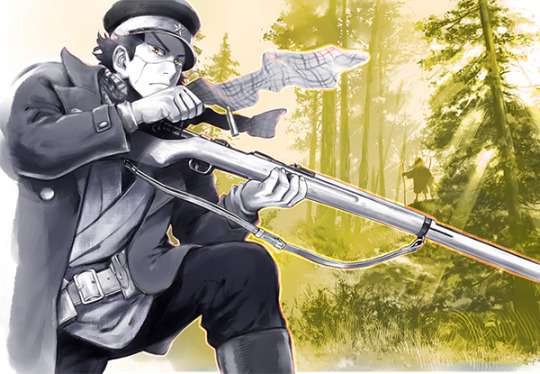


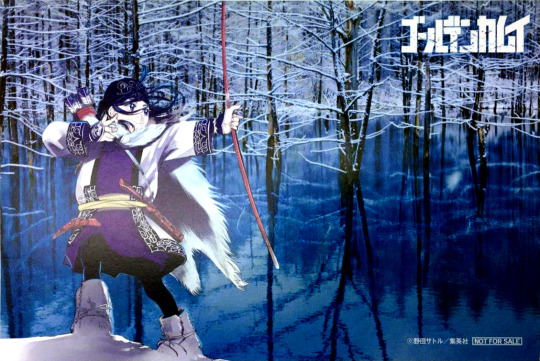
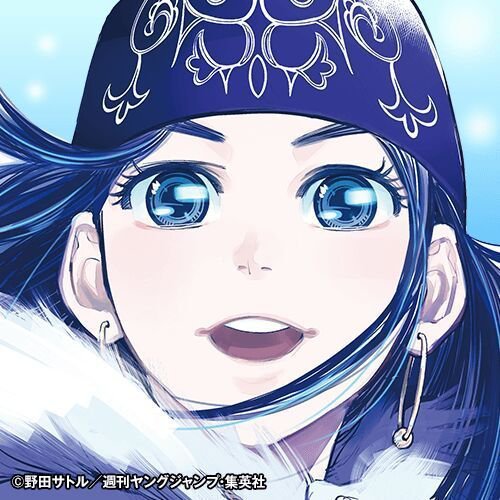
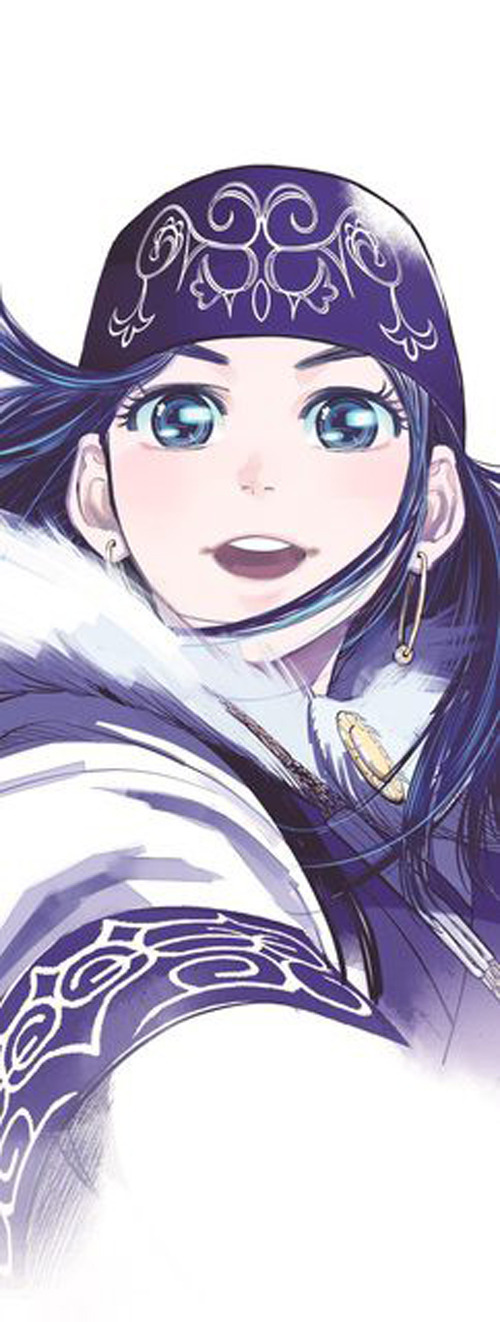
#Golden Kamuy#Sugimoto Saichi#Asirpa#Ogata Hyakunosuke#Shiraishi Yoshitake#Tsurumi Tokushirou#Wilk#Retar#Golden Kamuy Data Hunting#Gotou Takechiyo#Kenmochi Umeko#Kenmochi Toraji#Tsuyama Mutsuo#Kasahara Kanjirou
19 notes
·
View notes
Text
1118
Have you ever visited your country’s capital city? Yes. I was born in Manila and even lived there for a short while. But I don’t like going there anymore as I find it too icky, stinky, and depressing. It has come very far from its glamour days in the 50s until the 80s, and not in a good way. If you’re going to make a trip to the Philippines, go to literally anywhere but Manila.
What are your plans for next Thursday? Next Thursday is actually a holiday here, so I’d want to spend that day catching up on rest, ignoring work, and simply staying in.
When was the last time you were outdoors for over an hour? Last Friday when I went out with Angela and a few other friends. A bar in Katip announced that they were going to permanently close by the end of the month - another pandemic victim - so we went there to have a bit of a good time before they’re gone for good.
What is the shortest amount of time you’ve lived somewhere? My parents and I only lived in Manila for a year. By the time I was 2, we had moved in with extended family in the city I currently live in.
What’s your favorite kind of mint? (Peppermint/wintergreen/spearmint/etc) Mentos has a spearmint flavor that’s my favorite, so I’ll go with spearmint.
What was the last thing to frustrate you? I watched an interview with one of the last living Filipino comfort women who, as a teenager, had been raped by the Japanese during WWII. The Japanese’s way of dealing with their history is very infuriating – AKA they choose not to deal with it at all and act like nothing happened. I also learned that the Filipino government removed a statue we used to have that was meant to be dedicated to our comfort women, because the Japanese threatened to defund some of our projects if we didn’t have it removed. Everything about this is frustrating but most of my hatred is geared toward the Japanese government, both past and present.
What was the first movie you ever went to see in theaters? Stuart Little 2.
Do you do volunteer work, or have you ever done any in the past? I haven’t. I wanted to start volunteering for PAWS after I graduated college, but then Covid happened and so those plans fell through. These days, I help by donating P100 every week to my shelter of choice.
Have you ever been to a bachelor or bachelorette party? Never been. None of my friends have gotten married yet, and once they have plans to I’m not sure if they’d be the type to throw this kind of party. In fact, I don’t actually know if bachelor/ette parties are a thing here...it’s definitely not a standard Asian tradition, I can tell you that much.
Did any of your family members serve in WWII? My great-grandfather did, though I’m not exactly sure what his rank was. He was also given the Congressional Gold Medal Award for his efforts in 2018. My military-hating ass will always be in conflict because I hate the idea of war and sending people off to participate in it, but I’m also proud of my great-grandpa.
What’s your favorite kind of salad? Spicy freaking tuna salad. I really want to order one today, but I already spent so much on food last week :/
Are you more realistic or idealistic? I am realistic towards myself, but I appreciate people who can be idealistic or keep being the least bit optimistic. I feel like the people I surround myself with is also crucial to the mindset I end up molding.
Do you have a home security system? Yes, his name is Finn. Statistically alarms like him are far more effective than the techy kind ;) < Ahahaha, same. Cooper’s very handy. Kimi’s going blind so he only barks when he hears Cooper start to bark, I guess as kind of a moral support hahaha.
Have you ever been to Ohio? Nope, and I’ve never been to that country at all.
Are you currently borrowing something from someone? I have Andi’s vape pen. I’m thinking of just buying it from him, to be honest, because I see myself using it for the long-term. I also still have several of Athenna’s books that she had lent me all the way back in high school, but I never got to return because she distanced herself from me and Angela.
Is anyone currently borrowing anything from you? I don’t think so. I’ve lent books before but they’ve since returned them.
What is your last name’s heritage/country of origin? Spanish and Portuguese.
When did you last buy a new pair of shoes? What kind? September. They were kitty heels meant for the first job interview I ever scored.
Is your car paid off, or do you make payments? I think it’s paid off. I’ve never heard my parents talk about having to make payments for it.
Have you ever experienced culture shock while traveling? If so, where?
China: People will stare and point at you while clearly talking about you with their peers. It was incredibly unsettling at first, but in the end I just powered through and ignored it no matter how irritating it felt.
South Korea: Apparently you can’t take photos in public?? I was trying to take a photo of this silly mannequin, but the stall owner shooed me away. This was my own fault, though, and I should’ve done more research before I pulled my phone out.
Japan: Bus drivers turn the bus’s engine off when at a stoplight. That was a pleasant surprise. And of course, the people there are incredibly nice. At one point we asked this couple how to get to a certain museum, and in no time we were surrounded by a literal large crowd who just wanted to help me and my parents.
Indonesia: The dizzying amount of motorcycles on the road.
Are you able to see the stars at night where you live? Yes. Even though we live close to the city, I’m glad we get a lot of stars.
Do you include your middle initial in your signature? No. My signature is the first letter of my name + the last letter of my surname in a very lazy scrawl.
What brand of computer do you have? Apple.
What operating system does that computer run? Mac OS and I am too lazy to check which particular one.
Have you ever had gumbo? I don’t think so. Looks appetizing though.
What’s the oldest piece of clothing that you still own and wear? Some dresses and pants from like the 6th and 7th grade that can still be appropriate for some occasions, but I keep them at the very back/bottom of my closet because I rarely have to pull them out.
Do you have a passport? Yes.
How many miles are on your car? Mid-30,000s.
Have you ever been to an estate sale? Nope.
How many relationships have you been in? I’ve been with one person, though we dated twice
Have you ever had Greek yogurt? I don’t think so? I’ve only tried yogurt once, not sure if it had been Greek yogurt, but anyway I absolutely hated it and have refused to consume yogurt since.
Is the area in which you live flat, hilly, or mountainous? I live in the flatter part of the city, but we have a mountainous part as well of which we have a view from here.
1 note
·
View note
Text
PyeongChang 2018 - 6-minutes warm-up before SP by NHK
Translation post 28
Original language: Japanese
Translator’s note: This is not a word-for-word translation. I paraphrased some of the things said in the broadcast to clarify the main point.
Announcer: Takaki Toriumi. He has been working for NHK since early 90’s and done play-by-play announcement for NHK Trophy many times.
Commentator: Takeshi Honda. Former single skater. Two-time Olympian and World bronze medalist. First 4CC champion and six-time national champion. He is also the first Japanese skater who landed a quadruple jump in a competition. He is now coaching in Osaka. He had been training in Ice Rink Sendai in early 90’s with Shizuka Arakawa.
(Hanyu standing-by at the rink-side)
Toriumi: The last six skaters are about to start skating. On November 9th, he suffered a severe injury in his right ankle and had to stay off the ice for two months. He resumed training at the beginning of this year, and we had been worrying if he would be able to come back in time for this Olympics, but Mr. Honda, he is back.
Honda: Yes, and in very good form.
Toriumi: Indeed. He arrived in Korea on 11th, which is five days ago and has been training since the next day in this main rink or the practice rink in the basement. At the press conference, he firmly assured that he had done what he had to do and had no worries. How do you feel about his comment?
Honda: Since the quality of his jumps is pretty good, he probably has a good feeling about his skating, and that enables him to believe that he can compete, I guess.
(Hanyu going over his jumps in his head pointing at the ice)
Toriumi: He injured his right ankle. The right foot is the landing foot for figure skaters... I mean, for Yuzuru Hanyu here. There must be a considerable strain put on his right ankle, but in practice, he has been landing quads beautifully enough to make us wonder if he ever had been injured.
Honda: Yes.
Toriumi: So, we are very curious about how much he is ready, in terms of his intuition for skating in competition as well.
(The camera captures the skaters standing behind Hanyu)
Toriumi: Now, the camera is capturing Nathan Chen. We can also see Kolyada and Shoma Uno behind him. Here is Javier Fernandez, and here is another skater, Boyang Jin of China. Well, Mr. Honda, this is going to be an extraordinarily fierce competition, isn't it?
Honda: I agree. This is going to be a high-level competition since everyone in this final group has surpassed 100 points in the past.
Toriumi: Yes...
(Hanyu patting on his body to stimulate his muscles)
Toriumi: This is his first official competition in nearly four months. How is Yuzuru Hanyu going to skate...
(PA announcer calls the skaters onto the ice)
Toriumi: The final group is taking the ice! Yuzuru Hanyu was the first one who got on the ice.
(PA announcer introduces Hanyu)
Toriumi: He received the loudest cheers so far today, Yuzuru Hanyu.
(PA announcer introduces Chen)
Toriumi: A phenomenal quad jumper, Nathan Chen.
(PA announcer introduces Kolyada)
Toriumi: He competes in this Olympics as an Olympic athlete from Russia, Mikhail Kolyada.
(PA announcer introduces Uno)
Toriumi: It’s Shoma Uno.
(PA announcer introduces Fernandez)
Toriumi: The only thing he hasn't got yet is an Olympic medal, Javier Fernandez.
(PA announcer introduces Jin)
Toriumi: Boyang Jin of China. We'll definitely be able to see his quad today as well.
Toriumi: The six skaters started their 6-minutes warm-up. The camera is now capturing Yuzuru Hanyu of Japan, the gold medalist from the Sochi Olympics aiming to win two-consecutive titles here. The short program today is the first step to the second gold medal. Now, Mr. Honda, he is likely to attempt a quad/quads in this warm-up.
Honda: I think so too. Since he is going to skate first, it's about time for him to start jumping...
(Hanyu lands 1A)
Toriumi: What do you think about his skating order?
Honda: Skating first in the group can be beneficial for him as he can go into his performance maintaining the feeling he gets during the warm-up. Hanyu said that he liked to skate first, so I think he can confidently...
(Hanyu lands 4T+3T Rippon)
Toriumi: Ah, he jumpted.
Honda: It was a quad-triple combination, beautifully landed.
(Hanyu goes back to his coaches to keep himself hydrated)
Toriumi: Yuzuru Hanyu has just landed a quad-triple combination in the warm-up. Coach Brian Orser is also keeping an eye on him.
(Nathan Chen skating along the boards)
Toriumi: This is Nathan Chen of America. In the Team Event, he made unexpected mistakes in the short program. How much has he gotten back into the swing of things in a week after that?
(Nathan lands 4F)
Toriumi: He's already got a bronze medal in the Team Event. When it comes to quad jumps, people think of Chen.
(Kolyada lands 1A)
Toriumi: Now, this is Kolyada, an Olympic athlete from Russia. Mikhail Kolyada is competing in this competition as an individual from Russia.
(Kolyada lands 2A)
Toriumi: Mikhail Kolyada is planning to do a quad Lutz, which has the highest base value among quads.
(Uno going into a jump)
Toriumi: Now, this is Shoma Uno of Japan.
(Uno lands 2F)
Toriumi: In the short program in the Team Event, he scored over 100. Mr. Honda, what's your take on how he has been doing since then, including in the practice sessions?
Honda: I think he has had good practices. I mean, he looked the same as always, exchanging smiles with his coach, so I think his condition is not bad.
Toriumi: In the Team Event, he scored 103.25 in the short program and finished 1st in the segment.
(Uno lands 4F)
Toriumi: He is planning to include two quads in the short program. Will he manage to land these jumps?
(Coach Mihoko Higuchi talking to Uno, smiling)
Toriumi: Now, we are seeing coach Mihoko Higuchi. After the short program in the Team Event, Shoma Uno commented that he had been more nervous in Nationals. (t/n: than in TE)
(Fernandez skating towards Brian Orser)
Toriumi: This is Javier Fernandez of Spain. He is the two-time world champion and has won six European titles in a row, but has yet to win an Olympic medal. Just like Yuzuru Hanyu, he is training under Coach Brian Orser. This is his third Olympics. (t/n: to Honda,) What is your take on Javier Fernandez?
(Brian Orser and Tracy Wilson following Fernandez with their eyes)
Honda: Well, he looks good in the warm-up. His movements are very sharp.
(Boyang Jin skating along the boards)
Toriumi: Here is Boyang Jin of China. Recently, he won in Four Continents Championships beating Shoma Uno, scoring over 100 in the short program. He arrived in PyeongChang as he got himself in gear.
(Hanyu going over his opening quad)
Toriumi: Hanyu is going to skate first, right after this warm-up. According to his planned contents, he is going to open his program with a quad loop but...?!
(Hanyu lands 4S)
Honda: That was a quad Salchow.
Toriumi: Yes, it was Salchow... Is he going to alter it to this Salchow?
Honda: I think so.
(Hanyu goes back to his coaches to keep himself hydrated)
Toriumi: He will probably attempt the quad Salchow as his opening jump and then quad-toe-triple-toe combination in the second half of the program. He said that he had done the absolute best he could do before coming here and wanted to do his best. (t/n: in this competition) He is thinking very positively, isn't he?
Honda: Yes, indeed. Well, he said that even when he could not skate, he could do off-ice training well enough. So, he has done what he could do for this Olympics.
(Hanyu starts skating again)
Toriumi: He explained about the time off-the-ice saying that he could not get on the ice for two months, but he had a lot to figure out, so the time off-the-ice wasn't meaningless.
(End of 6-minutes warm-up)
Toriumi: Now, 6-minutes warm-up has ended.
(Hanyu goes over the Salchow for one last time and goes back to the coaches)
Toriumi: Now is the time to fight. The reigning Olympic Champion, Yuzuru Hanyu. He suffered a severe injury. Now, how has he recovered?
21 notes
·
View notes
Text
2019 Cup of China Overview
PREVIEW - MEN | PREVIEW - LADIES | PREVIEW - PAIRS | PREVIEW - ICE DANCE | PREDICTIONS
Entries: http://www.isuresults.com/events/fsevent03111930.htm Results: http://www.isuresults.com/results/season1920/gpchn2019/ Live stream: ISUSkating YouTube Channel (geoblocked), NBC Sports Gold (geoblocked), more information here.
We are on to week four of the Grand Prix Series, and we are at the Cup of China. Back after not being held last year, it goes to Chongqing.
Schedule
Nov. 8: Rhythm Dance 15:30; Ladies’ SP 17:10; Men’s SP 19:05; Pairs’ SP 21:00 Nov. 9: Free Dance 14:30; Ladies’ FS 16:30; Men’s FS 18:45; Pairs’ FS 21:00
Withdrawals and Replacements
In the Men’s event, Vincent Zhou of the US withdrew due to personal reasons and was replaced by Conrad Orzel of Canada. Roman Savosin of Russia withdrew and was replaced by Brendan Kerry of Australia.
In the Ladies event, Mai Mihara of Japan withdrew due to health reasons and was replaced by Kailani Craine of Australia. Elizabet Tursynbeava of Kazakstan withdrew due to an injury and was replaced by Young You of South Korea. Viveca Linfords of Finland and Gabrielle Daleman of Canada were late withdrawals and were replaced by Amber Glenn of the US and Yujin Choi of South Korea respectively.
GP Debuts
In the Men’s event, Chih-i Taso of Chinese Taipei will be making his GP debut, along with Conrad Orzel of Canada. In the Ladies event, Hongyi Chen and Yi Zhu of China both make their GP debuts, and Zhu will be making her Senior International debut. Yujin Choi of South Korea also makes her debut.
In the Ice Dance event, Yuzhu Guo and Pengkun Zhao of China make their GP debut.
Grand Prix Final Qualification
In the Men’s event, both Camden Pulkinen and Keegan Messing have an outside shot of qualifying - they would both need to win, though. In the Ladies event, Anna Shcherbakova and Elizaveta Tuktaymsheva of Russia go up against each other again. Shcherbakova needs to just medal, while Tuktamysheva needs to win, though silver would at least put her in contention. Young You has an outside shot of qualifying - while she’d need a win, a second-place finish would put her into contention.
In the Pairs event, Cheng Peng and Jin Yang only need to medal to qualify for the Final. In the Ice Dance event, Maidson Chock and Evan Bates of the US have the most solid shot at qualifying - they need to place at least second to do so, and should surely do better than that his week. Laurence Fournier-Beaudry and Nikolaj Sorenson of Canada have an outside shot. While they’d need to win to secure a qualification (which isn’t happening), they can place second and put themselves into contention.
7 notes
·
View notes
Text
My People, My Country (2019)

I'm certain My People, My Country will snag all the awards at China’s equivalent of the Oscars. Jingoistic to the point of being sickening, every frame is spent forcefully celebrating the People’s Republic of China and enforcing government-approved values. Perhaps it would mean more to someone who lives there. For this viewer, it was a profoundly dull - though eye-opening - 158 minutes. Each of this anthology's seven stories come from a different director and feature some of the country’s biggest stars in a variety of roles and genres. There's a lot to say so pardon the longer-than-usual review.
The Eve
Engineer Lin Zhiyuab (Huang Bo) is floored when he learns Tian'anmen Square is being cordoned off before the founding ceremony of the People’s Republic of China on October 1, 1949. As the man responsible for the mechanism that will automatically raise the flag, he must now find a way to anticipate and address any possible issues - without setting eyes upon the flagpole.
Well, doesn't this sound like an exciting intro to a 2-1/2 hour movie? Immediately, you recognize this is a propaganda film. This means it'll be an interesting viewpoint into the engineer's way of thinking... but not the way they meant it to be. Like all propaganda films, this one presents its subject as all-good, all-powerful and forever successful. The lack of tension serves to make the story even less dramatic than it would’ve been normally. It's too short for you to get invested in the characters and the story is one you simply can't be bothered for.
Passing By
In 1964, China is developing nuclear weapons. Scientist Gao Yuan (Zhang Yi) has not seen his wife (Zhou Dongyu) for three years. An incident at work nearly causes a meltdown, forcing Gao to intervene and put his life at risk.
If my country announced it was developing nuclear arms, I’d be outraged; not waving flags and singing songs. Even if your sentiments towards mutually-assured destruction differ, you'll leave this tale flabbergasted. Once we get into the drama between Gao and his wife, it’s a sweet love story. Then, the details hit you. The scientist’s fate is left ambiguous, as the story ends with the country’s victorious display of power. Anyone who knows anything knows only three things come from nuclear tests gone wrong: Superpowers, giant fire-breathing dinosaurs, of agonizing death. I guess we’re supposed to admire the man's dedication to his country, at the expense of his marriage and life?
The Champion
Dongdong (Han Haolin) and his father own the only television in their small village. It’s 1984 and China’s women’s national volleyball team is playing for the gold medal against the United States. While he holds the antenna in place, the village can view this historic match. Dongdong is torn, however. His school friend is moving away. If he doesn’t say goodbye to her tonight, he’ll never have the chance to tell her how he feels.
Of all the stories, this was my favorite. Dongdong wants to step away from the antenna but there are always circumstances pulling him back towards it. It’s got small-town charm and some laugh-out-loud moments… until you begin thinking about the story's real message. It’s the Olympics, sure, but Dongdong is supposed to give up his happiness because he dares to have a little luxury at home?
Going Home
Directed by Sue Xiaolu, Going Home follows a watch repairman tasked with coordinating two watches. The timekeepers will be worn by officials overseeing the ceremony commemorating the return of Hong Kong from British rule to China in 1997.
Yet another mundane story detailing a flag-raising ceremony. With The Champion still in mind, this one seemed even more tedious than it would’ve been otherwise. It takes itself seriously - to a fault. The only time you'll be jolted out of your stupor will be when you spot the actors lovingly gazing at those five yellow stars on that red flag. Seriously, the flag plays such a big role in so many of these stories I wouldn’t be surprised if it got first billing in the end credits - I couldn't read them so I can neither confirm nor deny my suspicion.
Hello Beijing
Deadbeat dad and taxi driver Zhang (Ge You) wins a ticket to the 2008 Beijing Olympics’ opening ceremony. Thinking he can use it to gain the admiration of his son, he flaunts his prize. When the ticket is stolen by one of his fares, he panics.
Like The Champion, Hello Beijing has a more comedic tone than the rest, which is a breath of relief. You take great delight when Zhang realizes his ticket has been swiped. It's an opportunity for him to redeem himself and he does, in a way that’ll make you roll your eyes. By the time the thief’s emotional speech comes in, you're practically nauseous.
The Guiding Star
Two brothers (Liu Haoran and Arthur Chen) are taken in by a kind, elderly couple. Initially planning on robbing them, the boys change their ways when a childhood story of a falling star seen during the day is fulfilled in the form of the Shenzhou 11’s landing capsule.
The longer I go on with this anthology, the less I have to say. This is a basic story. There’s nothing wrong with that, as long as you mix it up a bit. Tying the country’s space program to a prophecy that goes on to change two nogoodniks’ lives? puh-lease.
One for All
Fighter jet pilot Lü Xiaoran (Jia Song) has fought tooth-and-nail to be the best. When she is assigned to be the backup pilot for the Military Parade of the 70th Anniversary of the Victory in the Second Sino-Japanese War, she is initially outraged. As the big event approaches, she learns the importance of setting her ambitions aside.
We started off with a boring story. It's only fitting to conclude with another. The training sequences are cool and the shots of those jets zipping through the air are exciting but by this point, you know what agenda director Wen Muye is pushing onto you and your defenses are robust. There’s no way you'll let One for All "win" and you look down upon it with disdain.
Overall, the film is well made. The cinematography is grandiose, the landscapes majestic, the performances good. I simply couldn't look past the messages being pushed. Give up three years of your life, the chance to say goodbye to your friend, your lifelong ambitions. Do it for your country. Don't expect to be recompensed for your sacrifice; are you crazy?! Take joy in the sight of that flag, the symbol that ties us all together and makes everyone, from the lowliest thieves to aspiring engineers part of a bigger whole whose collective needs far outweigh the inconvenience of a few. Let's throw in a couple of subtle potshots towards the U.S., Japan, and the United Kingdom for good measure too. I didn't want to say too much in my summaries of the stories, but almost all of these take the corniness to an insufferable level. There's overwrought drama abound, the conclusions always go for the cheapest tricks and worst of all, you'll be bored. There’s so much to learn from My People, My Country that I'm glad to have seen it but found it more frightening than inspirational. (Original Chinese with subtitles on the big screen, October 7, 2019)

#MyPeopleMyCountry#My People My Country#movies#films#reviews#movie reviews#film reviews#film criticism#kaige chen#hu guan#hao ning#muye wen#zheng xu#xialo xue#yibai zhang#huang bo#zhang yi#ren suxi#wu jing#du jiang#ge you#liu haora#arthur chen#song jia#2019 movies#2019 films
4 notes
·
View notes
Text
Apollo 11 brought a message of peace to the Moon - but Neil and Buzz almost forgot to leave it behind
by Michelle L.D. Hanlon

President Richard M. Nixon welcomes the Apollo 11 astronauts aboard the USS Hornet, the recovery ship for the mission, where they are quarantined. From left to right: Neil A. Armstrong, Michael Collins and Edwin E. Aldrin. NASA
“How about that package out of your sleeve? Get that?” is certainly not the most famous phrase uttered by a human while on the Moon. And the items nestled in a small packet that astronaut Buzz Aldrin had stowed in the pocket just below the shoulder of his extravehicular mobility unit were certainly not mission critical. They were sentimental objects, intended to be left on the Moon purely for symbolic and commemorative purposes.

Apollo 15 astronauts David R. Scott and James B. Irwin left a commemorative plaque on the Moon in memory of 14 NASA astronauts and USSR cosmonauts. The tiny, man-like object represents the figure of a fallen astronaut/cosmonaut. NASA
More than one hundred sites
You may be surprised to learn that a partial catalog of human-made objects on the Moon fills more than 20 single-spaced pages. There are more than a hundred sites on the Moon with evidence of human activity. The sites contain materials from the European Space Agency, Japan, India, Russia, China and the United States. Not only do these sites contain ongoing experiments, they hold invaluable data. For example, engineers are hoping to examine these materials to determine how they have fared after continuous exposure to the elevated radiation levels on the Moon. Along with scientific equipment, robotic landers and other objects left behind to lighten the load for the return home, there are a number of memorial and tributary items.
But perhaps most important, these varied objects, and their position on the lunar surface, alone can reveal the true story of humanity’s history on the Moon. A chronicle which celebrates the persistence and passion of hundreds and of thousands of scientists, engineers and aviators throughout human history who have supported the effort to “slip the surly bonds of Earth” and reach the stars.
I am not a historian. I am a space lawyer and have made it my mission to develop the laws we need to protect historic artifacts and sites in space. I co-founded For All Moonkind, the only organization in the world dedicated to preserving human heritage in outer space, to assure that archaeologists, historians, scientists and tourists are given the opportunity to learn the valuable lessons of our past.
Messages of peace
Buzz Aldrin and fellow Moonwalker Neil Armstrong chose to go to the Moon with an Apollo 1 patch. It was selected to honor the ultimate sacrifice of astronauts Gus Grissom, Ed White and Roger Chaffee, who perished in a fire during the first test of the Apollo command and service module. The astronauts also chose to remember their fallen Soviet competitors and carried with them two Soviet medals, honoring cosmonaut Vladimir Komarov, who died in the Soyuz 1 spacecraft in 1967 and Yuri Gagarin, the first man to orbit the Earth, who was killed in an aircraft in 1968. Aldrin and Armstrong understood that even as Americans raced the Soviets to the Moon, success would be shared by all.
That’s why they also carried a small gold olive branch – a global symbol of peace – and a silicon disk about the size of a United States half dollar. Inscribed on this disk in microscopic text are messages from the president of the United States and leaders of other 73 nations solicited by Thomas Paine, then head of NASA. The messages, intended to be left on the Moon for posterity, are poignant, proud and congratulatory. Some speak of their own national heritage, others salute the courage of the three humans who strapped themselves into a rocket and catapulted into the unknown. From Afghanistan to Zambia, the messages have one common theme: peace.

The Apollo 11 lunar module shows the stainless steel dedication plaque. The signatures are of the three Apollo 11 crew members and President Richard Nixon. NASA
Neil Armstrong’s favorites
According to his biographer, James Hansen, Neil Armstrong identified three favorite messages. The president of Costa Rica hoped the Moon landing would produce “new benefits for improving the well-being of the human race.” The king of the Belgians remained “deeply conscious of our responsibility with respect to the tasks which may be open to us in the universe, but also to those which remain to be fulfilled on this Earth, so to bring more justice and more happiness to mankind.” Finally, the president of the Ivory Coast asked that the first human messengers to the Moon “turn towards our planet Earth and cry out how insignificant the problems which torture men are, when viewed from up there.”
I personally find the message of the president of Mexico rather prescient as he noted “in 1492, the discovery of the American Continent transformed geography and the course of human events. Today, conquest of ultraterrestrial space – with its attendant unknowns – recreates our perspectives and enhances our paradigms.” He went on to remind that human migration to space carries with it “a new far reaching responsibility.”

The figure shows a gold replica of an olive branch, a traditional symbol of peace, an Apollo 1 patch and a silicon message disk. NASA
Forgotten?
Space historian Tahir Rahman, who has published an award-winning book that tells the full story of the Messages of Peace, recounts that Aldrin and Armstrong nearly forgot to leave the disc and other mementos on the lunar surface. Indeed, according to NASA records and transcripts, it wasn’t until the Moonwalkers were climbing back into their spacecraft for the return journey to Earth when they realized their oversight. At the last minute, the disc was tossed from the ladder and settled in the regolith without pomp or circumstance. Once in the capsule, Armstrong verified that “the disk with messages was placed on the surface as planned.”
The mystery is not that these busy astronauts almost forgot to leave the disc behind. After all they were pretty occupied being the first humans to set foot on the Moon. I think it is strange that the two most popular films about Apollo 11 released in the last year, “First Man” and “Apollo 11,” make no mention of the disc and its moving and hope-filled messages.
On July 20, 1969, the world united to celebrate the most remarkable technological achievement in human experience. And in that celebration, our leaders focused on our common hope for peace. This is the lesson of humanity’s effort to reach the Moon. I believe this is the history that we must embrace. It is our responsibility to explore space in peace, together as a species.
Let’s not forget, or forsake, the lessons of our past. The first step is to protect the sites which chronicle our history on the Moon. And hopefully, along the way we can recapture the goodwill that Neil and Buzz left behind.

About The Author:
Michelle L.D. Hanlon is Professor of Air and Space Law at the University of Mississippi
This article is republished from our content partners at The Conversation under a Creative Commons license.
19 notes
·
View notes
Text
We’re celebrating July 4th with the ALAN Review article entitled “Where Are They Now? Remembering Our Most Popular Young Adult Authors.”

An article written by Don Gallo appeared recently in the Summer 2019 issue of The ALAN Review entitled “Where Are They Now? Remembering Our Most Popular Young Adult Authors.” Among those remembered were four authors with whom I worked very closely during my years at HarperCollins and, with Don Gallo's and the ALAN Review's permission, I'm including those remembrances on the Balkin Buddies blog:
Here they are in the order they appeared in the article:
Paul Zindel [Tied for first place with S.E. Hinton in 1988]*
Paul Zindel's death in March 2003 ended the brilliant career of a unique individual. Not only did he win a Pulitzer Prize for Drama and an Obie Award for Best American Play in 1970 for The Effect of Gamma Rays on Man-in-the-Moon Marigolds (1965), but he was also one of the earliest writers in the field of contemporary literature for young adults. The Pigman, published in 1968, is still one of the most well-known and widely taught novels in the genre. He followed The Pigman with My Darling, My Hamburger (1969); Pardon Me, You're Stepping on My Eyeball (1976), The Undertaker's Gone Bananas (1978); Harry and Hortense at Hormone High (1984); and other novels with attention-getting titles. His writing revealed how well he understood teenagers, believing that “adolescence is a time for problem-solving – for dealing with the awesome questions of self-identity, responsibility, authority, sex, love, God, and death” (Gallo, 1990, p. 228).
In addition to Gamma Rays, this versatile author wrote a number of other plays, including And Miss Reardon Drinks a Little (1971) and Ladies at the Alamo (1975), as well as a number of movies and television scripts that include Up the Sandbox (1972), starring Barbara Streisand; Mame (1974), starring Lucille Ball; Runaway Train (1985), starring Jon Voigt; Alice in Wonderland and Through the Looking-glass (1985), with a cast of 50 stars that included Red Buttons, Ringo Starr, Scott Baio, and Shelley Winters; Babes in Toyland (1986), starring Drew Barrymore and Keanu Reeves; and A Connecticut Yankee in King Arthur's Court (1989), starring Keshia Knight Pullman. During those years working in Hollywood, Zindel associated with numerous movie and television actors and became good friends with Walter Matthau who lived in the house next door.
In his later years, Zindel, always knowing what would appeal to teen readers, turned from realistic fiction to monster/horror books, such as The Doom Stone (1996), Rats (1999), and Night of the Bat (2001) – all of them filled with suspense and action and all selected as Quick Picks for Reluctant Young Adult Readers.
Zindel reveals a lot about himself in his 1987 autobiographical novel, The Amazing and Death-Defying Diary of Eugene Dingman, except that the fictional Eugene grows up in Bayone, New Jersey, while Paul grew up on Staten Island, New York. Of his teen years, Paul says bluntly: “I was an awkward freak.” More about Zindel's early life, family, and adventures can be found in his autobiography, The Pigman and Me (1992), which was named one of the 100 Best of the Best Books published for teenagers during the last part of the twentieth century. In 2002, the American Library Association bestowed upon Paul Zindel the Margaret A. Edwards Award for lifetime achievement, and later that same year, he was presented with the ALAN Award for his contributions to young adult literature.
M. E. Kerr [Tied for fourth place with Robert Cormier and Katherine Paterson in 1988]*
Writing under the pseudonym of M. E. Kerr, Marijane Meaker was one of the earliest authors to gain notoriety in the YA publishing world with Dinky Hocker Shoots Smack!, published in 1972. Among her 20 popular novels are Is That You, Miss Blue? (1975), I'll Love You When You're More Like Me (1977), Gentlehands (1978), Him She Loves? (1984), Night Kites (1986), the Fell series (1987, 1989, 1991), and Deliver Us from Evie (1990). Kerr has always chosen to write about differences in people, “understanding them....trying to make sense of it all, never losing sight of the power love lends.”
In an interview published in Teenreads, she explains her motives: “I was very much formed by books when I was young....I was a bookworm and a poetry lover. When I think of myself and what I would have liked to have found in books those many years ago, I remember being depressed by all the neatly tied-up, happy-ending stories, the abundance of winners, the themes of winning, solving, finding – when around me it didn't seem that easy. So I write with a different feeling when I write for young adults. I guess I write for myself at that age” (“M. E. Kerr).
Marijane Meaker began her career in publishing after she was unable to sell any of her stories to magazines. She presented herself as Ms. Meaker, a literary agent with six clients, and sent out her own work under various pseudonyms, male as well as female. One was a middle-aged female teacher writing true confessions (at $300 a story); another was a young college woman selling to magazines, such as Redbook and Ladies Home Journal; a third “author” told a story, titled “I Lost My Baby at a Pot Party,” about her child wandering from a house where a saleslady was pitching Teflon pots. Along the way, a Gold Medal Books editor convinced her to write a novel about sorority life, for which she earned $4,000 a book at a penny a word. This very resourceful writer also published two or three adult mysteries a year under the name of Vin Packer, and other novels were penned as Ann Aldrich and Laura Winston. Her books for children are published under the name Mary James. “A lot of my stories,” she says, “sold well enough for me to enjoy trips to Europe, an apartment off Fifth Avenue in New York City in the 90s, and a Fiat convertible.”
M.E. Kerr's novels for teens have won multiple awards, including a Christopher Award in 1978, a Golden Kite Award from the Society of Children's Book Writers and Illustrators in 1981, a California Young Readers Medal in 1992, the Margaret A. Edwards Award from the American Library Association in 1993 for her lifetime contribution to young adult literature, the Knickerbocker Award for Juvenile and Young Adult Literature in 1991, the ALAN Award in 2000, and the Golden Crown Literary Society Award for her groundbreaking works in the field of lesbian literature in 2013. In 1996, Long Island University awarded her an honorary doctorate.
A collection of her short stories for teens – dealing with dating, love, race, bigotry, homosexuality, self-love, and acceptance – titled Edge, was published in 2015. And Highsmith: A Romance of the 1950s, a memoir recounting Meaker's relationship with famous mystery writer Patricia Highsmith, was published in 2003. Still writing at the age of 91, Meaker recently completed a novel about gay life in New York City during the 1940s and how she became a literary agent for her own work. It's titled Remind Me, based on the lyrics of an old song from that time written by Jerome Kern and Dorothy Fields (1940): “Remind me / Not to find you so attractive / Remind me that the world is full of men.
Katherine Paterson [Tied for fourth place with Robert Cormier and M. E. Kerr in 1988]*
Born in Qing Jiang, China, in 1932, the middle daughter of missionary parents, Katherine Paterson has lived in a variety of places, from Tennessee, Virginia, Maryland, and New York City to China and Japan, where she was a Presbyterian missionary. She now lives in Montpelier, Vermont.
Her highly regarded novels include The Sign of the Chrysanthemum (1973), Of Nightingales That Weep (1974), Master Puppeteer (1975), and Rebels of the Heavenly Kingdom (1983), but she is known best for Bridge to Terabithia (1977), which won the Newbery Medal in 1978; The Great Gilly Hopkins (1978), which won the National Book Award in 1979; Jacob Have I Loved (1980), which won the Newbery Medal in 1981; and Park's Quest (1988), which made The Horn Book Fanfare Honor List in 1988. Published in 1996, Jip, His Story won the Parents' Choice Story Book Award and the Scott O'Dell Award for Historical Fiction in 1997. In 2006, Bread and Roses, Too won the Christopher Award and was a Bank Street Best Children's Book of the Year, a Notable Social Studies Trade Book for Young People, a Parents' Choice Gold Medal historical fiction book, and one of Voice of Youth Advocate's Top Fiction for Middle School Readers.
Paterson has also authored several autobiographical books about her writing, including Stories of My Life (2014), and is a coauthor of Consider the Lilies (Paterson & Paterson, 1986), a nonfiction book about various plants of the Bible that she wrote with her husband, John.
Over her long writing career, Paterson has also received a long list of awards for her body of work. Among them are the Kerlan Award from the University of Minnesota (1983), the ALAN Award (1987), the Hans Christian Andersen Medal for Writing (1998), the Astrid Lindgren Memorial Award (2006), the Laura Ingalls Wilder Award (2013), and the Massachusetts Reading Association Lifetime Award, along with writing awards from Germany, France, and Sweden. In 2000, she was declared A Living Legend by the Library of Congress, and for 2010-2011, Paterson was the US Ambassador for Young People's Literature. She is also the recipient of more than a dozen honorary degrees, including ones from Vermont College of Fine Arts, the University of Maryland, Hope College, and Washington and Lee University.
Paterson's latest novel is My Brigadista Year (2017), set in Cuba in 1961 during the literacy campaign that made Cuba a fully literate nation in one year.
Robert Lipsyte
The author of The Contender (1967) turned 80 years old this spring, as his ground-breaking novel passed the 50-year mark in print. Lipsyte is also the author of One Fat Summer (1977), Summer Rules (1981), The Brave (1991), The Chemo Kid (1992), The Chief (1993), and Raiders Night (2006) for teens, and for young readers, The Twinning Project (2012). Lipsyte's list of publications for teenagers isn't especially lengthy when compared to those of some authors who have been writing for the same length of time, but that's because writing books for and about teenagers is only one kind of work he has done especially well. He has also published a number of short stories, essays about sports issues, and biographies of several sports celebrities, such as Muhammad Ali, Jim Thorpe, and Michael Jordan, as well as several nonfiction books for adults, including Nigger, with Dick Gregory (1964), the African American satirist; Sportsworld (1975/2018); and Idols of the Game (1995). As the author of The Contender, one of the very first realistic novels about contemporary teenagers, Robert Lipsyte was honored with the Margaret A. Edwards Award by the American Library Association in 2001.
And that's not all. Among other things, Robert Lipsyte has been a highly respected columnist and prize-winning sports reporter for The New York Times, a correspondent for the CBS television program Sunday Morning with Charles Kuralt; the host of his own award-winning television interview program, The Eleventh Hour, on New York City's public television station, WNET Channel 13; author of a television documentary series about sports; and the Life (Part 2) series for PBS-TV on subjects of interest to older people. He is also the author of an entertaining memoir, titled Accidental Sportswriter (2011).
In addition to speaking at a lot of high schools, Lipsyte recently has been flying to North Carolina for a week at a time to teach at Wake Forest University, which he says he enjoys very much. He continues to write a monthly column, mostly on local politics, for his hometown weekly, The Shelter Island Reporter, which he says “gives me as much pleasure as the old Times' column.” He also occasionally writes about sports and politics for a site called Tomdispatch, which distributes to a batch of leftish publications like The Nation and The Guardian. If that's not enough, after his cameo on the O.J.: Made in America documentary film (Edelman, 2016) that won an Oscar, he gets called often to pontificate on various TV documentaries, most recently on one about Sonny Liston, three on Muhammad Ali (including one by Ken Burns), and another on that “hard year” 1968.
Meanwhile, this very busy author has been promoting the film, Measure of a Man (Scearce, 2018), starring Donald Sutherland, based on One Fat Summer, Lipsyte's 1977 novel about a bullied teen. View the trailer at https://trailers.apple.com/trailers/independent/measure-of-a-man/. “I have toyed with a new YA novel,” he claims, but where will he find the time?
*Based on the list of 169 authors' names Mr. Gallo sent to 41 present and past officers of ALAN in 1988, asking them “to identify the most important and popular YA fiction writers of the time and to add other names of writers they felt were as important.” Due to space limitations, he “limited this investigation to the top 30 authors included on that 1988 list.”
The ALAN Review Summer 2019
Reprinted with permission from the ALAN Review and Don Gallo.
I hope you enjoyed this excerpt and get to read the entire article. Personally, I feel honored to have worked with such incredibly talented authors as well as with all the amazing people at ALAN.
For information on Balkin Buddies, be sure to visit our website or blog.
Catherine Balkin, Balkin Buddies
#ALAN Review#don gallo#paul zindel#M.E. Kerr#marijane meaker#katherine paterson#robert lipsyte#pulitzer prize#obie award#quick picks for reluctant young adult readers#margaret a. edwards award#alan award#kerlan award#christopher award#golden kite award#California Young Readers Medal#knickerbocker award#golden crown literary society award#Parents Choice Gold Medal#Parents' Choice Story Book Award#newbery medal#national book award#scott o'dell award#hans christian andersen medal#laura ingalls wilder award#patricia highsmith#donald sutherland#charles kuralt#new york times#eleventh hour
2 notes
·
View notes
Text
THE JAPANESE CONTRIBUTION TO GRAPHIC DESIGN HISTORY
Firstly, it’s important to understand that graphic design in Asia is practiced from a commercial perspective. Culturally, graphic design does not have the greater sense of being ‘important’ to society that it has in the Western First World. Due to this, design salaries in Japan are a lot less substantial compared - the average pay for a Graphic Designer in Tokyo is ¥2,473,008 per year. (PayScale, July 2018) However, has Japanese graphic design always been undervalued in such a manner, or simply underrepresented in design history? How have the Japanese contributed to graphic design as we know it today?
Frazer, J (1996) suggested that whilst adhering to its own distinctive artistic traditions, Japanese graphic design was nevertheless influenced by Western styles, trends and fashions - the most influential being art moderne, or art deco. This was due to the the Iwakura Tomomi Mission of 1871 which had a huge impact on the arts in Japan. A group of government officials traveled all over the US and Europe and they brought back over 500 foreigners to assist in the ‘westernisation’, many of them taught arts and crafts subjects at Tokyo University. The overall aim was to cater towards the western ideals/market at the time. F. Marinetti (1909) published The Futurist Manifesto in Paris but within the same year, it was translated in Japanese. This suggests that European Constructivism and Western design had an influence on Japanese design however, they combined it with traditional Japanese art theory. For example, the Japanese tradition of family crests (Known as Kamon) inspired many Japanese designers’ approach to trademark design. Mitsubishi’s logo is suggestive of the three-leaf crest of the Tosa Clan, Yataro's first employer, and also of the three stacked rhombuses of the Iwasaki family crest. (Mitsuibishi Electric, no date)
Modernism in Japanese commercial design flourished between World War I and II. Communication design became increasingly popular in this era and was accepted by the general public. From the late 1920s to the mid-1930s, Japan was a rapidly growing industrial state with a growing consumer culture that relied increasingly on commercial art to promote and sell its products. The evolution of graphic design as a discipline was deeply rooted in Japan's industrialisation and the growth of the modern city, and the urban consumer's needs for advertisements. (Guilty Novin Blogspot, no date)
In the little documentation of Japanese design history, it is often more than not addressing how the West impacted their design, but does not look at the Japanese designers who influenced the West. Gihachiro Okayama was a prolific visual artist who did not have one set style. He began his career in the late 1920’s designing woodblock prints for commercial purposes. Although block printing originated in China, the method was widely used throughout the entirety of Asia. From 1923 to 1933, he studied with Ishii Kendo, learning about the traditions of Japanese printmaking and ukiyo-e. His work included posters and advertisements for the Japan Wool Company and Nikka Whiskey, as seen on the left. The approach appears to be child like, with a caricature and hand-drawn typography but it was instantly recognisable as it stood out considerably from other poster designs at the time. In 1931, Okuyama founded the Tokyo Advertisement Art Association.
Around the same period, Yusaku Kamekura was also a highly relevant designer and he was known to have paved the way for Japanese graphic design. He was a previous student of the Institute of New Architecture and Industrial Arts - a private institute established and run by Renshichiro Kawakita with the aim of introducing Bauhaus design theories in Japan. He then started his design career at the publishing company Nippon Kaupapu. Two years after his first one-man show, he organised the Graphic '55 exhibition at the Takashimaya department store, introducing design into the vocabulary of the populace. Five years later he helped gather Japan’s aspiring graphic designers into the Japan Advertising Artists Club. Less than a decade later he hosted the World Design Conference. Following this event, he co-founded the successful Nippon Design Centre, pairing corporations and designers in a unique and uniquely progressive and productive organisation. In 1978 he was a founding member in the Japan Graphic Designers Association.
Kamekura was known for combining the influences of the Bauhaus with his traditional heritage (Design Is History, no date). The Bauhaus, Constructivism, the Art Deco posters of A.M. Cassandre -- all exerted a profound influence over Kamekura (Yusaku Kamekura Blogspot, February 2006). His poster proposals for the 1964 Tokyo Olympics won several national and international design awards is a perfect example of that. The Olympics represented more than just athletes and gold medals, for the first time ever since their WWII defeat, the world was looking at Japan - the Land of the Rising Sun. As seen on the right, the posters were simple but with these minimalist designs, Kamekura instigated Japan into the post-war design elite. After his death in 1997, Japan Graphic Designers Association (JAGDA) honoured Kamekura in 1999 with a design award in his name, recognising him as a key leader of the association.
Alongside Kamekura, Yokoo Tadanori’s work is also considered to have shaped Japanese graphic design. Traversing the world between art and design, Tadanori Yokoo's work has a very personal nature and often reflects his own interests. (Design Is History, no date) He has embraced an enormous variety of media from book design, swatch watches to painting.
His works alludes to an eccentric array of movements including but not limited to, Surrealism, Dada, Russian Constructivism, American Pop Art, contemporary Japanese popular culture and traditional Japanese art forms. He was considered to be apart of the 1960s pop culture and often unfairly described as the “Japanese Andy Warhol” but Yokoo's complex and multi-layered imagery is intensely autobiographical and entirely original. However, popular critics at the time were largely undermining of Japanese Pop Art, and considered many Japanese designers to be imitating work of the West. The large difference being that in the West, printed works are produced for artistic contemplation or fictional purposes, rarely both. Yokoo is considered to belong in the unclear overlap between art and design. As the art critic Yasushi Kurabayashi (Design Observer, no date) wrote, “Yokoo’s posters are not designed around conventional poster-like ideas. Rather his posters have been executed from his own desire for creative expression, with little regard for cognitive clarity or message.” His style is about his own desires, visions, fears and spirituality. He works for himself; the client is only secondary.
Designer Shigeo Fukuda was known for his bare poster designs with logo-like simplicity. He experimented with perspective, negative space and the visual and geometric cohesion between elements on the poster. His trademark style using a limited colour palette developed from an early interest in Swiss graphic design and influence of the West. Unlike other Japanese designers at the time, he like things to be minimalistic.
Much of his work was designed to make a social impact rather than a commercial one and he was a strong advocate for pacifism and environmentalism. Shigeo once told Idea Magazine that ‘I believe that in design, 30 percent dignity, 20 percent beauty and 50 percent absurdity are necessary’ (Design Is History, no date) . His most famous design was the satirical poster, “Victory 1945,” showing an airborne black artillery shell aimed directly at the opening of the cannon barrel from which it was shot. He was the first Japanese designer to be inducted into the New York Art Directors Club Hall of Fame.
One thing to note, when looking through the scarce Japanese graphic design history, like the West, it was still largely dominated by men. Eiko Ishioka was however, a revolutionary female Japanese graphic designer. She continued to pursue her career although her father (also a graphic designer) warned that she would struggle in a male-dominated culture. (The Telepraph, 2017) Ignoring the advice, she began working with the cosmetics company Shiseido. Her work became noticed however when working for the Japanese department store Parco. She became famous for adverts that seemingly had little relation to the company. Her most famous, a 90-second advert, featured the actress Faye Dunaway wearing black and eating a hard-boiled egg while staring at the camera. The letters P-A-R-C-O then played across the screen at the end. The advert is seemingly trying to say “I even look fabulous eating a hard boiled egg whilst wearing Parco”. Ishioka then branched out into costume design and art direction, one of her most memorable contributions was being directer of costume design for the opening ceremony of the Beijing Olympics in 2008.
In conclusion, Japanese design history is available but unfortunately it’s scarce. UAL library search for example came up with just a handful of books in total especially compared to the Western counterparts. Their influence and importance was largely ignored or unrecognised partially due to the fact that at the time, they didn’t recognise their design work to be of much importance commercially compared to the Western world but also because of the ignorance in the industry itself which only valued the typical work from a western male ignoring both other ethnicities and sex. Unlike female designers, the Japanese haven’t had a movement behind them to advocate for their importance and equality within the industry. However, that’s not to say it isn’t changing as in contemporary society we are fortunately beginning to celebrate and appreciate diverse cultures and giving credit for our influences wherever it’s due.
3 notes
·
View notes